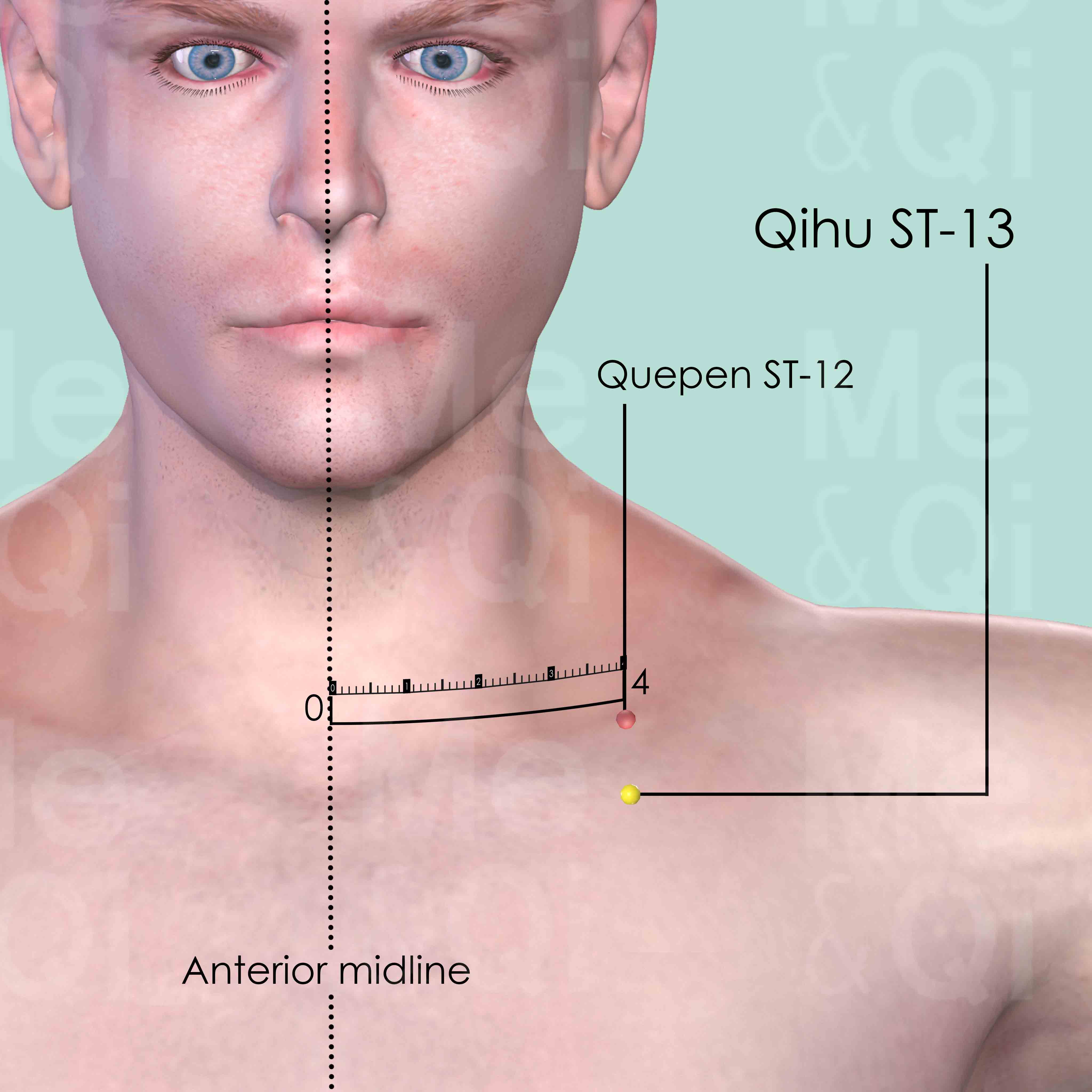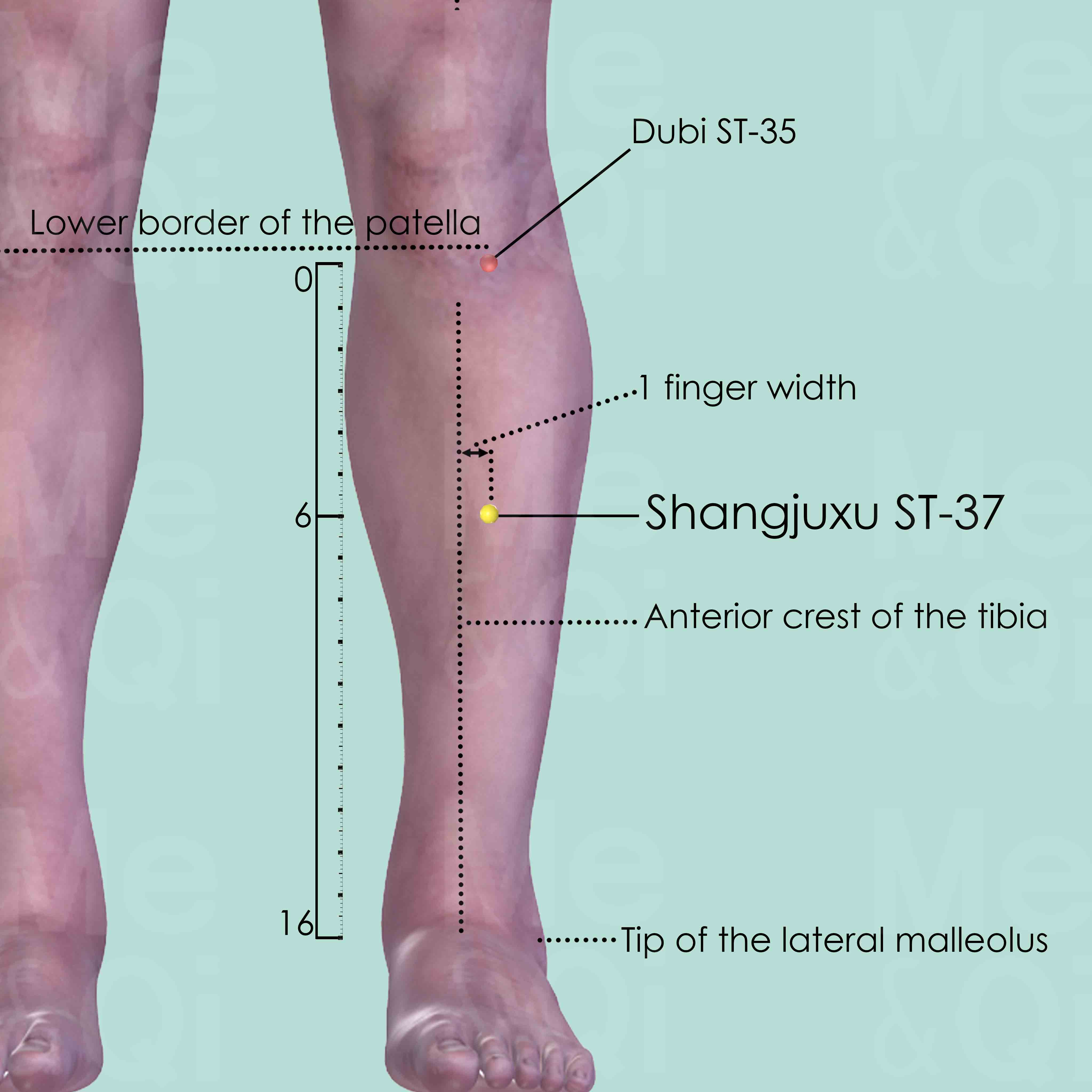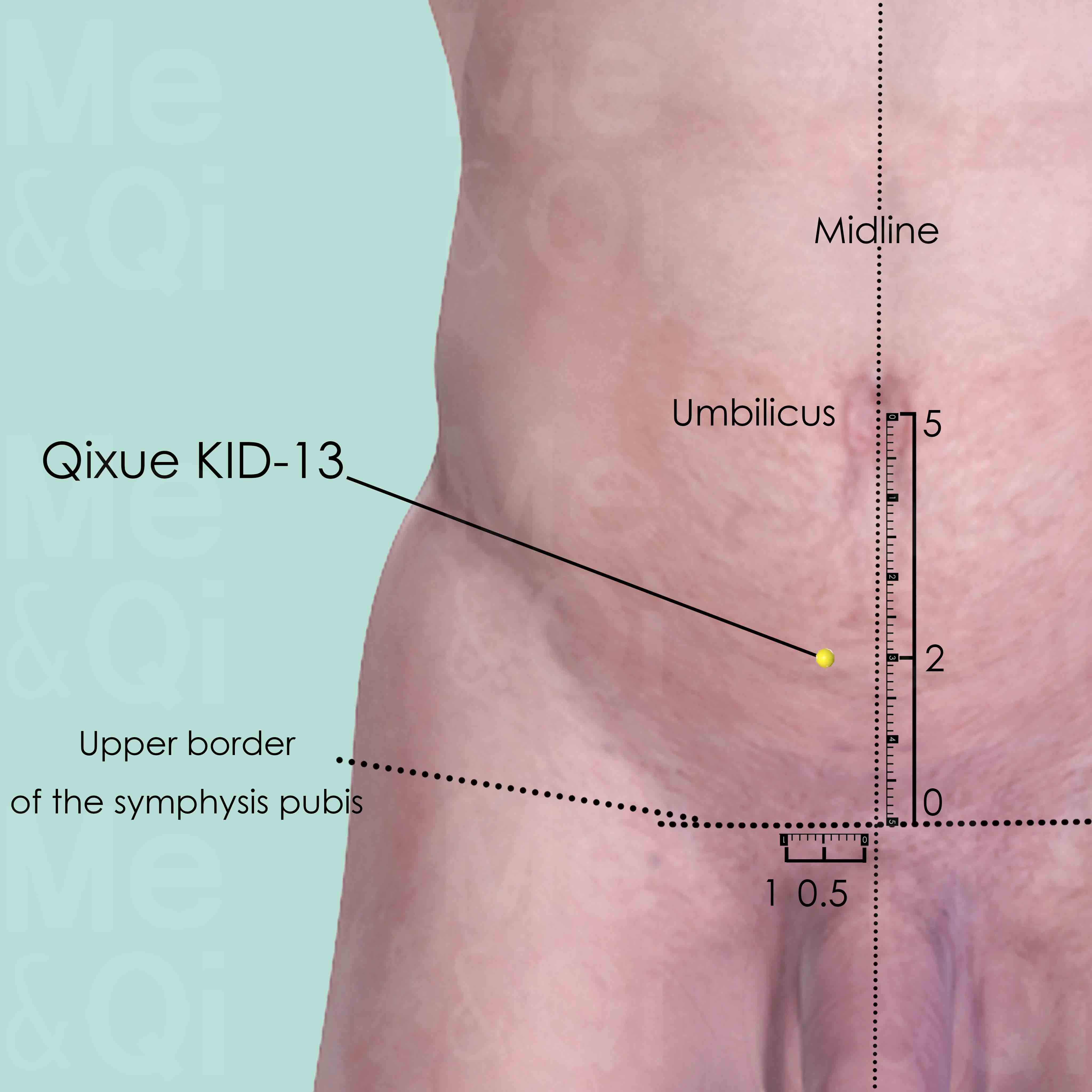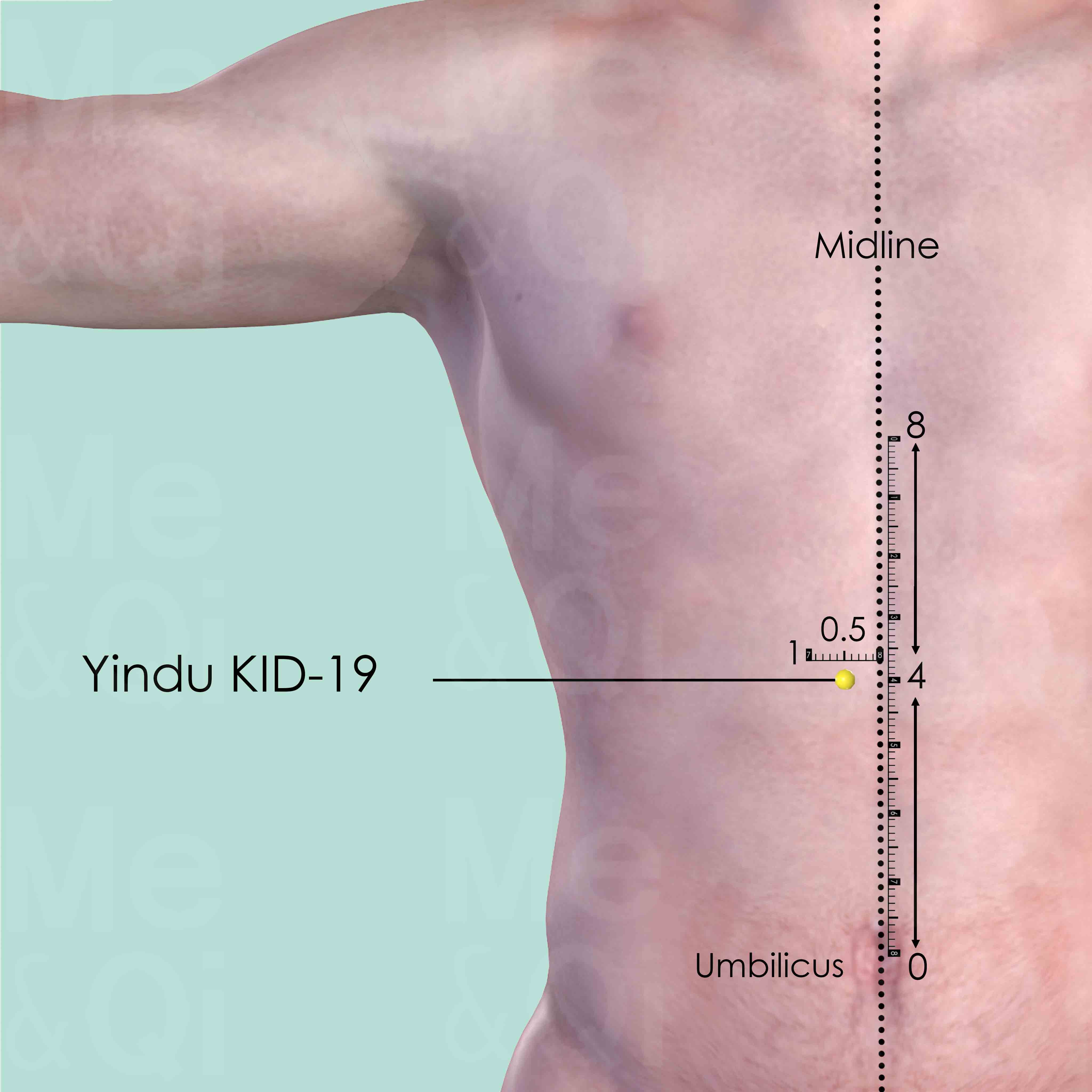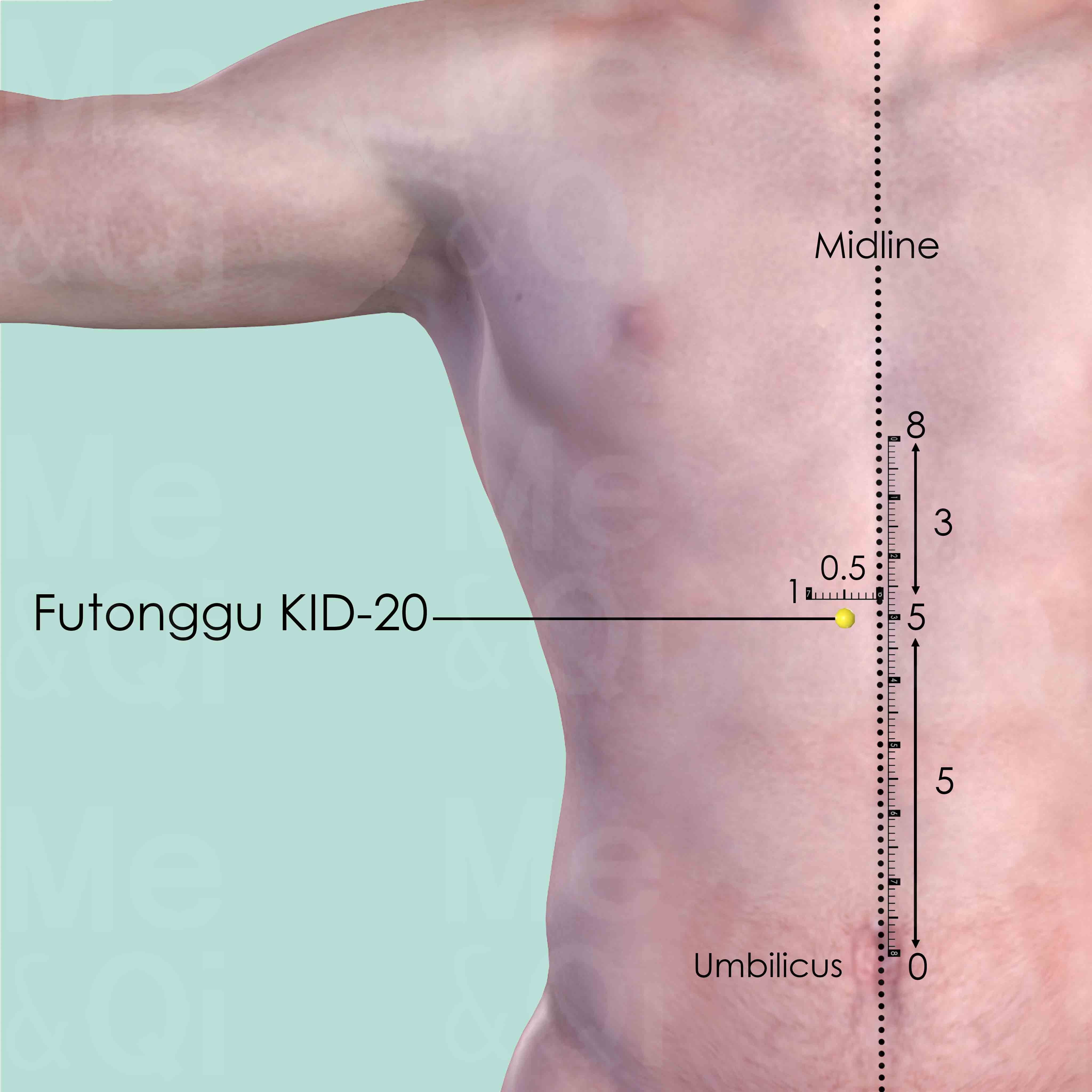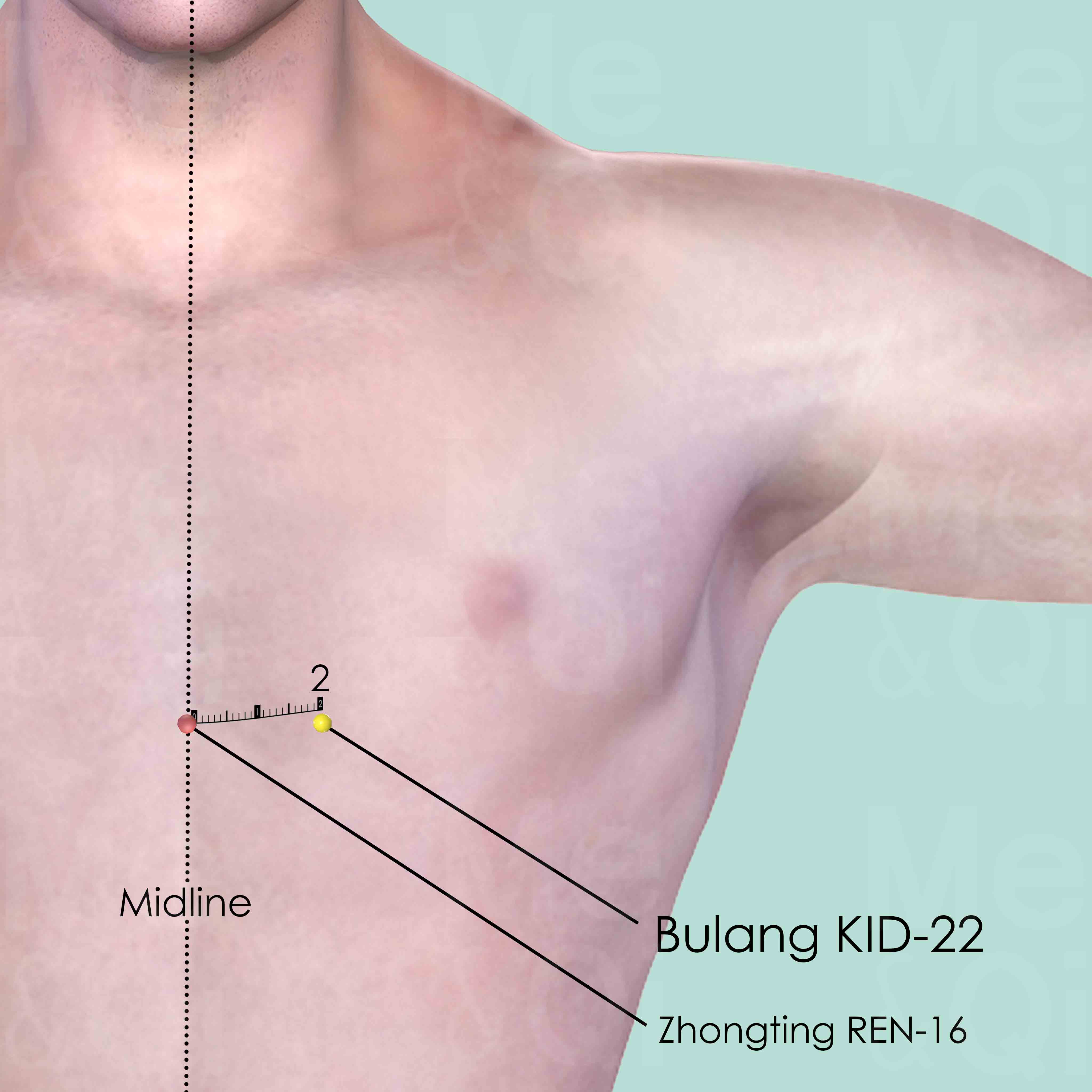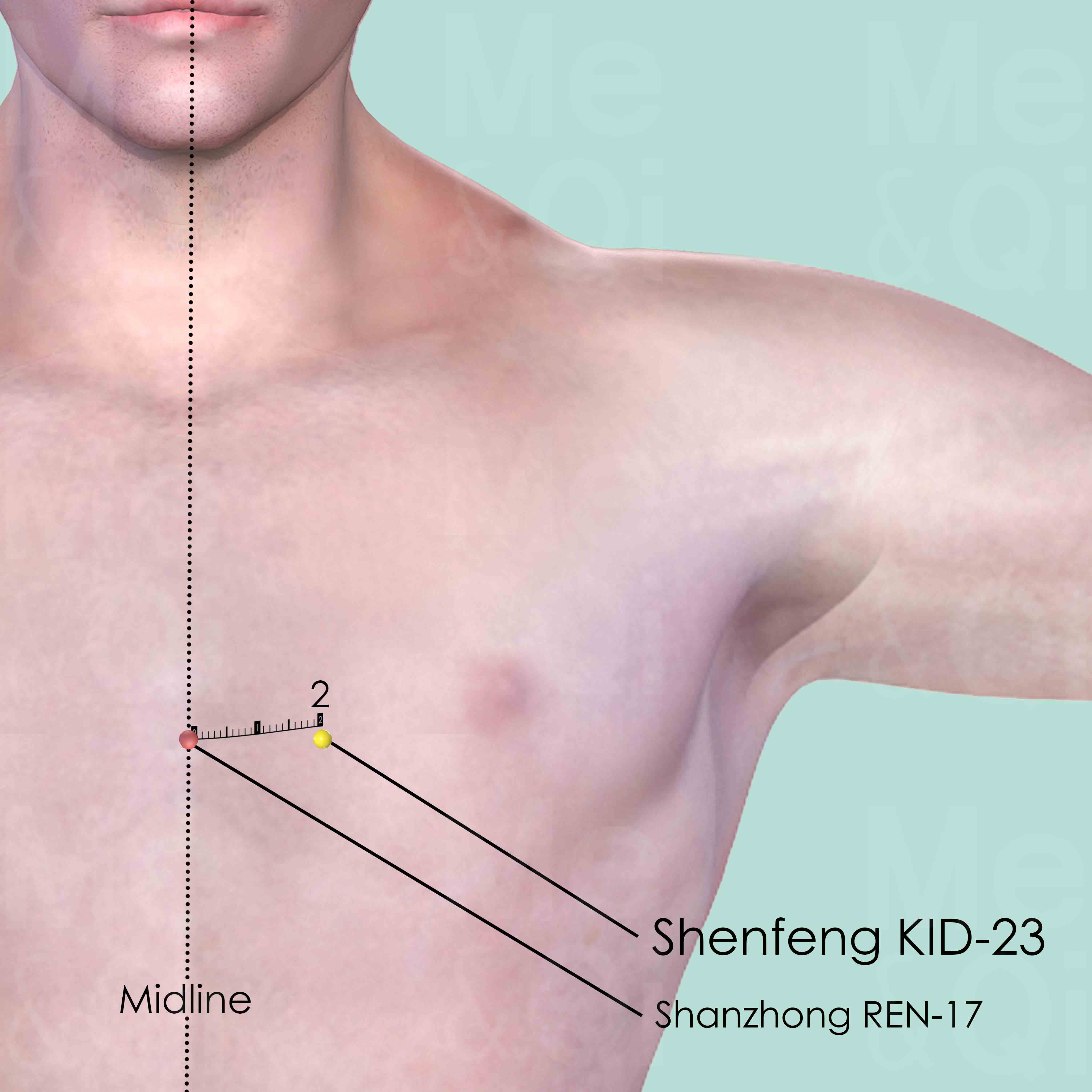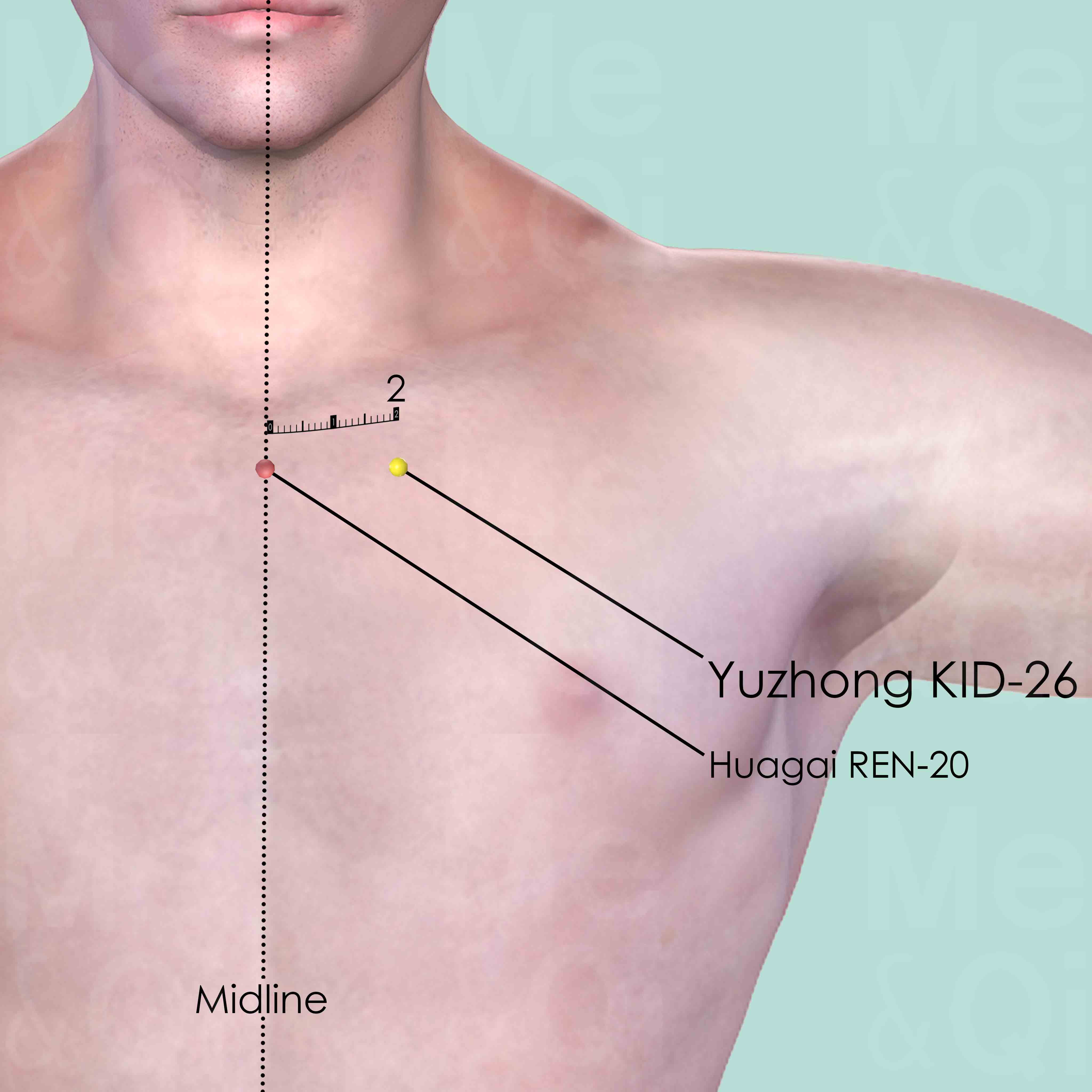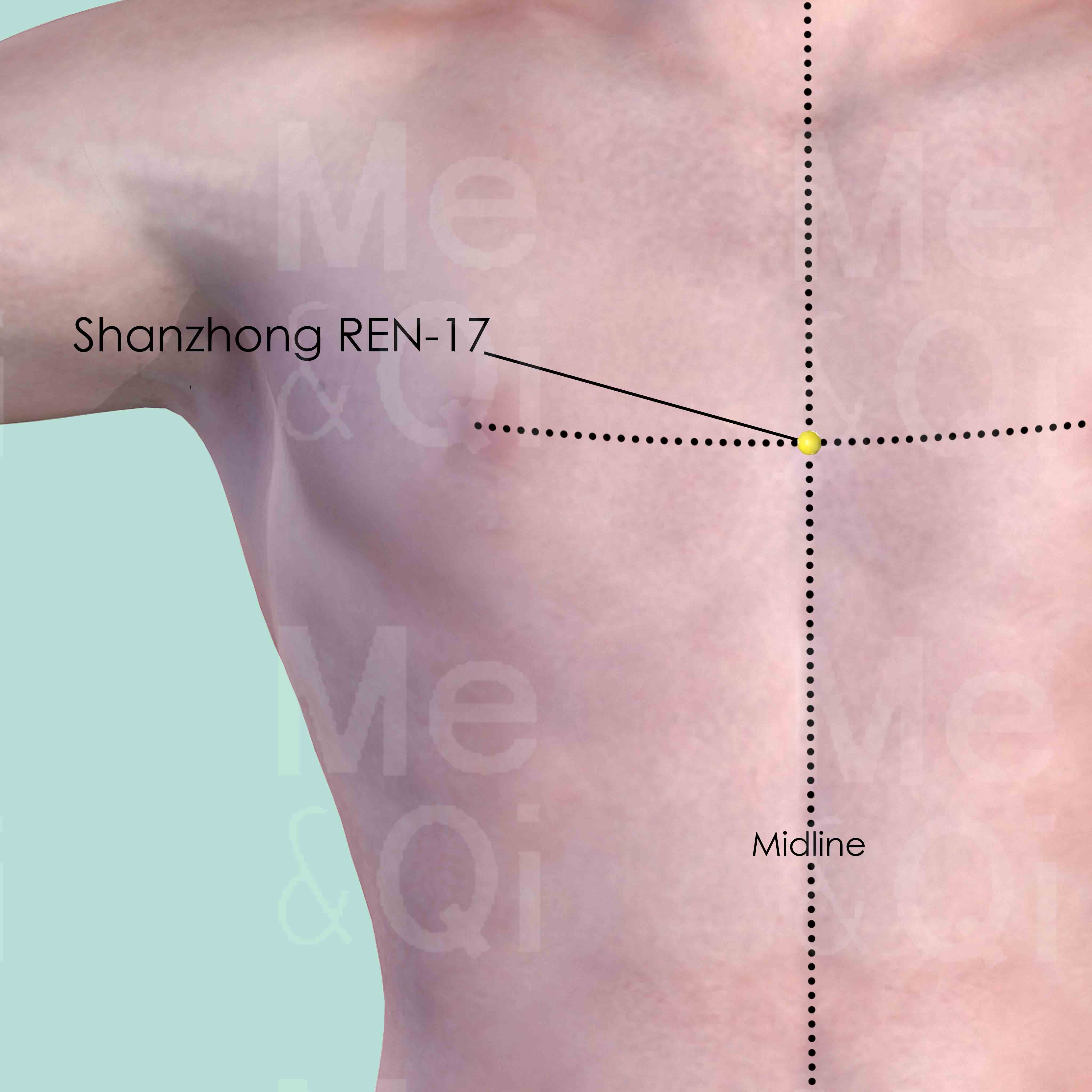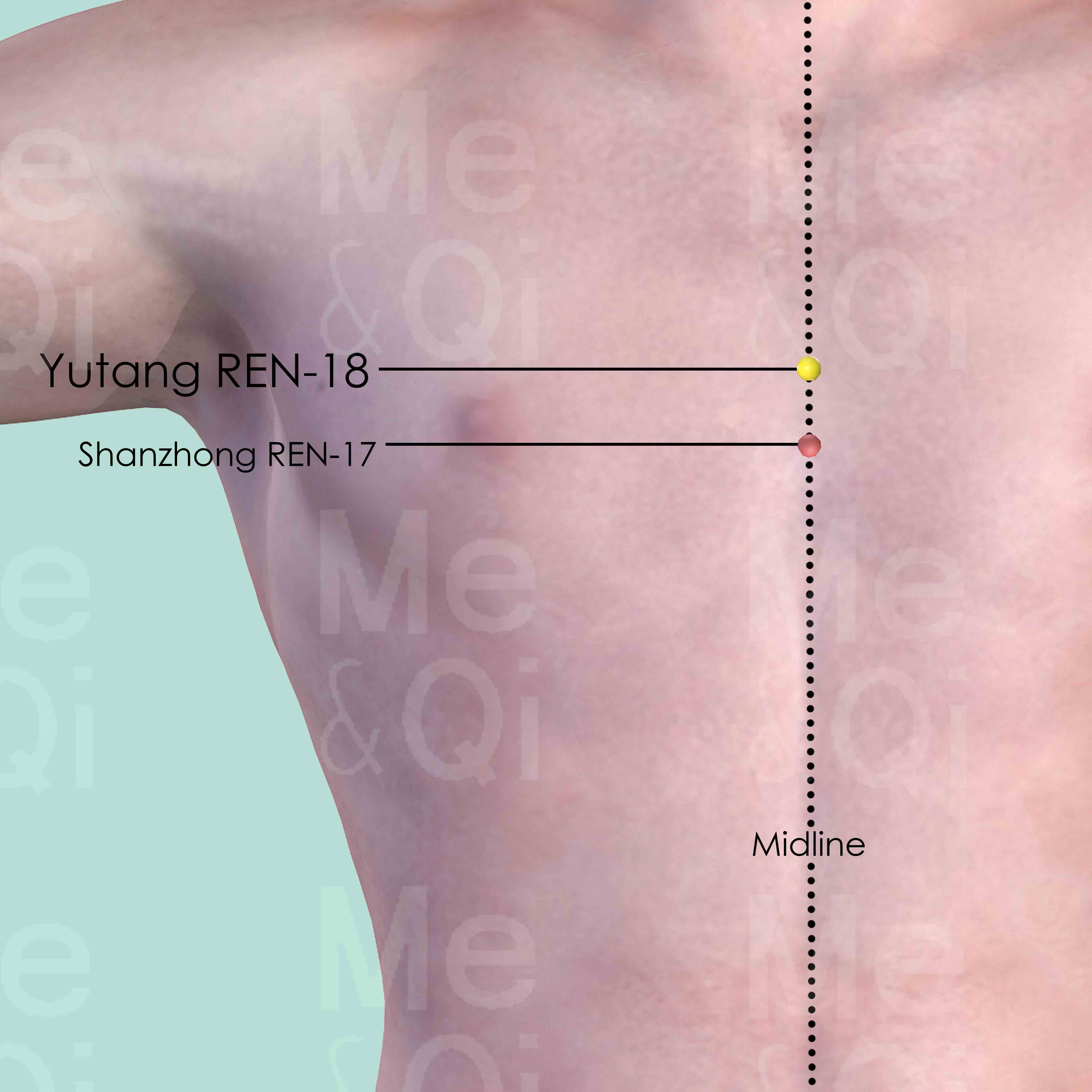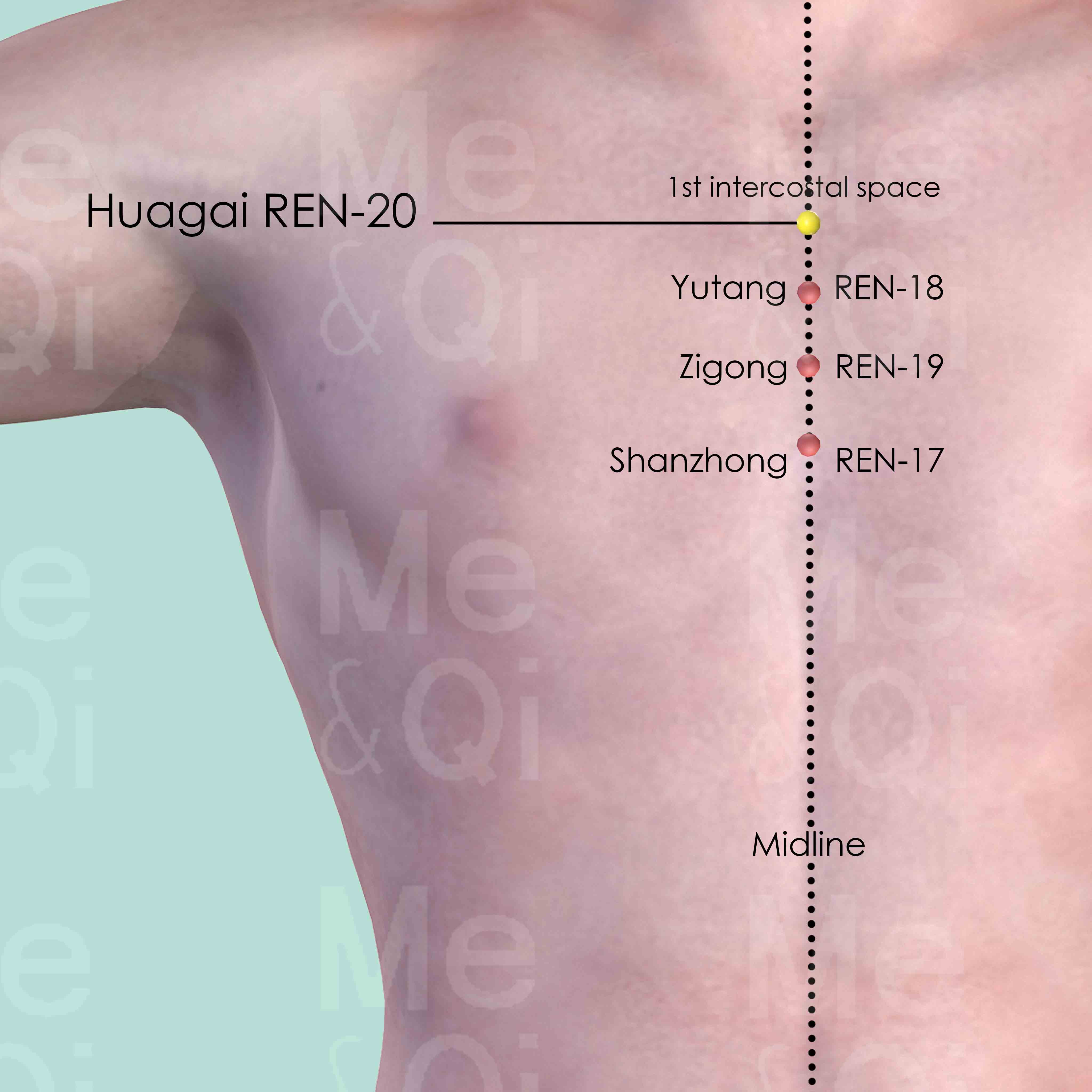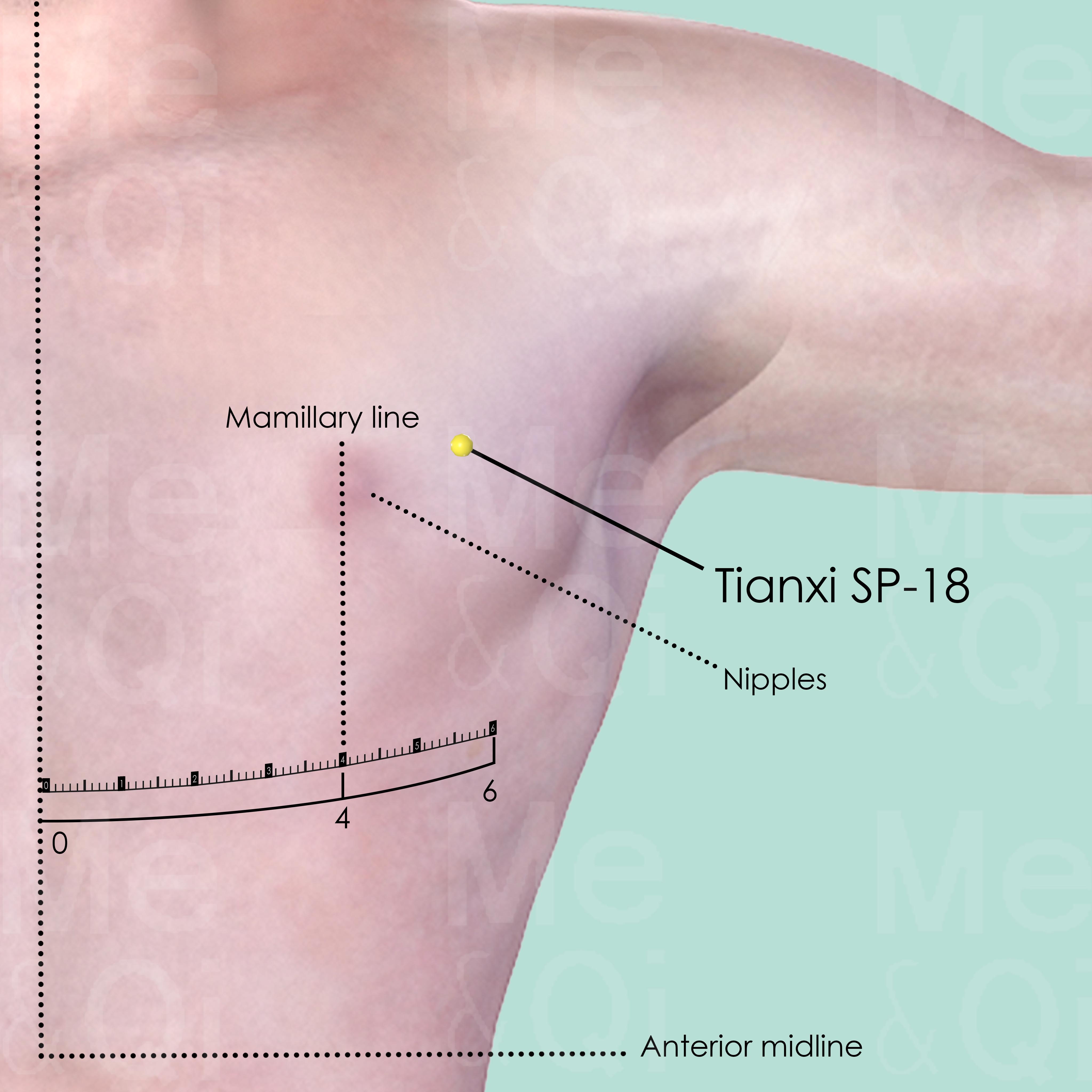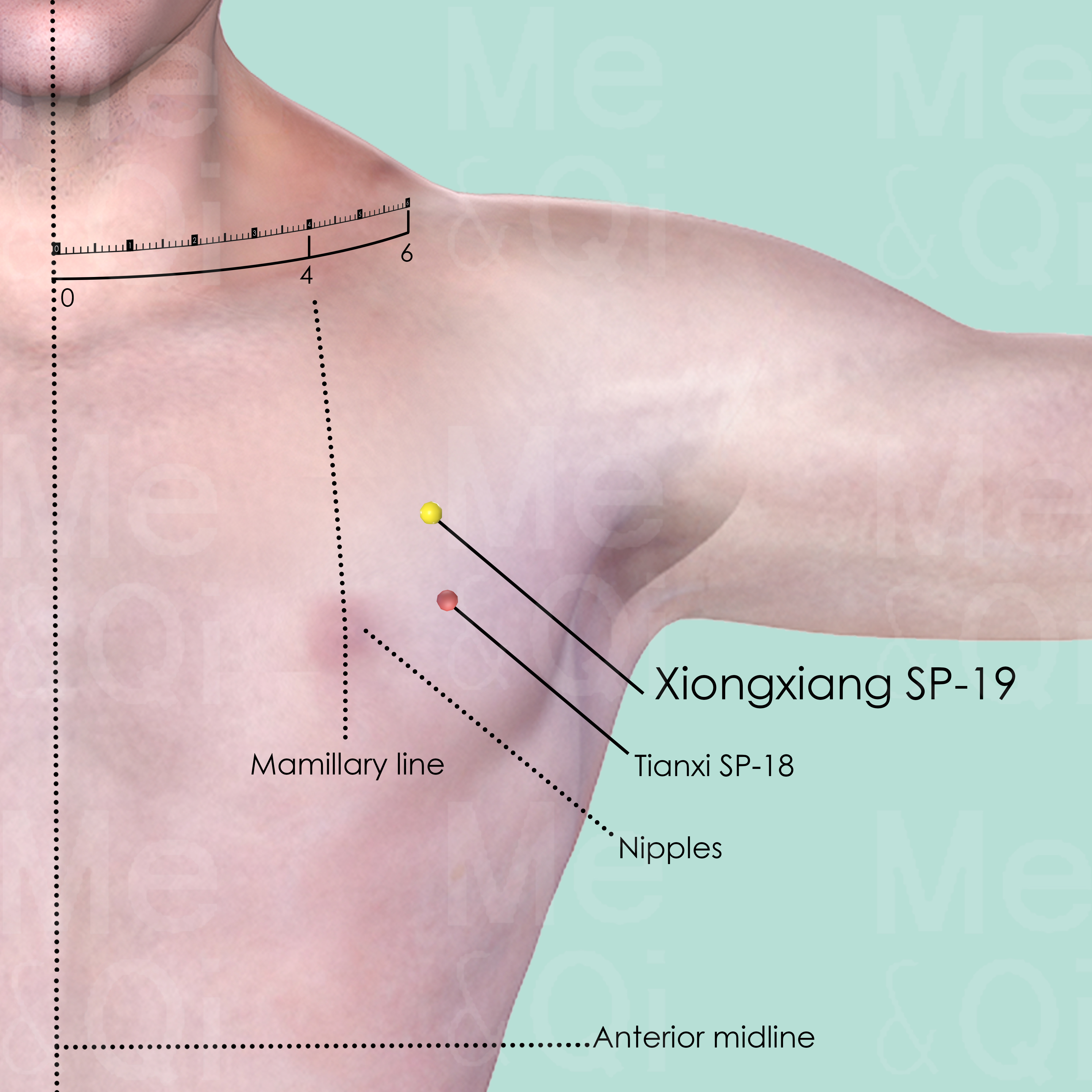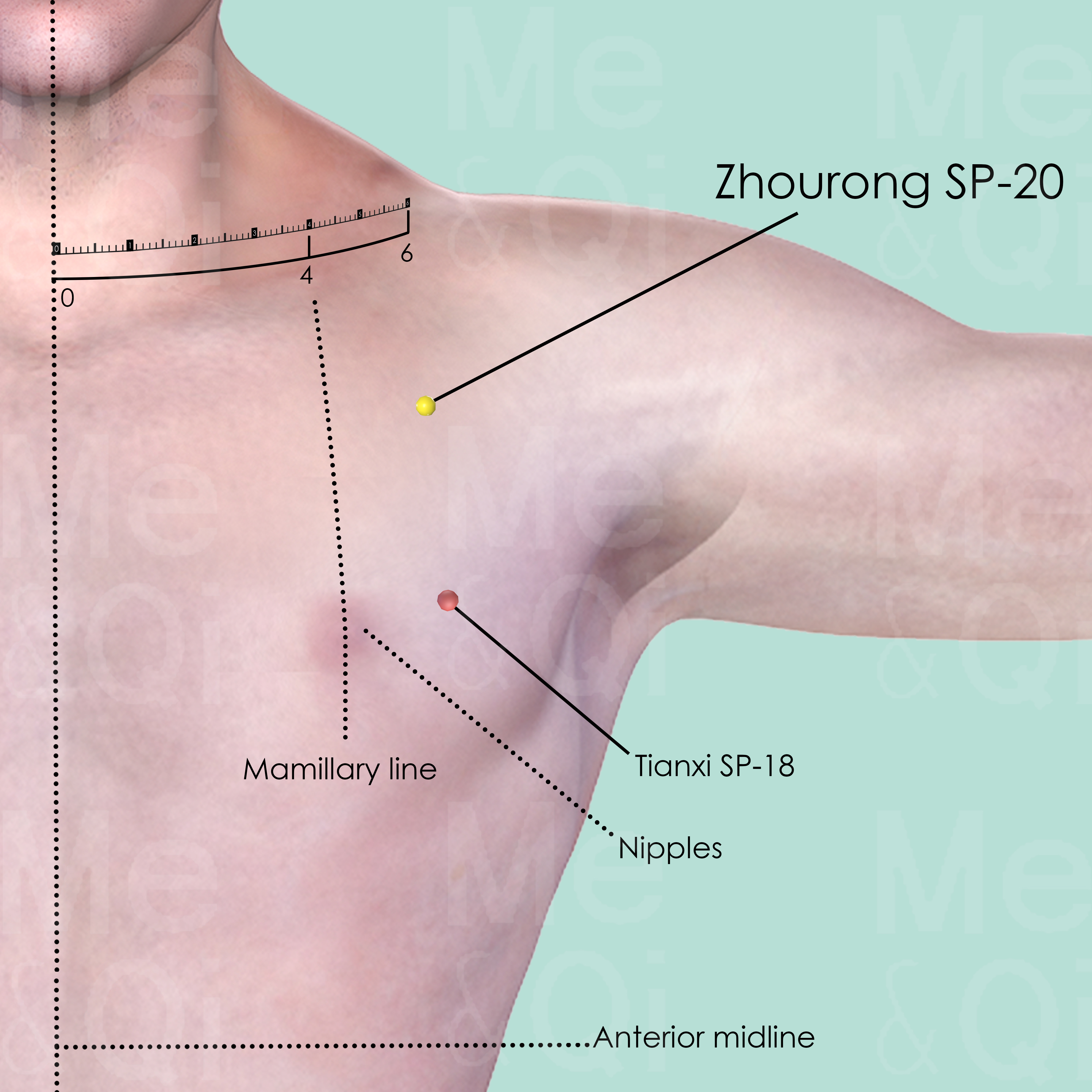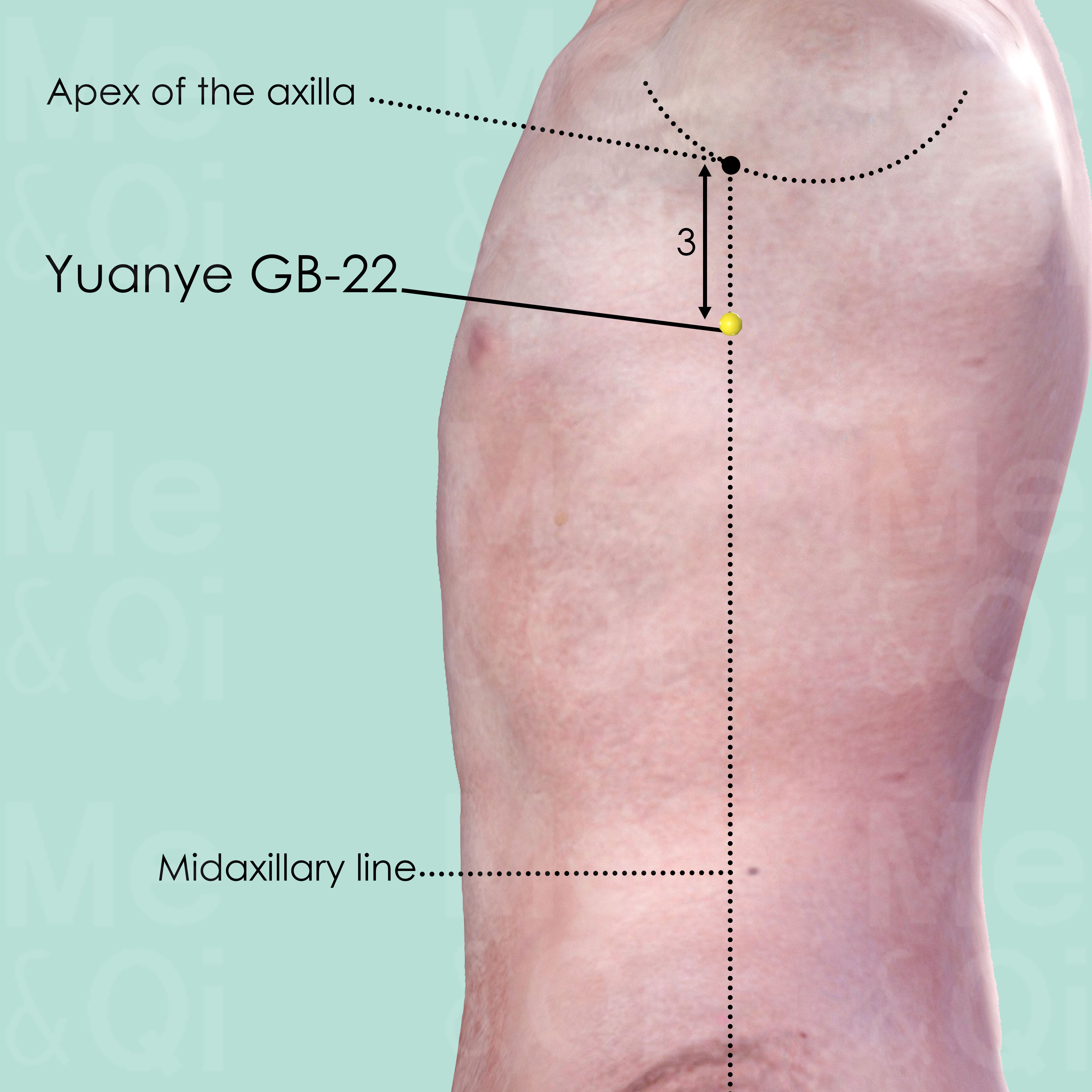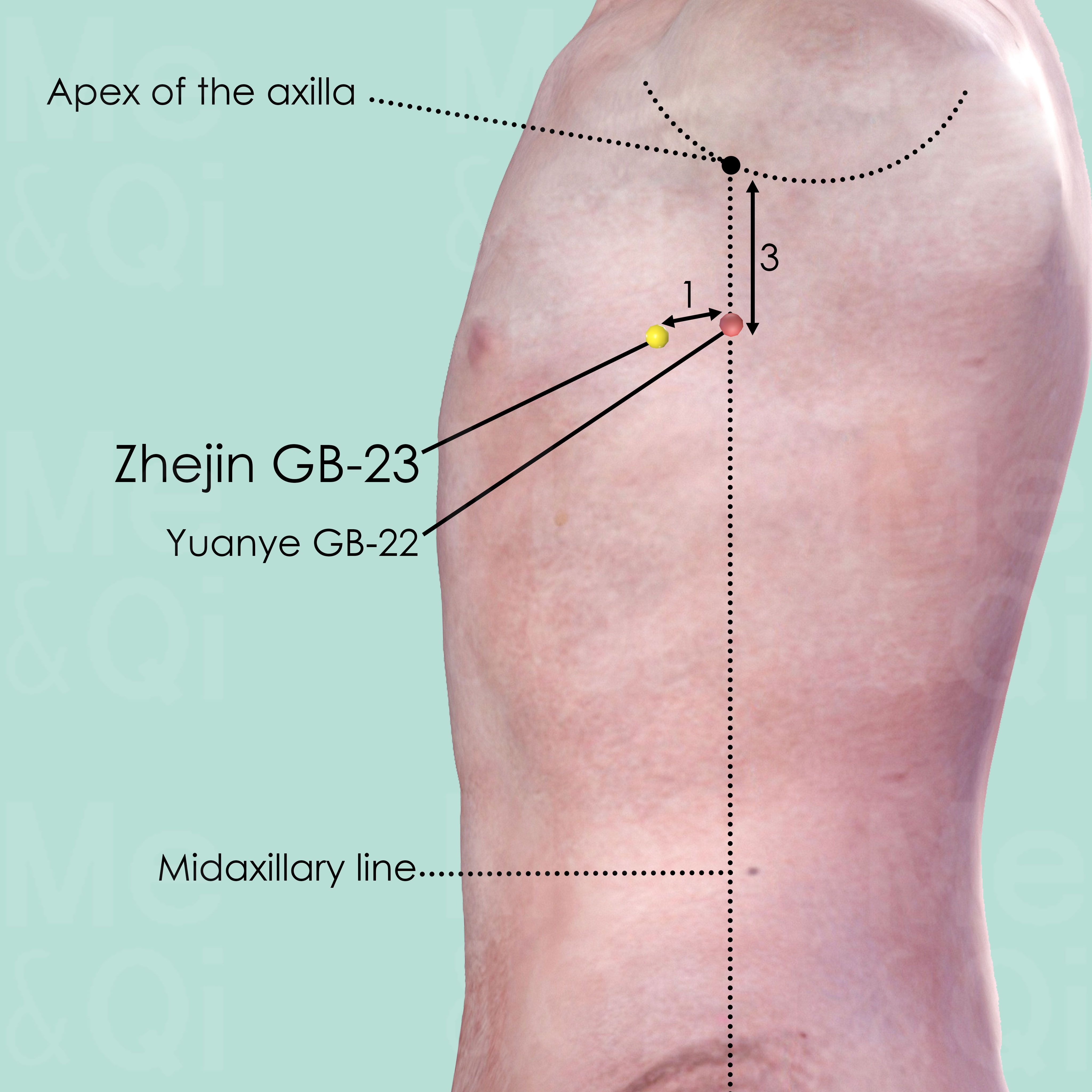Chest Distensionaccording to TCM
Symptom families: Chest Discomfort & Sensations, Chest Swelling, Congestion, and Physical Changes
Did you mean? Chest Congestion
Root Causes of Chest Distension in TCM
Explore below more details about what might cause Chest distension according to TCM.
- By Syndrome
- By Organ
- Phlegm
- Dampness
- Qi Stagnation
- Heat
- Blood Stasis
- Blood Deficiency
- Cold
- Qi Deficiency
- Summer Heat
- Wind
- View More Causes
- Pericardium
- Liver
- Lung
- Small Intestine
- Stomach
- Uterus
- Heart
- Spleen
- Large Intestine
- Triple Burner
- View More Organs
Phlegm
In TCM "Phlegm" as a pattern of disharmony is a complex concept that extends beyond the physical manifestation of mucus. It represents a pathological factor that can disrupt the flow of Qi (vital energy) and blood, leading to various health issues. Phlegm in TCM is seen as a sticky, turbid substance arising from the body's inability to metabolize fluids properly, often due to a dysfunction of the spleen. It's not only associated with respiratory problems like cough and congestion but also with systemic issues. Symptoms can include a feeling of heaviness, mental cloudiness, dizziness, and in some cases, the formation of lumps or masses. Phlegm can even be "invisible," contributing to emotional disturbances like depression or stress. ... see more
Phlegm Patterns That Can Lead to Chest Distension
Common Symptoms: Dizziness Nausea Feeling Of Heaviness Shortness Of Breath Feeling Of Oppression Of The Chest Sputum Edema Depression
| Pattern Name | Relevant Symptoms | Relevant Formulas |
|---|---|---|
| Damp-Phlegm in the Uterus | Chest fullness, Late menstruation, Amenorrhea, Scanty menstruation, Lower abdominal pain, Abdominal heaviness, Feeling of oppression of the chest, Generalized fatigue, Diarrhea, Dull pale complexion, Obesity, Infertility, Ovarian cysts, Ovarian fibroids, Polycystic ovary syndrome, Pseudocyesis, Sputum, Feeling of heaviness... see more | Cang Fu Dao Tan Wan | Bu Zhong Yi Qi Tang | Xiang Sha Liu Jun Zi Tang | Xiong Gui Er Chen Tang |
| Damp-Phlegm in the Lungs | Chest fullness, Coughing, Pale face, Sputum, Stifling sensation in the chest, Shortness of breath, Discomfort when lying down, Wheezing, Nausea, Feeling of heaviness, Dizziness, Profuse white sputum, Asthma, Chest distension... see more | Er Chen Tang |
| Phlegm | Chest fullness, Feeling of oppression of the chest, Head fog, Dizziness | Yue Ju Wan | Ban Xia Hou Pu Tang | Wen Dan Tang |
| Phlegm-Fluids | Chest fullness, Abdominal distention, Vomiting clear liquid, Feeling of heaviness, Shortness of breath, Hypochondrial pain that is worse on coughing and breathing, Coughing, Lack of sweating, Absence of thirst, Edema, Chest distension... see more | Er Chen Tang | Wen Dan Tang | Wu Ling San | Ling Gui Zhu Gan Tang |
| Phlegm-Fluids in the Stomach and Small intestine | Chest fullness, Abdominal distention, Vomiting clear liquid, Dry tongue, Dry mouth without desire to drink, Stomach splashing sound, Chest distension, Diarrhea, Weight loss... see more | Xiao Chai Hu Tang | Ling Gui Zhu Gan Tang | Ban Xia Xie Xin Tang | Xuan Fu Dai Zhe Tang |
| Phlegm-Heat in the Lungs | Chest fullness, Coughing, Shortness of breath, Wheezing, Stifling sensation in the chest, Sputum, Feeling hot, Thirst, Head and body heaviness, Dizziness, Copious thick yellow sputum... see more | Er Chen Tang | Wen Dan Tang | Qing Qi Hua Tan Wan | Ma Xing Shi Gan Tang | Qing Xin Li Ge Tang | Ren Shen Ge Jie San | Pi Pa Qing Fei Yin |
| Phlegm-Heat | Focal distention, Chest fullness, Upper abdominal oppression, Mucous in feces, Depression | Qing Qi Hua Tan Wan |
| Damp-Cold Phlegm | Focal distention, Nausea, Vomit, Tight feeling in chest and stomach, Palpitations, Dizziness, Profuse white sputum, Upper respiratory tract infections, Chronic bronchitis, Emphysema, Goitre... see more | Er Chen Tang |
| Phlegm-Dampness in the Middle-Burner | Focal distention, Nausea, Vomit, Tight feeling in chest and stomach, Profuse white sputum, Anorexia, Peptic ulcer, Chronic gastritis, Acid reflux, Abdominal pain, Bloated abdomen... see more | Liu Jun Zi Tang |
Dampness
"Dampness" in TCM is a concept that describes a pattern of disharmony where the body accumulates excess moisture. Imagine the heavy, sticky feeling you get on a very humid day; that's similar to what dampness feels like internally. It can manifest as a sense of heaviness, bloating, sluggishness, or even a foggy mind. This condition is often thought to arise from environmental factors like living in a damp place, dietary habits that promote moisture in the body, or internal imbalances that hinder the body's ability to process fluids properly. In TCM, dampness can obstruct the normal flow of energy and fluids in the body, leading to various symptoms.... see more
Dampness Patterns That Can Lead to Chest Distension
Common Symptoms: Nausea Feeling Of Heaviness Dizziness Shortness Of Breath Profuse White Sputum Tight Feeling In Chest And Stomach Diarrhea Sputum
| Pattern Name | Relevant Symptoms | Relevant Formulas |
|---|---|---|
| Damp-Phlegm in the Uterus | Chest fullness, Late menstruation, Amenorrhea, Scanty menstruation, Lower abdominal pain, Abdominal heaviness, Feeling of oppression of the chest, Generalized fatigue, Diarrhea, Dull pale complexion, Obesity, Infertility, Ovarian cysts, Ovarian fibroids, Polycystic ovary syndrome, Pseudocyesis, Sputum, Feeling of heaviness... see more | Cang Fu Dao Tan Wan | Bu Zhong Yi Qi Tang | Xiang Sha Liu Jun Zi Tang | Xiong Gui Er Chen Tang |
| Damp-Phlegm in the Lungs | Chest fullness, Coughing, Pale face, Sputum, Stifling sensation in the chest, Shortness of breath, Discomfort when lying down, Wheezing, Nausea, Feeling of heaviness, Dizziness, Profuse white sputum, Asthma, Chest distension... see more | Er Chen Tang |
| Summer Heat with Dampness | Chest fullness, Fever, Aversion to cold, Perspiration, Headaches, Feeling of heaviness, Tight feeling in chest and stomach, Anxiety, Thirst, Chest distension, Lack of appetite... see more | Huo Xiang Zheng Qi San | Xiang Ru San | Gui Ling Gan Lu Yin |
| Wind-Cold-Damp invading with Qi Deficiency | Focal distention, Feeling of fullness in the chest, High fever, Fever without perspiration, Headaches, Neck pain, Stiff neck, Painful extremities, Chest distension, Congested nose, Noisy breathing, Coughing... see more | Ren Shen Bai Du San |
| Damp-Cold Phlegm | Focal distention, Nausea, Vomit, Tight feeling in chest and stomach, Palpitations, Dizziness, Profuse white sputum, Upper respiratory tract infections, Chronic bronchitis, Emphysema, Goitre... see more | Er Chen Tang |
| Phlegm-Dampness in the Middle-Burner | Focal distention, Nausea, Vomit, Tight feeling in chest and stomach, Profuse white sputum, Anorexia, Peptic ulcer, Chronic gastritis, Acid reflux, Abdominal pain, Bloated abdomen... see more | Liu Jun Zi Tang |
Qi Stagnation
Qi Stagnation in TCM is like having a traffic jam in your body's energy system. Qi, the vital life force that flows through your body, is supposed to move smoothly to maintain health and balance. But with Qi Stagnation, this flow gets blocked or slowed down, like cars stuck on a highway. This can lead to symptoms like feeling stressed, emotional mood swings, and physical discomfort, often described as a feeling of fullness or tightness, especially in the chest or abdomen. It's as though the body's internal energy circulation is disrupted, causing various issues. TCM sees this as an energy flow problem, different from modern medicine's focus on specific physiological processes.... see more
Qi Stagnation Patterns That Can Lead to Chest Distension
Common Symptoms: Depression Sighing Irritability Lack Of Appetite Purple Lips Abdominal Distention Mood Swings Irregular Periods
| Pattern Name | Relevant Symptoms | Relevant Formulas |
|---|---|---|
| Liver Qi Stagnation | Chest distension, Hypochondriac distention, Upper abdominal distension, Abdominal distention, Sighing, Melancholia, Depression, Mood swings, Irregular periods, Globus sensation, Pre menstrual breast distension, Pre menstrual tension, Anxiety, Anger... see more | Xiao Yao San | Jia Wei Xiao Yao San | Yue Ju Wan | Chai Hu Shu Gan San | Yi Guan Jian |
| Qi Stagnation in Chest | Chest distention, Chest fullness, Chest stiffness, Chest distension, Chest pain, Chest pain improve with massage, Desire for hot beverages and foods, Bleeding during pregnancy... see more | Xuan Fu Hua Tang |
| Qi And Blood Stagnation | Chest fullness, Feeling of fullness in the chest, Chest distension, Chest pain, Stabbing fixed pain, Dark face, Purple lips, Purple nails, Irritability, Mood swings, Depression, Mottled skin, Foot edema, Abdominal masses, Melena black tarry stool, Menstrual cramps, Amenorrhea, Dark menstrual clots, Dark menstrual blood, Prolonged lochia, Irregular periods... see more | Jia Wei Xiao Yao San | Chai Hu Shu Gan San | Ge Xia Zhu Yu Tang | Tao Hong Si Wu Tang | Shao Fu Zhu Yu Tang | Wu Yao Tang | Wei Jing Tang | Xue Fu Zhu Yu Tang | Shen Tong Zhu Yu Tang | Shi Xiao San | Qi Li San | Dan Shen Yin | Guo Qi Yin |
| Heart Qi Stagnation | Chest fullness, Palpitations, Chest distension, Feeling of oppression of the chest, Depression | Ban Xia Hou Pu Tang |
| Pericardium Qi Stagnation | Chest fullness, Mild chest pain, Chest distension, Stifling sensation in the chest, Sighing, Throat lumps, Palpitations, Depression, Irritability, Lack of appetite, Weak limbs, Cold extremities... see more | Ban Xia Hou Pu Tang |
Heat
In TCM "Heat" signifies an excess of Yang energy, leading to an imbalance where heat predominates over the body's cool Yin aspects. This condition is metaphorically akin to an internal over-heating. Symptoms indicative of Heat can include feelings of warmth, fever, sweating, irritability, red face, thirst with a preference for cold drinks, and a rapid pulse. The tongue may appear red with a yellow coating. Unlike the common interpretation of heat in terms of temperature, in TCM, it represents a state of hyperactivity or inflammation in the body.... see more
Heat Patterns That Can Lead to Chest Distension
Common Symptoms: Bitter Taste In The Mouth Anxiety Restlessness Dizziness Copious Thick Yellow Sputum Asthma Cholecystitis Pancreatitis
| Pattern Name | Relevant Symptoms | Relevant Formulas |
|---|---|---|
| Half Exterior Half Interior | Chest fullness, Chest distension, Bitter taste in the mouth, Dry cough, Anxiety, Restlessness, Vomit, Lack of appetite, Dizziness, Blurry vision... see more | Xiao Chai Hu Tang |
| Phlegm-Heat in the Lungs | Chest fullness, Coughing, Shortness of breath, Wheezing, Stifling sensation in the chest, Sputum, Feeling hot, Thirst, Head and body heaviness, Dizziness, Copious thick yellow sputum... see more | Er Chen Tang | Wen Dan Tang | Qing Qi Hua Tan Wan | Ma Xing Shi Gan Tang | Qing Xin Li Ge Tang | Ren Shen Ge Jie San | Pi Pa Qing Fei Yin |
| Phlegm-Heat | Focal distention, Chest fullness, Upper abdominal oppression, Mucous in feces, Depression | Qing Qi Hua Tan Wan |
| Heat in Yang brightness Organs | Focal distention, Severe constipation, Excessive gas and flatulence, Abdominal fullness, Abdominal pain worsened by pressure, Abdominal tightness, Pancreatitis, Appendicitis, Cholecystitis, Bacillary dysentery, Icteric hepatitis... see more | Da Cheng Qi Tang |
Blood Stasis
Blood Stasis in TCM is a concept where the blood flow in the body is not as smooth or efficient as it should be. Imagine a river that's supposed to flow freely, but instead, it's getting blocked or moving too slowly in some parts. This can lead to various health issues, like pain that feels sharp or stabbing, dark bruises, and a complexion that looks purplish. TCM believes that good health relies on the smooth and vibrant flow of Qi and blood throughout the body, so when blood gets stuck, it's like a traffic jam in your body, leading to discomfort or health problems.... see more
Blood Stasis Patterns That Can Lead to Chest Distension
Common Symptoms: Chest Pain Purple Lips Purple Nails Depression Menstrual Cramps Dark Menstrual Clots Hypertension Stabbing Fixed Pain
| Pattern Name | Relevant Symptoms | Relevant Formulas |
|---|---|---|
| Qi And Blood Stagnation | Chest fullness, Feeling of fullness in the chest, Chest distension, Chest pain, Stabbing fixed pain, Dark face, Purple lips, Purple nails, Irritability, Mood swings, Depression, Mottled skin, Foot edema, Abdominal masses, Melena black tarry stool, Menstrual cramps, Amenorrhea, Dark menstrual clots, Dark menstrual blood, Prolonged lochia, Irregular periods... see more | Jia Wei Xiao Yao San | Chai Hu Shu Gan San | Ge Xia Zhu Yu Tang | Tao Hong Si Wu Tang | Shao Fu Zhu Yu Tang | Wu Yao Tang | Wei Jing Tang | Xue Fu Zhu Yu Tang | Shen Tong Zhu Yu Tang | Shi Xiao San | Qi Li San | Dan Shen Yin | Guo Qi Yin |
| Pericardium Blood Stagnation | Chest fullness, Palpitations, Chest pain, Chest distension, Stifling sensation in the chest, Shortness of breath, Purple lips, Purple nails, Menstrual cramps, Dark menstrual clots... see more | Xue Fu Zhu Yu Tang |
Blood Deficiency
Blood Deficiency in TCM is like when your body's tank runs low on the vital energy that blood provides. It's not exactly the same as anemia in modern medicine, which is about having too few red blood cells. Instead, Blood Deficiency in TCM is about your body not having enough of the life-giving qualities that blood brings, like nourishment and moisture. This can make you feel tired, look pale, and even feel dizzy or have blurry vision. It's like a garden not getting enough water to stay lush and vibrant. TCM sees this as an imbalance where the body isn't being nourished as it should be, impacting overall health and well-being.... see more
Blood Deficiency Patterns That Can Lead to Chest Distension
Common Symptoms: Chest Pain Dizziness Chest Stiffness Palpitations Insomnia Poor Memory Shortness Of Breath Anxiety
| Pattern Name | Relevant Symptoms | Relevant Formulas |
|---|---|---|
| Pericardium Blood Deficiency | Chest fullness, Chest distension, Chest stiffness, Chest pain, Palpitations, Insomnia, Poor memory... see more | Shen Qi Si Wu Tang |
| Blood Deficiency with disharmony of Liver and Spleen | Chest fullness, Chest distension, Chest pain, Anemia, Dizziness, Headaches, Dry mouth, Dry throat, Lack of appetite, Irregular periods, Leukorrhea... see more | Xiao Yao San |
Cold
In TCM "Cold" as a pattern of disharmony refers to a specific type of imbalance within the body's systems, often linked to a deficiency or weakness. It's not about feeling physically cold or having a common cold, but rather a metaphorical description of certain symptoms and underlying conditions. When a TCM practitioner says someone suffers from "Cold," it usually implies that the body's Yang energy, which is warm and active, is insufficient or overpowered by Yin energy, which is cool and passive. Symptoms of Cold in TCM can include a general feeling of coldness, cold limbs, pale complexion, low energy, slow metabolism, and a preference for warmth. ... see more
Cold Patterns That Can Lead to Chest Distension
Common Symptoms: High Fever Fever Without Perspiration Headaches Neck Pain Stiff Neck Painful Extremities Congested Nose Noisy Breathing
| Pattern Name | Relevant Symptoms | Relevant Formulas |
|---|---|---|
| Wind-Cold-Damp invading with Qi Deficiency | Focal distention, Feeling of fullness in the chest, High fever, Fever without perspiration, Headaches, Neck pain, Stiff neck, Painful extremities, Chest distension, Congested nose, Noisy breathing, Coughing... see more | Ren Shen Bai Du San |
| Damp-Cold Phlegm | Focal distention, Nausea, Vomit, Tight feeling in chest and stomach, Palpitations, Dizziness, Profuse white sputum, Upper respiratory tract infections, Chronic bronchitis, Emphysema, Goitre... see more | Er Chen Tang |
Qi Deficiency
Qi Deficiency in TCM is like running low on battery power. Qi is the vital energy that powers every function in your body. When there's a Qi Deficiency, it means your body doesn't have enough of this essential energy. This can make you feel tired all the time, weak, or even cause shortness of breath. It's similar to how you feel when you haven't had enough sleep or nutritious food. Your body just doesn't have the energy it needs to perform at its best. Unlike modern medicine, which often focuses on specific physical causes for fatigue and weakness, TCM views Qi Deficiency as an overall energy depletion that affects your entire well-being, and it seeks to replenish and balance this vital energy.... see more
Qi Deficiency Patterns That Can Lead to Chest Distension
| Pattern Name | Relevant Symptoms | Relevant Formulas |
|---|---|---|
| Wind-Cold-Damp invading with Qi Deficiency | Focal distention, Feeling of fullness in the chest, High fever, Fever without perspiration, Headaches, Neck pain, Stiff neck, Painful extremities, Chest distension, Congested nose, Noisy breathing, Coughing... see more | Ren Shen Bai Du San |
Summer Heat
"Summer-Heat" in TCM is a unique concept that refers to a pattern of disharmony often associated with the hot summer months. Imagine the intense heat of summer stressing your body, like being in a sweltering, humid environment for too long. This can lead to symptoms like feeling overheated, excessive sweating, a feeling of irritation, and sometimes even nausea or dizziness. In TCM, this condition is thought to arise from the external environment's heat affecting the body's internal balance. It's similar to how we might feel uncomfortable and out of sorts on a very hot day. ... see more
Summer Heat Patterns That Can Lead to Chest Distension
| Pattern Name | Relevant Symptoms | Relevant Formulas |
|---|---|---|
| Summer Heat with Dampness | Chest fullness, Fever, Aversion to cold, Perspiration, Headaches, Feeling of heaviness, Tight feeling in chest and stomach, Anxiety, Thirst, Chest distension, Lack of appetite... see more | Huo Xiang Zheng Qi San | Xiang Ru San | Gui Ling Gan Lu Yin |
Wind
In TCM "Wind" is a concept that represents a pattern of disharmony, often characterized by its sudden and unpredictable nature, much like a gusty wind changing direction without warning. This pattern is associated with symptoms that come and go quickly or move around the body, such as itching, tremors, or even certain types of pain. Wind is considered to be a primary cause of illnesses that have these rapidly changing characteristics. In TCM, external Wind often refers to illnesses that start suddenly, like the common cold, believed to be caused by external pathogenic factors like climatic changes. On the other hand, internal Wind can be linked to internal imbalances and can manifest in conditions like dizziness or spasms. ... see more
Wind Patterns That Can Lead to Chest Distension
| Pattern Name | Relevant Symptoms | Relevant Formulas |
|---|---|---|
| Wind-Cold-Damp invading with Qi Deficiency | Focal distention, Feeling of fullness in the chest, High fever, Fever without perspiration, Headaches, Neck pain, Stiff neck, Painful extremities, Chest distension, Congested nose, Noisy breathing, Coughing... see more | Ren Shen Bai Du San |
Pericardium
In TCM the Pericardium is more than a physical membrane protecting the heart; it's considered an organ system that acts as the "Heart's protector." It plays a crucial role in safeguarding the heart from external pathogenic factors and emotional disturbances. The Pericardium is also involved in regulating blood circulation and influencing emotional well-being, especially in terms of relationships and intimacy. When the Pericardium malfunctions or is imbalanced in TCM, it can lead to symptoms that mirror heart issues, such as chest pain or palpitations, but often with an emotional component like difficulty in forming emotional connections or excessive vulnerability to external stressors. Additionally, a disturbed Pericardium can result in sleep disturbances, anxiety, and in severe cases, mental confusion, reflecting its integral role in both physical heart protection and emotional balance.... see more
Pericardium Patterns That Can Lead to Chest Distension
Common Symptoms: Palpitations Shortness Of Breath Chest Pain Pale Face Cold Hands Stifling Sensation In The Chest Purple Lips Depression
| Pattern Name | Relevant Symptoms | Relevant Formulas |
|---|---|---|
| Pericardium Blood Deficiency | Chest fullness, Chest distension, Chest stiffness, Chest pain, Palpitations, Insomnia, Poor memory... see more | Shen Qi Si Wu Tang |
| Pericardium Blood Stagnation | Chest fullness, Palpitations, Chest pain, Chest distension, Stifling sensation in the chest, Shortness of breath, Purple lips, Purple nails, Menstrual cramps, Dark menstrual clots... see more | Xue Fu Zhu Yu Tang |
| Pericardium Qi Stagnation | Chest fullness, Mild chest pain, Chest distension, Stifling sensation in the chest, Sighing, Throat lumps, Palpitations, Depression, Irritability, Lack of appetite, Weak limbs, Cold extremities... see more | Ban Xia Hou Pu Tang |
Liver
In TCM the Liver is viewed as the organ responsible for the smooth flow of Qi, Blood, and emotions throughout the body. It plays a key role in regulating mood, storing blood, supporting digestion, and ensuring the health of tendons and eyes. When the Liver malfunctions or is imbalanced in TCM, it can lead to a range of issues such as irritability, mood swings, menstrual irregularities, eye problems, and muscular stiffness or pain. A malfunctioning Liver in TCM reflects not only physical disturbances but also emotional and mental disharmony, emphasizing the holistic approach of TCM in addressing health and wellness.... see more
Liver Patterns That Can Lead to Chest Distension
Common Symptoms: Irregular Periods Lack Of Appetite Alternating Fever And Chills Hepatitis Chronic Gastritis Peptic Ulcer Breast Engorgement Headaches
| Pattern Name | Relevant Symptoms | Relevant Formulas |
|---|---|---|
| Liver Qi Stagnation | Chest distension, Hypochondriac distention, Upper abdominal distension, Abdominal distention, Sighing, Melancholia, Depression, Mood swings, Irregular periods, Globus sensation, Pre menstrual breast distension, Pre menstrual tension, Anxiety, Anger... see more | Xiao Yao San | Jia Wei Xiao Yao San | Yue Ju Wan | Chai Hu Shu Gan San | Yi Guan Jian |
| Blood Deficiency with disharmony of Liver and Spleen | Chest fullness, Chest distension, Chest pain, Anemia, Dizziness, Headaches, Dry mouth, Dry throat, Lack of appetite, Irregular periods, Leukorrhea... see more | Xiao Yao San |
Lung
In TCM the Lungs are seen as the organ responsible for controlling Qi and respiration, as well as being a key part of the body's defensive system. They are thought to maintain the balance and flow of air and moisture, and are closely linked to the skin and hair. When the Lungs are imbalanced or malfunctioning in TCM, it can lead to respiratory issues like coughing or asthma, a weakened immune system, dry skin, and emotional disturbances such as sadness or grief. These symptoms are believed to arise from disruptions in the Lungs' ability to regulate Qi and protect the body, highlighting their central role in maintaining overall health and well-being.... see more
Lung Patterns That Can Lead to Chest Distension
Common Symptoms: Coughing Sputum Stifling Sensation In The Chest Shortness Of Breath Wheezing Dizziness Asthma Pale Face
| Pattern Name | Relevant Symptoms | Relevant Formulas |
|---|---|---|
| Damp-Phlegm in the Lungs | Chest fullness, Coughing, Pale face, Sputum, Stifling sensation in the chest, Shortness of breath, Discomfort when lying down, Wheezing, Nausea, Feeling of heaviness, Dizziness, Profuse white sputum, Asthma, Chest distension... see more | Er Chen Tang |
| Phlegm-Heat in the Lungs | Chest fullness, Coughing, Shortness of breath, Wheezing, Stifling sensation in the chest, Sputum, Feeling hot, Thirst, Head and body heaviness, Dizziness, Copious thick yellow sputum... see more | Er Chen Tang | Wen Dan Tang | Qing Qi Hua Tan Wan | Ma Xing Shi Gan Tang | Qing Xin Li Ge Tang | Ren Shen Ge Jie San | Pi Pa Qing Fei Yin |
Small Intestine
In TCM the Small Intestine plays a critical role in receiving partially digested food from the Stomach and further separating the clear from the turbid, essentially distinguishing nutrients from waste. This process is vital for proper absorption and assimilation of food. The Small Intestine is also associated with clarity of judgment and decision-making. When it malfunctions or is imbalanced in TCM, it can lead to digestive issues such as abdominal pain, bloating, poor appetite, or irregular bowel movements. Additionally, a malfunctioning Small Intestine may manifest as mental confusion or difficulty in making decisions, reflecting its role in discernment and clarity in both physical and mental realms. ... see more
Small Intestine Patterns That Can Lead to Chest Distension
Common Symptoms: Abdominal Distention Vomiting Clear Liquid Dry Tongue Dry Mouth Without Desire To Drink Stomach Splashing Sound Diarrhea Weight Loss Dizziness
| Pattern Name | Relevant Symptoms | Relevant Formulas |
|---|---|---|
| Phlegm-Fluids in the Stomach and Small intestine | Chest fullness, Abdominal distention, Vomiting clear liquid, Dry tongue, Dry mouth without desire to drink, Stomach splashing sound, Chest distension, Diarrhea, Weight loss... see more | Xiao Chai Hu Tang | Ling Gui Zhu Gan Tang | Ban Xia Xie Xin Tang | Xuan Fu Dai Zhe Tang |
| Heat in Yang brightness Organs | Focal distention, Severe constipation, Excessive gas and flatulence, Abdominal fullness, Abdominal pain worsened by pressure, Abdominal tightness, Pancreatitis, Appendicitis, Cholecystitis, Bacillary dysentery, Icteric hepatitis... see more | Da Cheng Qi Tang |
Stomach
In TCM the Stomach is regarded as the "sea of nourishment," pivotal for digesting food and transforming it into Qi and blood. It works closely with the Spleen to distribute these essential nutrients throughout the body. When the Stomach is out of balance or malfunctions in TCM, it often leads to digestive problems such as bloating, nausea, vomiting, poor appetite, or a feeling of fullness. There may also be issues like acid reflux or a sour taste in the mouth. Emotionally, an imbalanced Stomach can contribute to excessive worry and overthinking, reflecting the TCM belief that physical and emotional well-being are deeply interconnected.... see more
Stomach Patterns That Can Lead to Chest Distension
Common Symptoms: Abdominal Distention Vomiting Clear Liquid Dry Tongue Dry Mouth Without Desire To Drink Stomach Splashing Sound Diarrhea Weight Loss Dizziness
| Pattern Name | Relevant Symptoms | Relevant Formulas |
|---|---|---|
| Phlegm-Fluids in the Stomach and Small intestine | Chest fullness, Abdominal distention, Vomiting clear liquid, Dry tongue, Dry mouth without desire to drink, Stomach splashing sound, Chest distension, Diarrhea, Weight loss... see more | Xiao Chai Hu Tang | Ling Gui Zhu Gan Tang | Ban Xia Xie Xin Tang | Xuan Fu Dai Zhe Tang |
| Heat in Yang brightness Organs | Focal distention, Severe constipation, Excessive gas and flatulence, Abdominal fullness, Abdominal pain worsened by pressure, Abdominal tightness, Pancreatitis, Appendicitis, Cholecystitis, Bacillary dysentery, Icteric hepatitis... see more | Da Cheng Qi Tang |
Uterus
In TCM the Uterus (or "Bao Gong") is not just a reproductive organ but a vital system closely linked to Kidney energy, responsible for menstrual health, fertility, and pregnancy. It's also connected to the Heart and Liver, reflecting the importance of emotional and blood health in reproductive wellness. In TCM, the Uterus is seen as a reservoir of Blood and Qi, crucial for reproductive health and general vitality. When the Uterus malfunctions or is imbalanced, it can lead to menstrual irregularities, infertility, miscarriages, or menopausal symptoms. Additionally, there might be symptoms like lower abdominal pain or emotional disturbances such as mood swings, often linked to Liver Qi stagnation. These manifestations highlight the TCM perspective that the health of the Uterus is intertwined with the overall balance of energy and blood in the body, as well as emotional well-being.... see more
Uterus Patterns That Can Lead to Chest Distension
| Pattern Name | Relevant Symptoms | Relevant Formulas |
|---|---|---|
| Damp-Phlegm in the Uterus | Chest fullness, Late menstruation, Amenorrhea, Scanty menstruation, Lower abdominal pain, Abdominal heaviness, Feeling of oppression of the chest, Generalized fatigue, Diarrhea, Dull pale complexion, Obesity, Infertility, Ovarian cysts, Ovarian fibroids, Polycystic ovary syndrome, Pseudocyesis, Sputum, Feeling of heaviness... see more | Cang Fu Dao Tan Wan | Bu Zhong Yi Qi Tang | Xiang Sha Liu Jun Zi Tang | Xiong Gui Er Chen Tang |
Heart
In TCM the Heart is considered the "emperor" of all organs, primarily responsible for governing Blood and housing the mind, known as "Shen." It plays a crucial role in maintaining mental-emotional equilibrium and controlling the circulation of Qi and blood throughout the body. When the Heart is imbalanced or malfunctions in TCM, it can lead to a range of issues like heart palpitations, insomnia, dream-disturbed sleep, anxiety, and a flushed complexion. Emotional disturbances such as excessive joy or lack of joy are also seen as signs of Heart disharmony. These symptoms reflect not just physical heart conditions but also the state of one's Shen, indicating the interconnectedness of physical and emotional well-being in TCM.... see more
Heart Patterns That Can Lead to Chest Distension
| Pattern Name | Relevant Symptoms | Relevant Formulas |
|---|---|---|
| Heart Qi Stagnation | Chest fullness, Palpitations, Chest distension, Feeling of oppression of the chest, Depression | Ban Xia Hou Pu Tang |
Spleen
In TCM the Spleen plays a vital role in digestion and transformation, converting food into energy and nutrients, and overseeing the distribution of Qi and Blood. It's also crucial in maintaining the health of muscles and limbs and ensuring the blood remains within the vessels. When the Spleen malfunctions in TCM, it can lead to a variety of issues such as digestive disorders, fatigue, weak muscles, bloating, and a feeling of heaviness. It can also cause a pale complexion, poor appetite, and a tendency to bruise easily. Emotionally, a Spleen imbalance is often associated with excessive worry or overthinking, reflecting its role in the interplay between physical and mental health.... see more
Spleen Patterns That Can Lead to Chest Distension
| Pattern Name | Relevant Symptoms | Relevant Formulas |
|---|---|---|
| Blood Deficiency with disharmony of Liver and Spleen | Chest fullness, Chest distension, Chest pain, Anemia, Dizziness, Headaches, Dry mouth, Dry throat, Lack of appetite, Irregular periods, Leukorrhea... see more | Xiao Yao San |
Large Intestine
In TCM the Large Intestine is primarily seen as responsible for the absorption of fluids and the excretion of waste. It is closely related to the Lung in terms of energy flow and function, reflecting the interconnectedness of organ systems in TCM. When the Large Intestine malfunctions, it can lead to issues such as constipation or diarrhea, abdominal pain, and an inability to let go of emotional waste, like holding onto grief or stress. This is in line with the TCM view that the physical and emotional aspects of health are deeply connected. An imbalanced Large Intestine can also manifest as skin problems, signifying the organ’s role in eliminating toxins and maintaining balance in the body’s internal environment.... see more
Large Intestine Patterns That Can Lead to Chest Distension
| Pattern Name | Relevant Symptoms | Relevant Formulas |
|---|---|---|
| Heat in Yang brightness Organs | Focal distention, Severe constipation, Excessive gas and flatulence, Abdominal fullness, Abdominal pain worsened by pressure, Abdominal tightness, Pancreatitis, Appendicitis, Cholecystitis, Bacillary dysentery, Icteric hepatitis... see more | Da Cheng Qi Tang |
Triple Burner
In TCM the Triple Burner (or San Jiao) is a unique concept rather than a physical organ. It's seen as a system that oversees the flow and balance of Qi and bodily fluids across three regions of the body: the upper (respiratory and cardiovascular systems), middle (digestive system), and lower (urinary and reproductive systems). The Triple Burner facilitates the interaction between these systems, ensuring harmony in bodily functions. When it malfunctions in TCM, it can lead to a variety of symptoms depending on the affected region, such as respiratory issues, digestive problems, or urinary and reproductive disorders. The malfunction can also manifest as general imbalances in energy flow, temperature regulation, and fluid metabolism, reflecting the Triple Burner's role as a coordinator of the body's various processes and its importance in maintaining overall balance and health.... see more
Triple Burner Patterns That Can Lead to Chest Distension
| Pattern Name | Relevant Symptoms | Relevant Formulas |
|---|---|---|
| Phlegm-Dampness in the Middle-Burner | Focal distention, Nausea, Vomit, Tight feeling in chest and stomach, Profuse white sputum, Anorexia, Peptic ulcer, Chronic gastritis, Acid reflux, Abdominal pain, Bloated abdomen... see more | Liu Jun Zi Tang |
TCM Herbal Formulas for Chest Distension
Explore below some TCM herbal formulas used to address chest distension, organized by cause and by formula type.
- By Cause
- By Formula Type
- Phlegm
- Dampness
- Qi Stagnation
- Heat
- Blood Stasis
- Blood Deficiency
- Cold
- Qi Deficiency
- Summer Heat
- Wind
- View More Causes
- Formulas that invigorate blood and dispel blood stagnation
- Formulas that promote qi movement
- Formulas that dry dampness and transform phlegm
- Formulas that tonify qi
- Formulas that tonify blood
- Formulas that harmonize liver-Spleen
- Formulas that clear internal abscesses and sores
- Formulas that nourish yin and tonify
- Formulas that nourish the heart and calm the mind
- Formulas that dispel phlegm
- Formulas that harmonize lesser yang-warp disorders
- Formulas that promote urination and leach out dampness
- Formulas that warm and transform water and dampness
- Formulas that harmonize stomach-Intestines
- Formulas for a rebellious qi
- Formulas that clear heat and transform phlegm
- Formulas that clear heat from the organs
- Formulas that clear lung-Heat
- Formulas that regulate blood
- Formulas that transform dampness and harmonize stomach
- Formulas that dispel summer-Heat and resolve exterior
- Formulas that dispel summer-Heat and facilitate resolution of dampness
- External formulas for external disorders
- Formulas that purge heat accumulation
Top Formula for Phlegm:
Er Chen Tang
Suitable for Phlegm patterns that may cause chest distension, such as Damp-Phlegm in the Lungs or Phlegm-Fluids
Learn moreAll Formulas Recommended for Chest Distension Caused by Phlegm
| Formula | Patterns Suitable For |
|---|---|
| Er Chen Tang | Damp-Phlegm in the Lungs, Phlegm-Fluids, Phlegm-Heat in the Lungs, Damp-Cold Phlegm... see more |
| Wen Dan Tang | Phlegm, Phlegm-Fluids, Phlegm-Heat in the Lungs |
| Ling Gui Zhu Gan Tang | Phlegm-Fluids, Phlegm-Fluids in the Stomach and Small intestine |
| Qing Qi Hua Tan Wan | Phlegm-Heat in the Lungs, Phlegm-Heat |
| Ban Xia Hou Pu Tang | Phlegm |
| Yue Ju Wan | Phlegm |
| Xiao Chai Hu Tang | Phlegm-Fluids in the Stomach and Small intestine |
| Cang Fu Dao Tan Wan | Damp-Phlegm in the Uterus |
| Bu Zhong Yi Qi Tang | Damp-Phlegm in the Uterus |
| Xiang Sha Liu Jun Zi Tang | Damp-Phlegm in the Uterus |
| Xiong Gui Er Chen Tang | Damp-Phlegm in the Uterus |
| Wu Ling San | Phlegm-Fluids |
| Ban Xia Xie Xin Tang | Phlegm-Fluids in the Stomach and Small intestine |
| Xuan Fu Dai Zhe Tang | Phlegm-Fluids in the Stomach and Small intestine |
| Ma Xing Shi Gan Tang | Phlegm-Heat in the Lungs |
| Qing Xin Li Ge Tang | Phlegm-Heat in the Lungs |
| Ren Shen Ge Jie San | Phlegm-Heat in the Lungs |
| Pi Pa Qing Fei Yin | Phlegm-Heat in the Lungs |
| Liu Jun Zi Tang | Phlegm-Dampness in the Middle-Burner |
Top Formula for Dampness:
Er Chen Tang
Suitable for Dampness patterns that may cause chest distension, such as Damp-Phlegm in the Lungs or Damp-Cold Phlegm
Learn moreAll Formulas Recommended for Chest Distension Caused by Dampness
| Formula | Patterns Suitable For |
|---|---|
| Er Chen Tang | Damp-Phlegm in the Lungs, Damp-Cold Phlegm |
| Cang Fu Dao Tan Wan | Damp-Phlegm in the Uterus |
| Bu Zhong Yi Qi Tang | Damp-Phlegm in the Uterus |
| Xiang Sha Liu Jun Zi Tang | Damp-Phlegm in the Uterus |
| Xiong Gui Er Chen Tang | Damp-Phlegm in the Uterus |
| Huo Xiang Zheng Qi San | Summer Heat with Dampness |
| Xiang Ru San | Summer Heat with Dampness |
| Gui Ling Gan Lu Yin | Summer Heat with Dampness |
| Ren Shen Bai Du San | Wind-Cold-Damp invading with Qi Deficiency |
| Liu Jun Zi Tang | Phlegm-Dampness in the Middle-Burner |
Top Formula for Qi Stagnation:
Ban Xia Hou Pu Tang
Suitable for Qi Stagnation patterns that may cause chest distension, such as Heart Qi Stagnation or Pericardium Qi Stagnation
Learn moreAll Formulas Recommended for Chest Distension Caused by Qi Stagnation
| Formula | Patterns Suitable For |
|---|---|
| Ban Xia Hou Pu Tang | Heart Qi Stagnation, Pericardium Qi Stagnation |
| Jia Wei Xiao Yao San | Liver Qi Stagnation, Qi And Blood Stagnation |
| Chai Hu Shu Gan San | Liver Qi Stagnation, Qi And Blood Stagnation |
| Xiao Yao San | Liver Qi Stagnation |
| Yue Ju Wan | Liver Qi Stagnation |
| Xue Fu Zhu Yu Tang | Qi And Blood Stagnation |
| Yi Guan Jian | Liver Qi Stagnation |
| Xuan Fu Hua Tang | Qi Stagnation in Chest |
| Ge Xia Zhu Yu Tang | Qi And Blood Stagnation |
| Tao Hong Si Wu Tang | Qi And Blood Stagnation |
| Shao Fu Zhu Yu Tang | Qi And Blood Stagnation |
| Wu Yao Tang | Qi And Blood Stagnation |
| Wei Jing Tang | Qi And Blood Stagnation |
| Shen Tong Zhu Yu Tang | Qi And Blood Stagnation |
| Shi Xiao San | Qi And Blood Stagnation |
| Qi Li San | Qi And Blood Stagnation |
| Dan Shen Yin | Qi And Blood Stagnation |
| Guo Qi Yin | Qi And Blood Stagnation |
Top Formula for Heat:
Qing Qi Hua Tan Wan
Suitable for Heat patterns that may cause chest distension, such as Phlegm-Heat in the Lungs or Phlegm-Heat
Learn moreAll Formulas Recommended for Chest Distension Caused by Heat
| Formula | Patterns Suitable For |
|---|---|
| Qing Qi Hua Tan Wan | Phlegm-Heat in the Lungs, Phlegm-Heat |
| Er Chen Tang | Phlegm-Heat in the Lungs |
| Wen Dan Tang | Phlegm-Heat in the Lungs |
| Xiao Chai Hu Tang | Half Exterior Half Interior |
| Ma Xing Shi Gan Tang | Phlegm-Heat in the Lungs |
| Qing Xin Li Ge Tang | Phlegm-Heat in the Lungs |
| Ren Shen Ge Jie San | Phlegm-Heat in the Lungs |
| Pi Pa Qing Fei Yin | Phlegm-Heat in the Lungs |
| Da Cheng Qi Tang | Heat in Yang brightness Organs |
Top Formula for Blood Stasis:
Xue Fu Zhu Yu Tang
Suitable for Blood Stasis patterns that may cause chest distension, such as Qi And Blood Stagnation or Pericardium Blood Stagnation
Learn moreAll Formulas Recommended for Chest Distension Caused by Blood Stasis
| Formula | Patterns Suitable For |
|---|---|
| Xue Fu Zhu Yu Tang | Qi And Blood Stagnation, Pericardium Blood Stagnation |
| Jia Wei Xiao Yao San | Qi And Blood Stagnation |
| Chai Hu Shu Gan San | Qi And Blood Stagnation |
| Ge Xia Zhu Yu Tang | Qi And Blood Stagnation |
| Tao Hong Si Wu Tang | Qi And Blood Stagnation |
| Shao Fu Zhu Yu Tang | Qi And Blood Stagnation |
| Wu Yao Tang | Qi And Blood Stagnation |
| Wei Jing Tang | Qi And Blood Stagnation |
| Shen Tong Zhu Yu Tang | Qi And Blood Stagnation |
| Shi Xiao San | Qi And Blood Stagnation |
| Qi Li San | Qi And Blood Stagnation |
| Dan Shen Yin | Qi And Blood Stagnation |
| Guo Qi Yin | Qi And Blood Stagnation |
Top Formula for Blood Deficiency:
Xiao Yao San
Suitable for Blood Deficiency patterns that may cause chest distension, such as Blood Deficiency with disharmony of Liver and Spleen
Learn moreAll Formulas Recommended for Chest Distension Caused by Blood Deficiency
| Formula | Patterns Suitable For |
|---|---|
| Xiao Yao San | Blood Deficiency with disharmony of Liver and Spleen |
| Shen Qi Si Wu Tang | Pericardium Blood Deficiency |
Top Formula for Cold:
Er Chen Tang
Suitable for Cold patterns that may cause chest distension, such as Damp-Cold Phlegm
Learn moreAll Formulas Recommended for Chest Distension Caused by Cold
| Formula | Patterns Suitable For |
|---|---|
| Er Chen Tang | Damp-Cold Phlegm |
| Ren Shen Bai Du San | Wind-Cold-Damp invading with Qi Deficiency |
Top Formula for Qi Deficiency:
Ren Shen Bai Du San
Suitable for Qi Deficiency patterns that may cause chest distension, such as Wind-Cold-Damp invading with Qi Deficiency
Learn moreTop Formula for Summer Heat:
Huo Xiang Zheng Qi San
Suitable for Summer Heat patterns that may cause chest distension, such as Summer Heat with Dampness
Learn moreAll Formulas Recommended for Chest Distension Caused by Summer Heat
| Formula | Patterns Suitable For |
|---|---|
| Huo Xiang Zheng Qi San | Summer Heat with Dampness |
| Xiang Ru San | Summer Heat with Dampness |
| Gui Ling Gan Lu Yin | Summer Heat with Dampness |
Top Formula for Wind:
Ren Shen Bai Du San
Suitable for Wind patterns that may cause chest distension, such as Wind-Cold-Damp invading with Qi Deficiency
Learn moreFormulas that dry Dampness and transform Phlegm
These formulas are suitable for some chest distension-causing patterns like Damp-Phlegm in the Lungs or Phlegm-Fluids.
One such formula is Er Chen Tang, with crow-dipper rhizome as a key herb.
Other formulas of this category are listed in the table below.
All "formulas that dry dampness and transform phlegm" recommended for chest distension
| Formula | Patterns Suitable For (if applicable) |
|---|---|
| Er Chen Tang | Damp-Phlegm in the Lungs, Phlegm-Fluids, Phlegm-Heat in the Lungs, Damp-Cold Phlegm... see more |
| Wen Dan Tang | Phlegm, Phlegm-Fluids, Phlegm-Heat in the Lungs |
| Cang Fu Dao Tan Wan | Damp-Phlegm in the Uterus |
| Xiong Gui Er Chen Tang | Damp-Phlegm in the Uterus |
Formulas that promote Qi movement
These formulas are suitable for some chest distension-causing patterns like Heart Qi Stagnation or Phlegm.
One such formula is Ban Xia Hou Pu Tang, with crow-dipper rhizome as a key herb.
Other formulas of this category are listed in the table below.
All "formulas that promote qi movement" recommended for chest distension
| Formula | Patterns Suitable For (if applicable) |
|---|---|
| Ban Xia Hou Pu Tang | Heart Qi Stagnation, Phlegm, Pericardium Qi Stagnation |
| Yue Ju Wan | Liver Qi Stagnation, Phlegm |
| Chai Hu Shu Gan San | Liver Qi Stagnation, Qi And Blood Stagnation |
| Wu Yao Tang | Qi And Blood Stagnation |
Formulas that invigorate Blood and dispel Blood Stagnation
These formulas are suitable for some chest distension-causing patterns like Qi And Blood Stagnation or Pericardium Blood Stagnation.
One such formula is Xue Fu Zhu Yu Tang, with peach kernel as a key herb.
Other formulas of this category are listed in the table below.
All "formulas that invigorate blood and dispel blood stagnation" recommended for chest distension
| Formula | Patterns Suitable For (if applicable) |
|---|---|
| Xue Fu Zhu Yu Tang | Pericardium Blood Stagnation, Qi And Blood Stagnation |
| Xuan Fu Hua Tang | Qi Stagnation in Chest |
| Ge Xia Zhu Yu Tang | Qi And Blood Stagnation |
| Shao Fu Zhu Yu Tang | Qi And Blood Stagnation |
| Shi Xiao San | Qi And Blood Stagnation |
| Qi Li San | Qi And Blood Stagnation |
| Dan Shen Yin | Qi And Blood Stagnation |
Formulas that tonify Qi
These formulas are suitable for some chest distension-causing patterns like Damp-Phlegm in the Uterus.
One such formula is Bu Zhong Yi Qi Tang, with milkvetch root as a key herb.
Other formulas of this category are listed in the table below.
All "formulas that tonify qi" recommended for chest distension
| Formula | Patterns Suitable For (if applicable) |
|---|---|
| Bu Zhong Yi Qi Tang | Damp-Phlegm in the Uterus |
| Ren Shen Ge Jie San | Phlegm-Heat in the Lungs |
| Liu Jun Zi Tang | Phlegm-Dampness in the Middle-Burner |
| Xiang Sha Yang Wei Wan | Not applicable |
Formulas that harmonize Liver-Spleen
These formulas are suitable for some chest distension-causing patterns like Liver Qi Stagnation or Blood Deficiency with disharmony of Liver and Spleen.
One such formula is Xiao Yao San, with bupleurum root as a key herb.
Other formulas of this category are listed in the table below.
All "formulas that harmonize liver-Spleen" recommended for chest distension
| Formula | Patterns Suitable For (if applicable) |
|---|---|
| Xiao Yao San | Liver Qi Stagnation, Blood Deficiency with disharmony of Liver and Spleen |
| Jia Wei Xiao Yao San | Liver Qi Stagnation, Qi And Blood Stagnation |
Formulas that tonify Blood
These formulas are suitable for some chest distension-causing patterns like Qi And Blood Stagnation.
One such formula is Tao Hong Si Wu Tang, with peach kernel as a key herb.
Other formulas of this category are listed in the table below.
All "formulas that tonify blood" recommended for chest distension
| Formula | Patterns Suitable For (if applicable) |
|---|---|
| Tao Hong Si Wu Tang | Qi And Blood Stagnation |
| Shen Qi Si Wu Tang | Pericardium Blood Deficiency |
| Guo Qi Yin | Qi And Blood Stagnation |
Formulas that clear internal abscesses and sores
These formulas are suitable for some chest distension-causing patterns like Qi And Blood Stagnation.
One such formula is Wei Jing Tang, with common reed rhizome as a key herb.
Other formulas of this category are listed in the table below.
All "formulas that clear internal abscesses and sores" recommended for chest distension
| Formula | Patterns Suitable For (if applicable) |
|---|---|
| Wei Jing Tang | Qi And Blood Stagnation |
| Qing Xin Li Ge Tang | Phlegm-Heat in the Lungs |
Formulas that harmonize lesser Yang-warp disorders
These formulas are suitable for some chest distension-causing patterns like Half Exterior Half Interior or Phlegm-Fluids in the Stomach and Small intestine.
One such formula is Xiao Chai Hu Tang, with bupleurum root as a key herb.
Formulas that warm and transform water and Dampness
These formulas are suitable for some chest distension-causing patterns like Phlegm-Fluids or Phlegm-Fluids in the Stomach and Small intestine.
One such formula is Ling Gui Zhu Gan Tang, with poria-cocos mushroom as a key herb.
Formulas that clear Heat and transform Phlegm
These formulas are suitable for some chest distension-causing patterns like Phlegm-Heat in the Lungs or Phlegm-Heat.
One such formula is Qing Qi Hua Tan Wan, with arisaema with bile as a key herb.
Formulas that nourish Yin and tonify
These formulas are suitable for some chest distension-causing patterns like Liver Qi Stagnation.
One such formula is Yi Guan Jian
Formulas that dispel Phlegm
These formulas are suitable for some chest distension-causing patterns like Damp-Phlegm in the Uterus.
One such formula is Xiang Sha Liu Jun Zi Tang, with ginseng as a key herb.
Formulas that promote urination and leach out Dampness
These formulas are suitable for some chest distension-causing patterns like Phlegm-Fluids.
One such formula is Wu Ling San, with water plantain as a key herb.
Formulas that harmonize Stomach-Intestines
These formulas are suitable for some chest distension-causing patterns like Phlegm-Fluids in the Stomach and Small intestine.
One such formula is Ban Xia Xie Xin Tang, with goldthread rhizome as a key herb.
Formulas for a rebellious Qi
These formulas are suitable for some chest distension-causing patterns like Phlegm-Fluids in the Stomach and Small intestine.
One such formula is Xuan Fu Dai Zhe Tang, with inula flower as a key herb.
Formulas that clear Heat from the Organs
These formulas are suitable for some chest distension-causing patterns like Phlegm-Heat in the Lungs.
One such formula is Ma Xing Shi Gan Tang, with ephedra as a key herb.
Formulas that clear Lung-Heat
These formulas are suitable for some chest distension-causing patterns like Phlegm-Heat in the Lungs.
One such formula is Pi Pa Qing Fei Yin, with loquat leaves as a key herb.
Formulas that regulate Blood
These formulas are suitable for some chest distension-causing patterns like Qi And Blood Stagnation.
One such formula is Shen Tong Zhu Yu Tang, with peach kernel as a key herb.
Formulas that transform Dampness and harmonize Stomach
These formulas are suitable for some chest distension-causing patterns like Summer Heat with Dampness.
One such formula is Huo Xiang Zheng Qi San, with korean mint as a key herb.
Formulas that dispel Summer-Heat and resolve Exterior
These formulas are suitable for some chest distension-causing patterns like Summer Heat with Dampness.
One such formula is Xiang Ru San, with vietnamese balm as a key herb.
Formulas that dispel Summer-Heat and facilitate resolution of Dampness
These formulas are suitable for some chest distension-causing patterns like Summer Heat with Dampness.
One such formula is Gui Ling Gan Lu Yin, with talc as a key herb.
External formulas for External disorders
These formulas are suitable for some chest distension-causing patterns like Wind-Cold-Damp invading with Qi Deficiency.
One such formula is Ren Shen Bai Du San, with notopterygium root as a key herb.
Formulas that purge Heat accumulation
These formulas are suitable for some chest distension-causing patterns like Heat in Yang brightness Organs.
One such formula is Da Cheng Qi Tang, with rhubarb as a key herb.
Formulas that nourish the Heart and calm the Mind
Chest distension can be treated by these formulas when it stems from a disharmony between the heart and the mind, often manifesting as emotional disturbances or sleep issues.
One such formula is Bai Zi Yang Xin Wan, with biota seeds as a key herb.
Acupoints for Chest Distension
Explore below some acupoints used to address chest distension, organized by meridian.
- By Meridian
- Bladder Channel
- Stomach Channel
- Kidney Channel
- Directing Vessel
- Spleen Channel
- Gall Bladder Channel
- Lung Channel
- Heart Channel
- Pericardium Channel
- Small Intestine Channel
- Governing Vessel
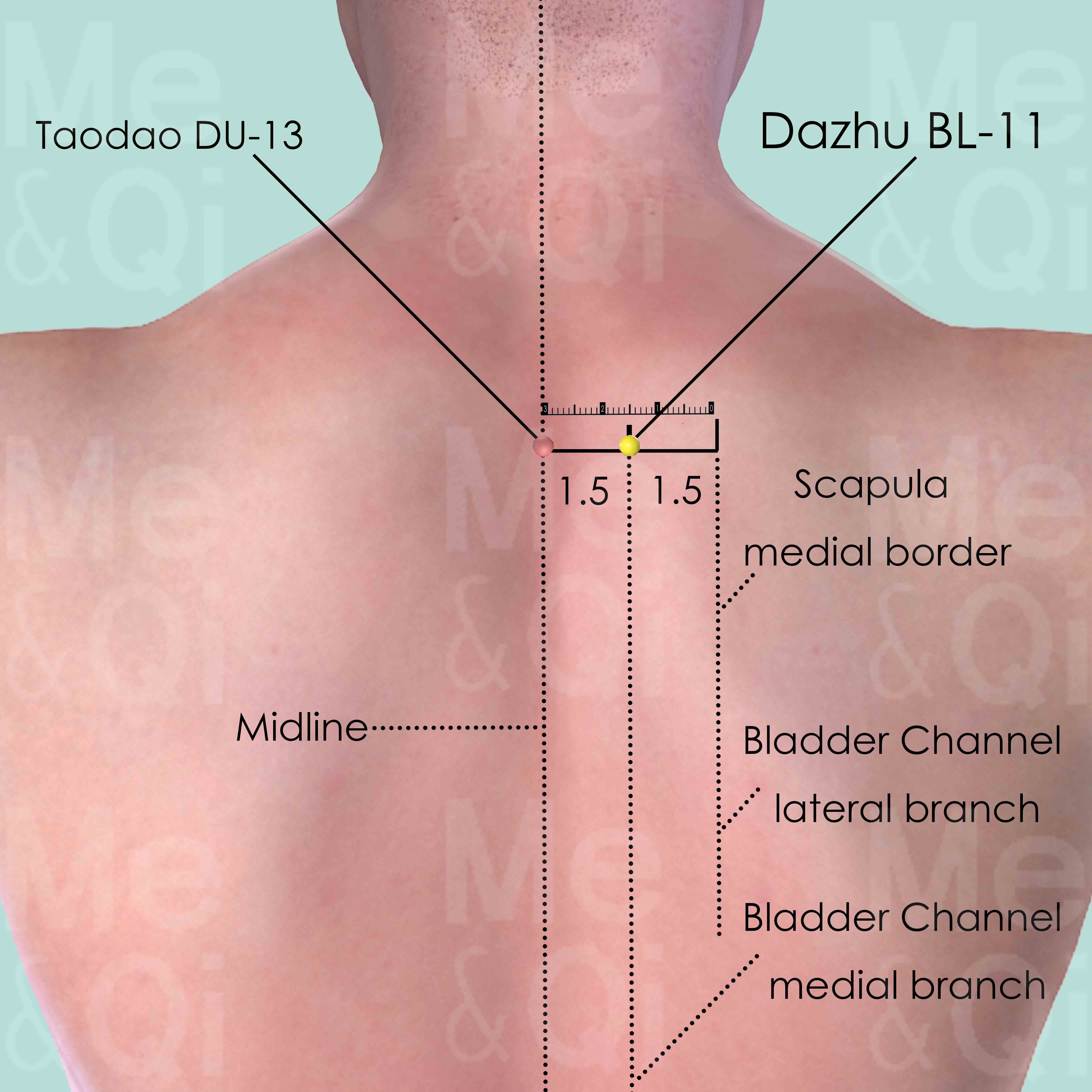
Dazhu BL-11
On the level of the lower border of the spinous process of the 1st thoracic vertebra (T1), 1.5 cun (about 2 finger-breadths) lateral to the posterior midline.
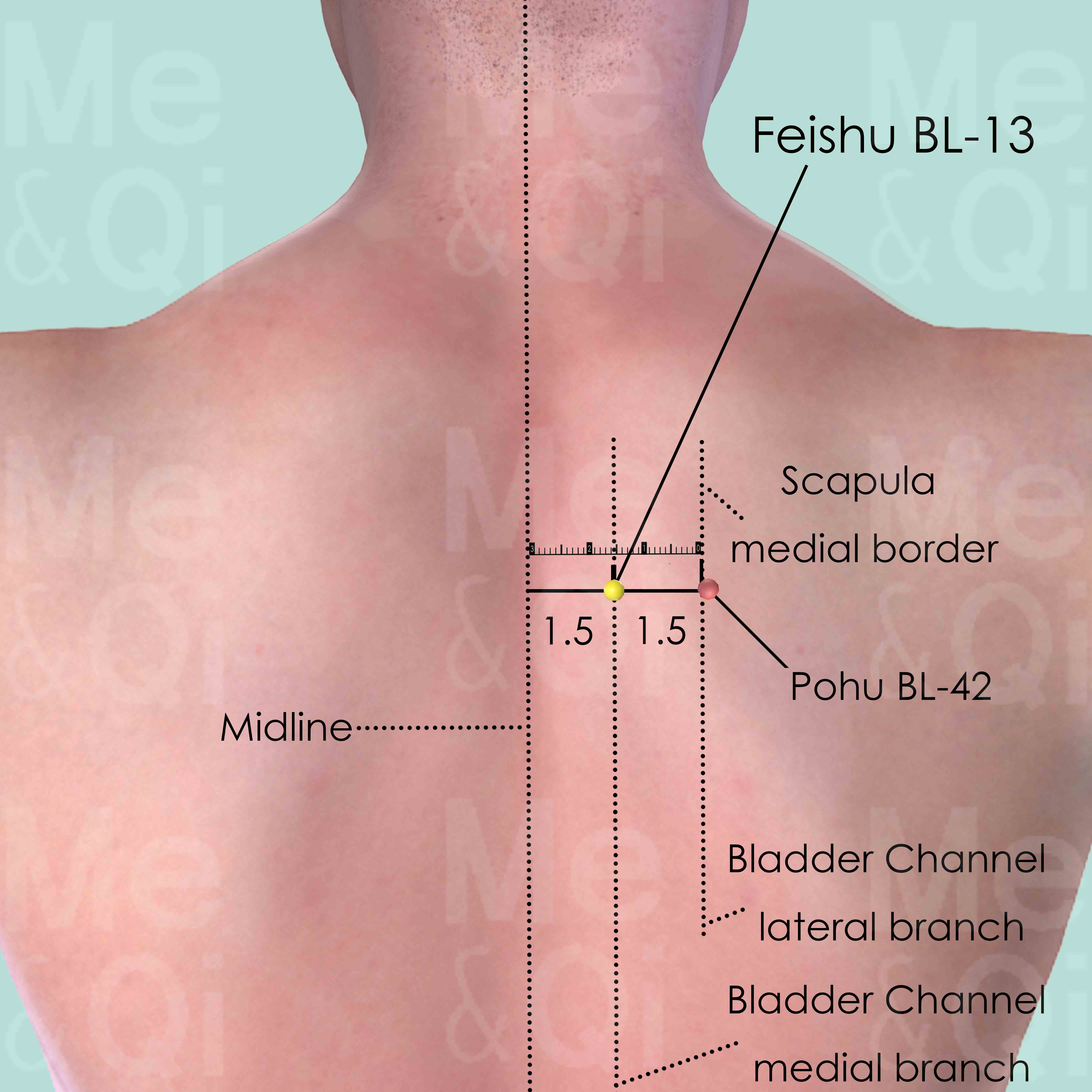
Feishu BL-13
1.5 cun lateral to the lower border of the spinous process of the 3rd thoracic vertebra (T3).
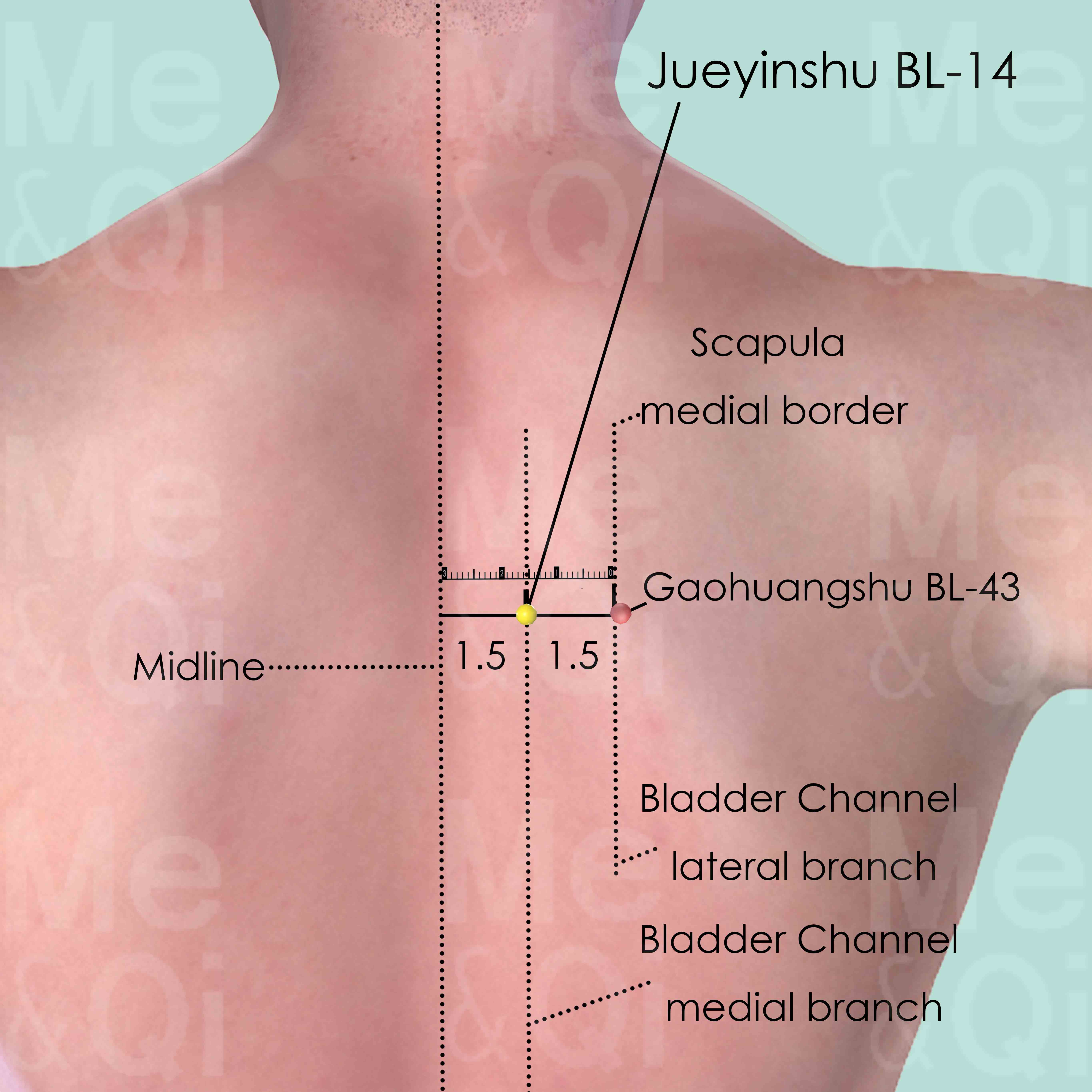
Jueyinshu BL-14
1.5 cun lateral to the lower border of the spinous process of the 4th thoracic vertebra (T4).
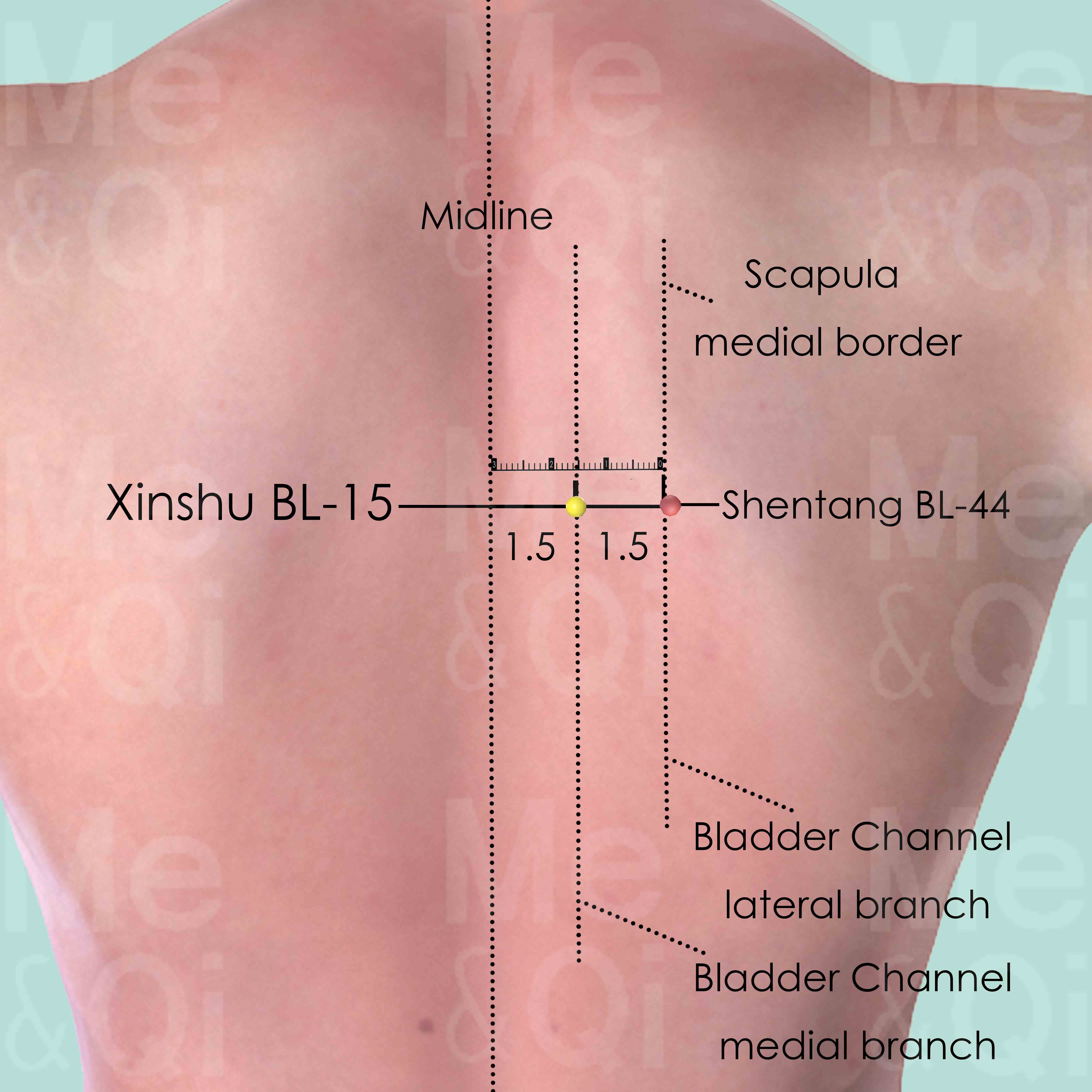
Xinshu BL-15
1.5 cun lateral to the lower border of the spinous process of the 5th thoracic vertebra (T5).
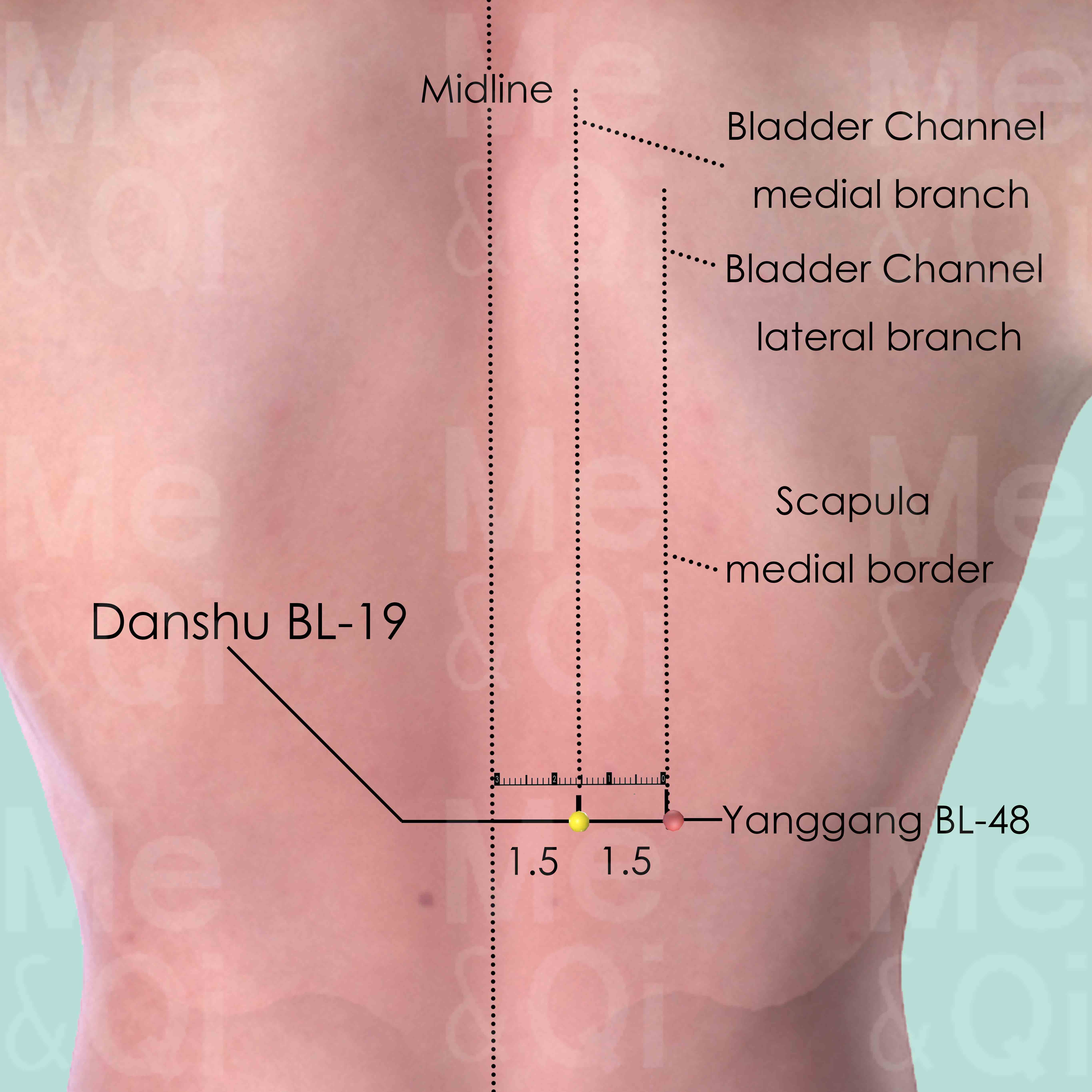
Danshu BL-19
1.5 cun lateral to the lower border of the spinous process of the 10th thoracic vertebra (T10).
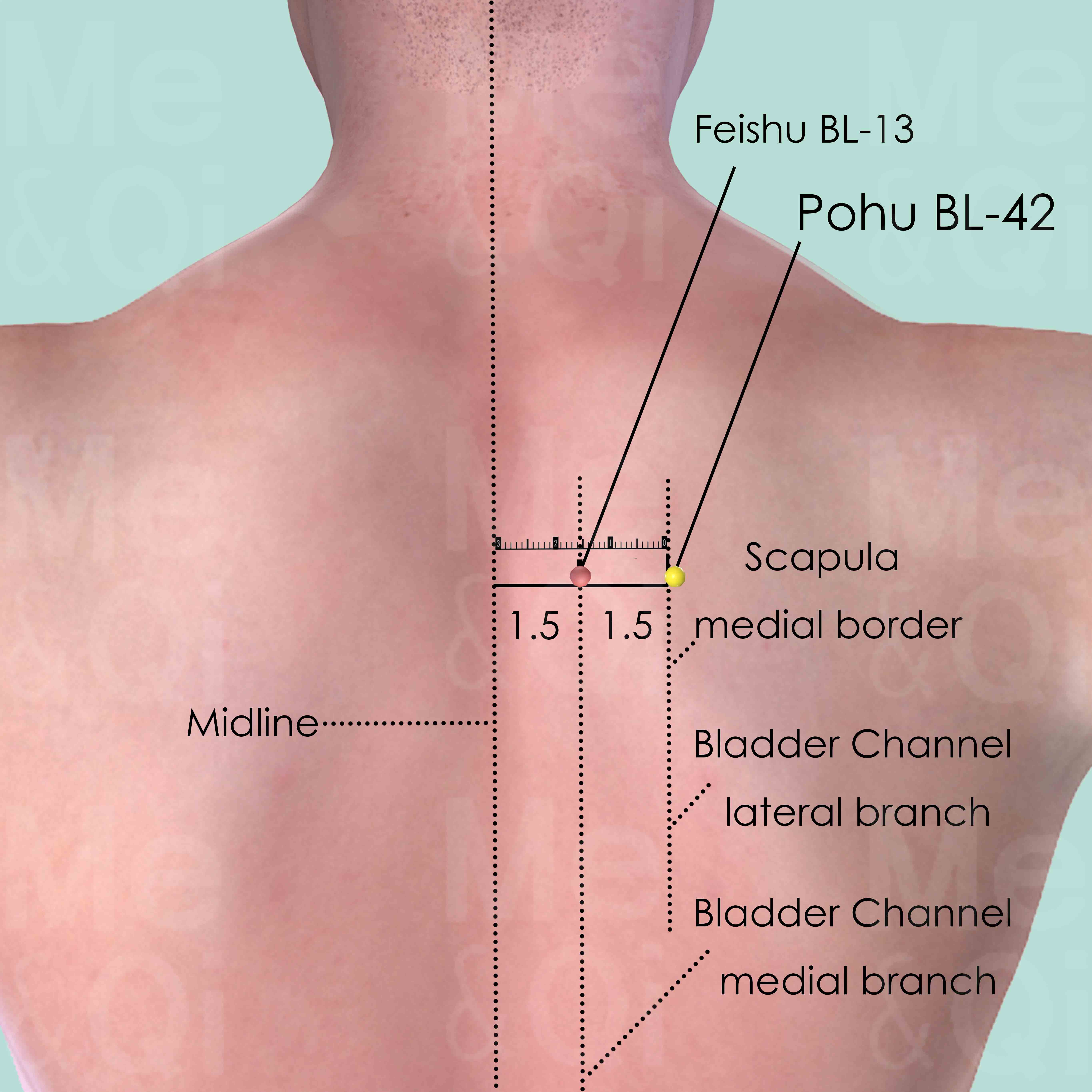
Pohu BL-42
3 cun (about 4 finger-breadths) lateral to the lower border of the spinous process of the 3rd thoracic vertebra (T3).
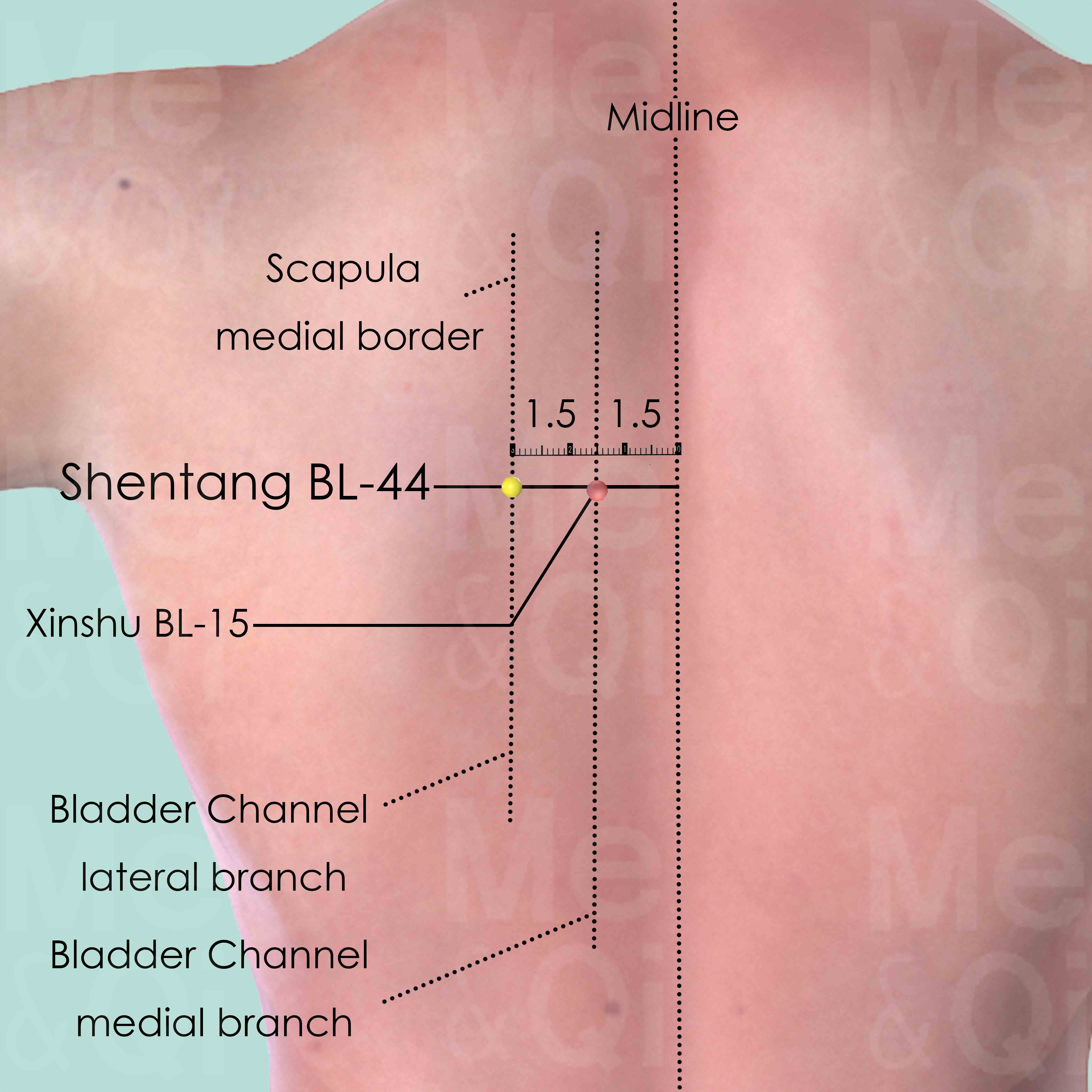
Shentang BL-44
3 cun (about 4 finger-breadths) lateral to the lower border of the spinous process of the 5th thoracic vertebra (T5).
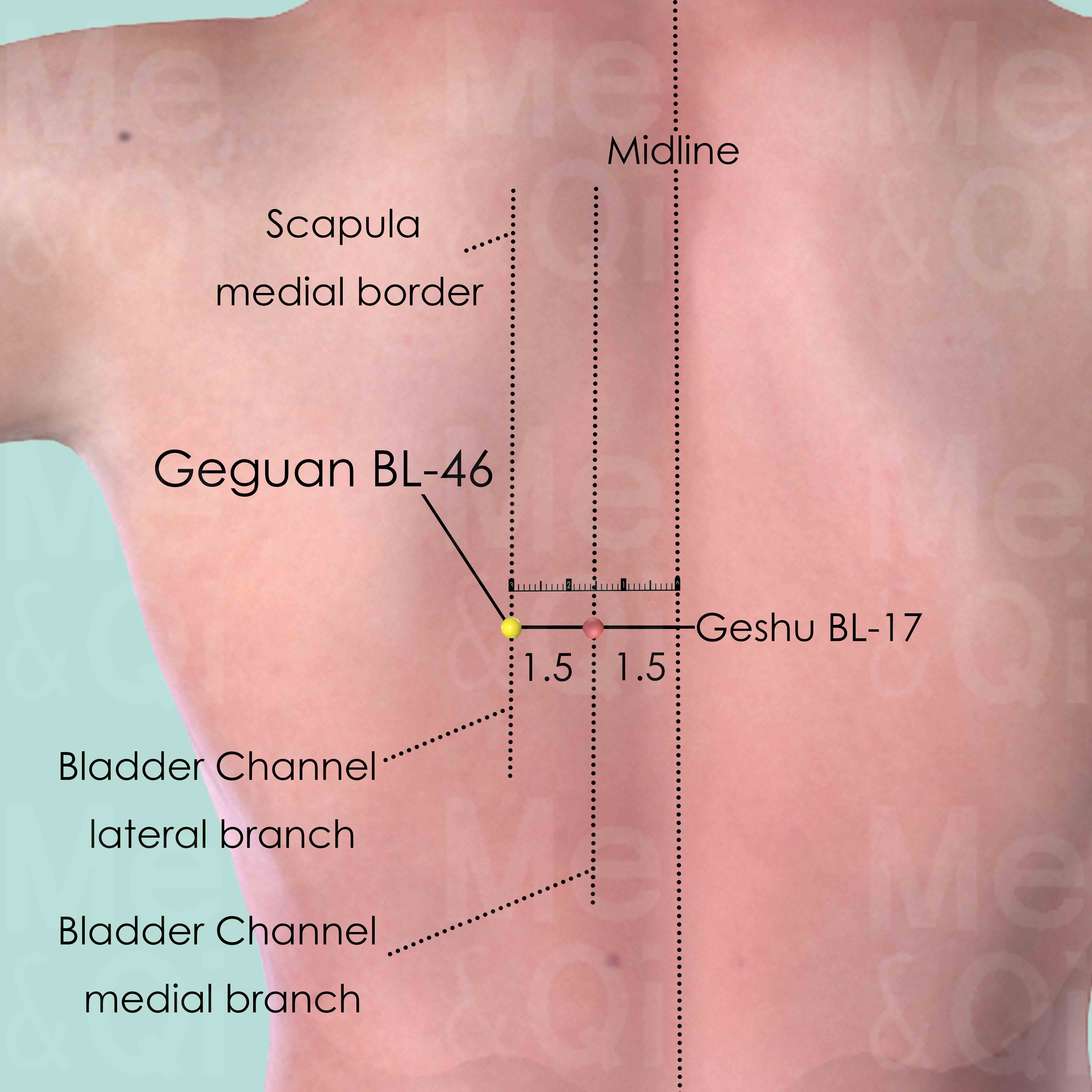
Geguan BL-46
3 cun (about 4 finger-breadths) lateral to the lower border of the spinous process of the 7th thoracic vertebra (T7).
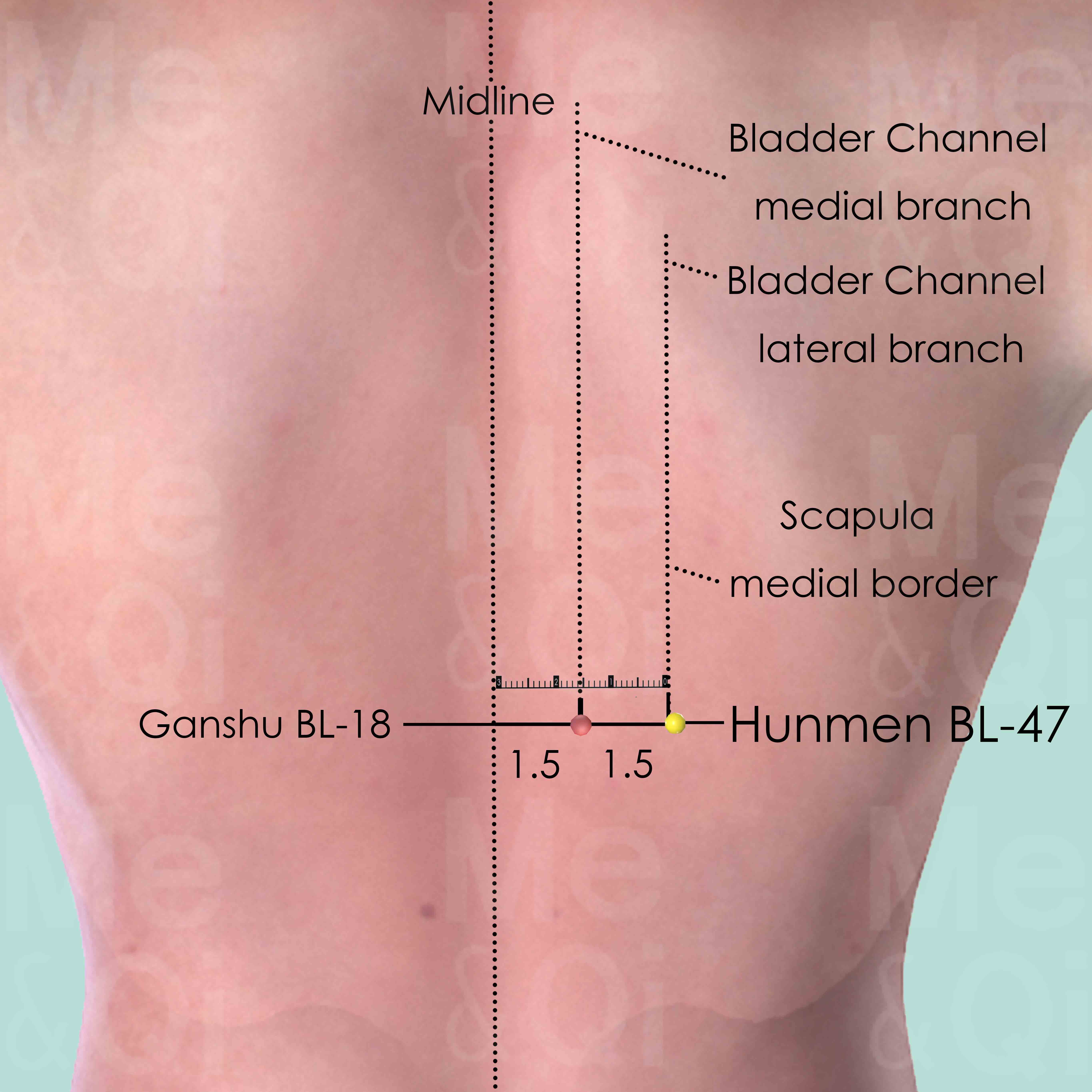
Hunmen BL-47
3 cun (about 4 finger-breadths) lateral to the lower border of the spinous process of the 9th thoracic vertebra (T9).
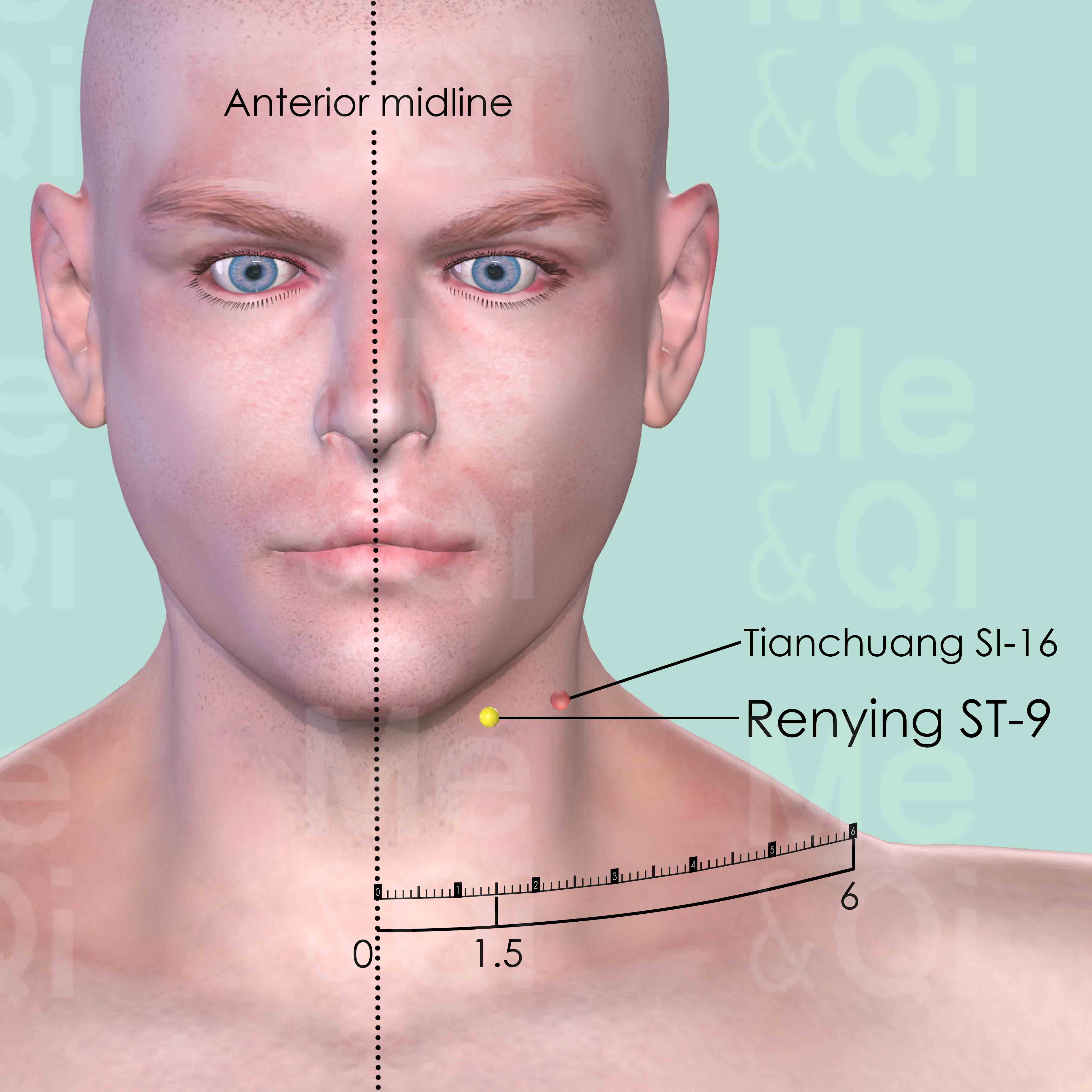
Renying ST-9
Level with the tip of Adam's apple, 1.5 cun lateral to the anterior midline, on the anterior border of the sternocleidomastoid muscle.
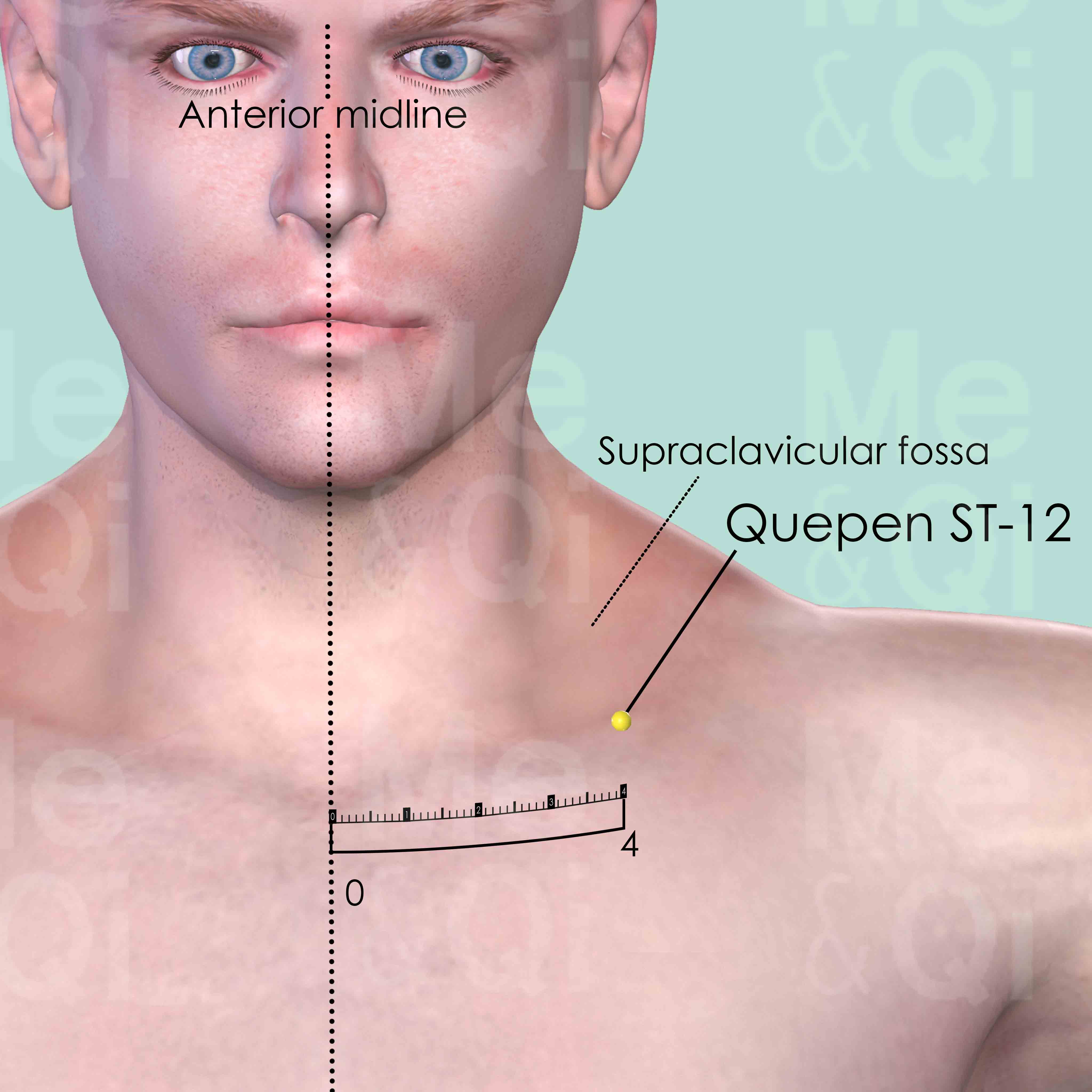
Quepen ST-12
About 4 cun lateral to the anterior midline, in the supraclavicular fossa, superior to the midpoint of the clavicle.
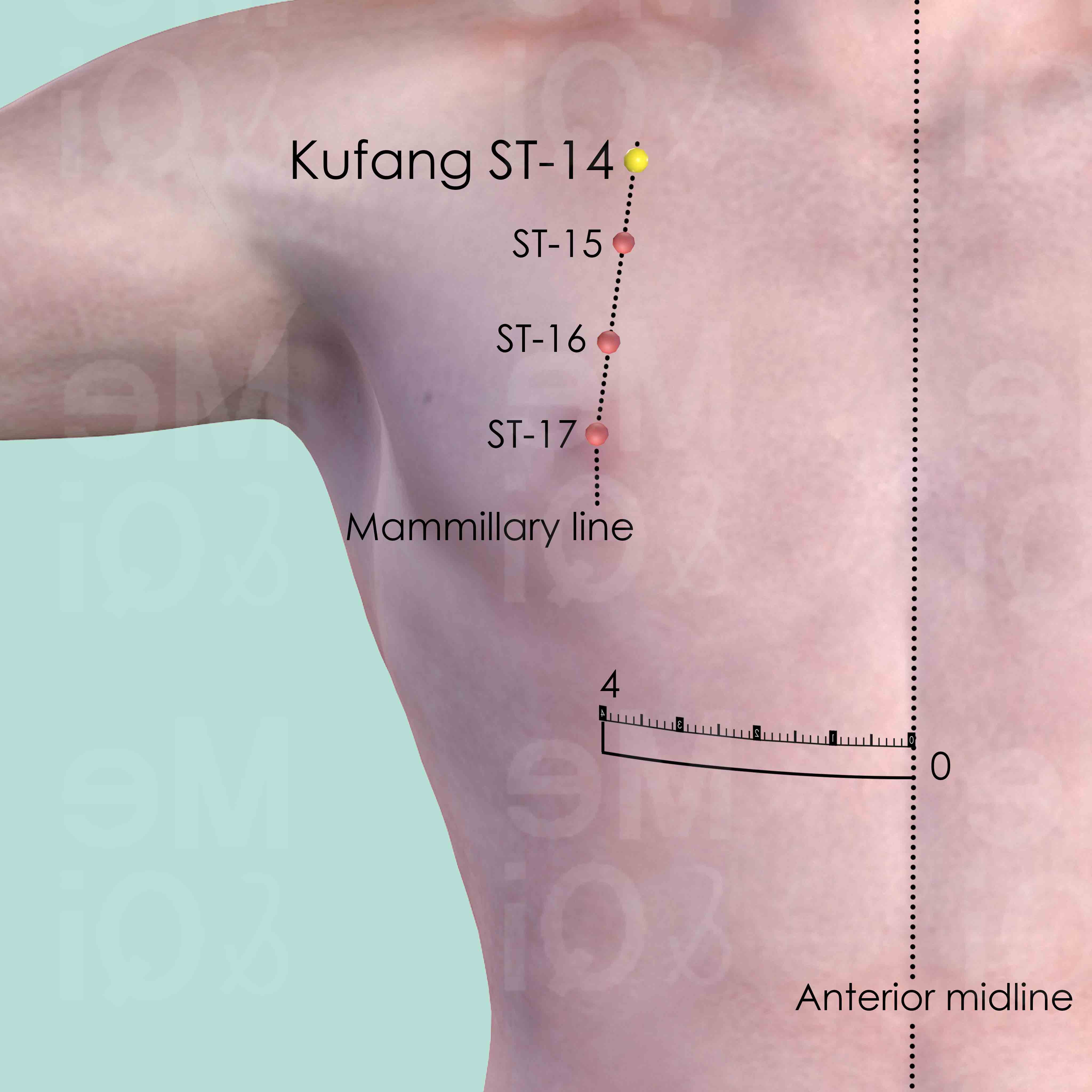
Kufang ST-14
In the 1st intercostal space, on the mammillary line, 4 cun lateral to the anterior midline.
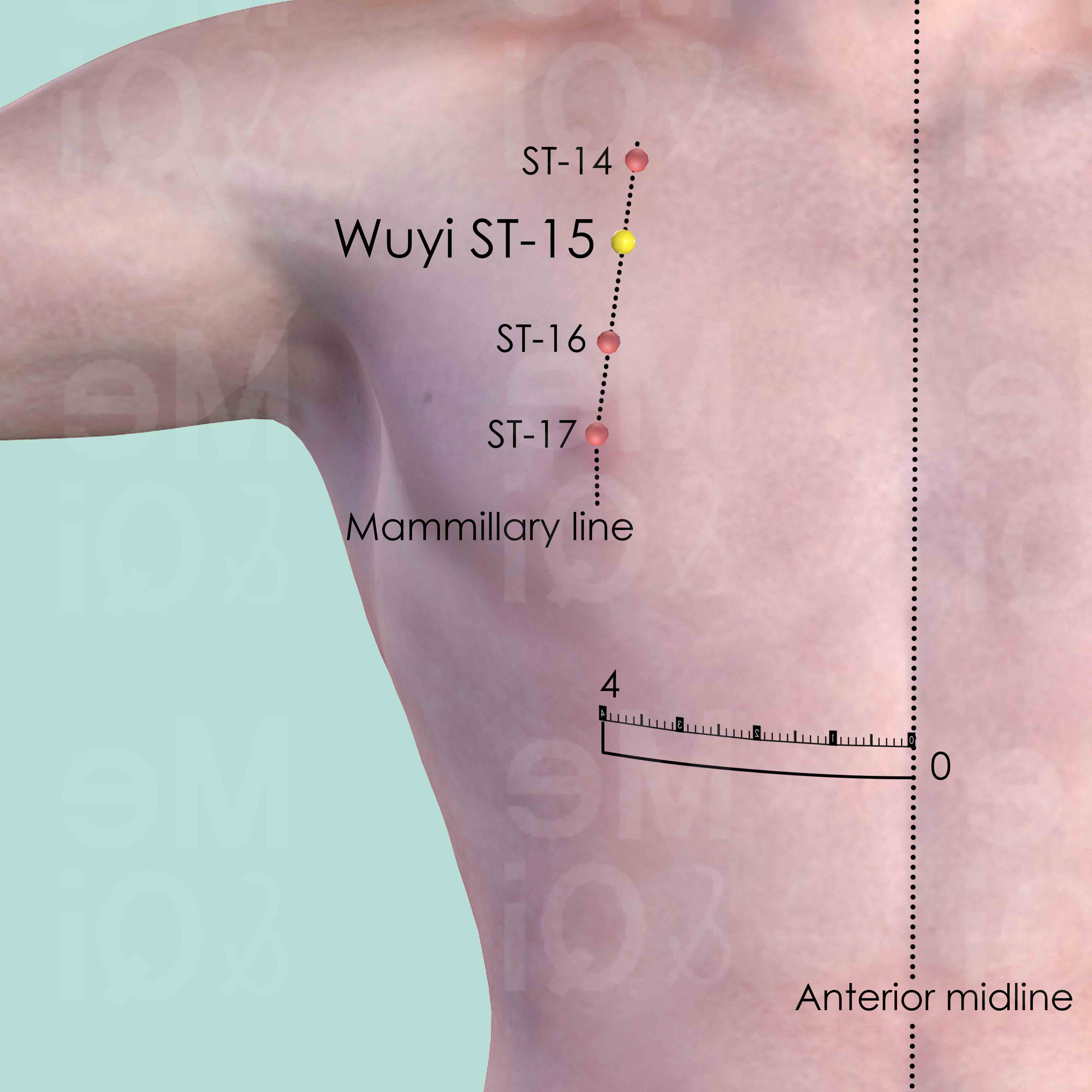
Wuyi ST-15
In the 2nd intercostal space, on the mammillary line, 4 cun lateral to the anterior midline.
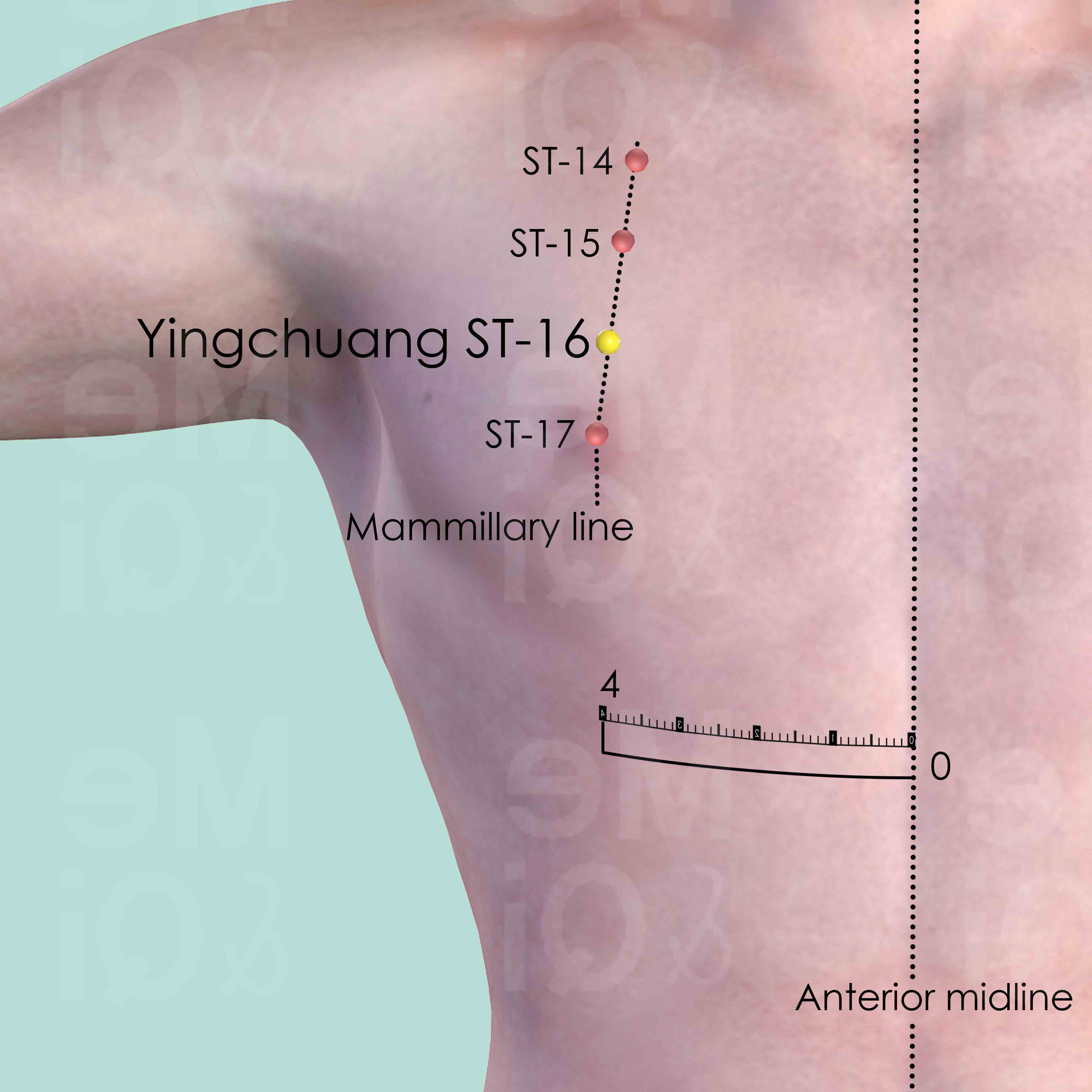
Yingchuang ST-16
In the 3nd intercostal space, on the mammillary line, 4 cun lateral to the anterior midline.
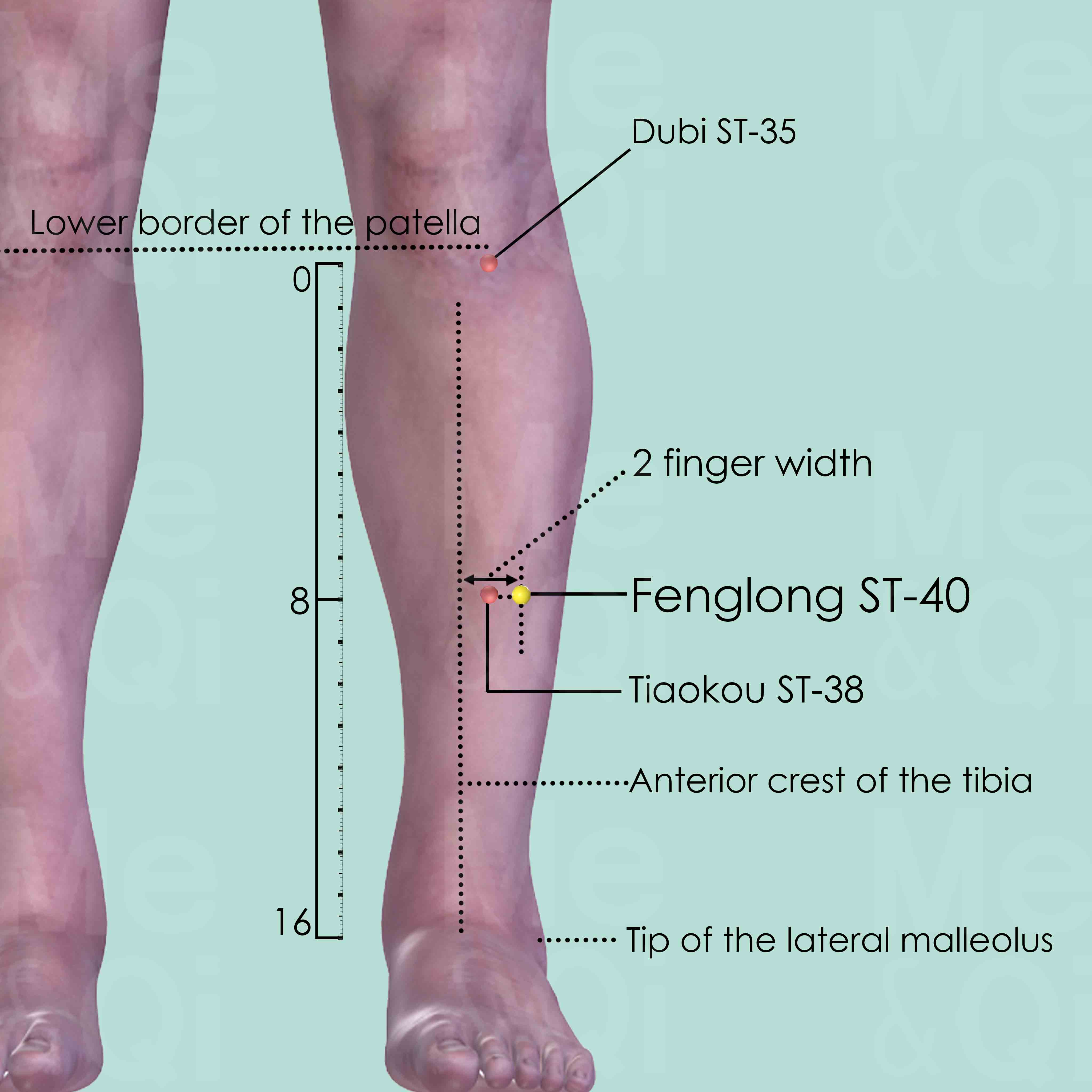
Fenglong ST-40
Midway between Dubi ST-35 and Jiexi ST-41, two middle finger-width from the anterior crest of the tibia, or one middle finger-width from Tiaokou ST-38.
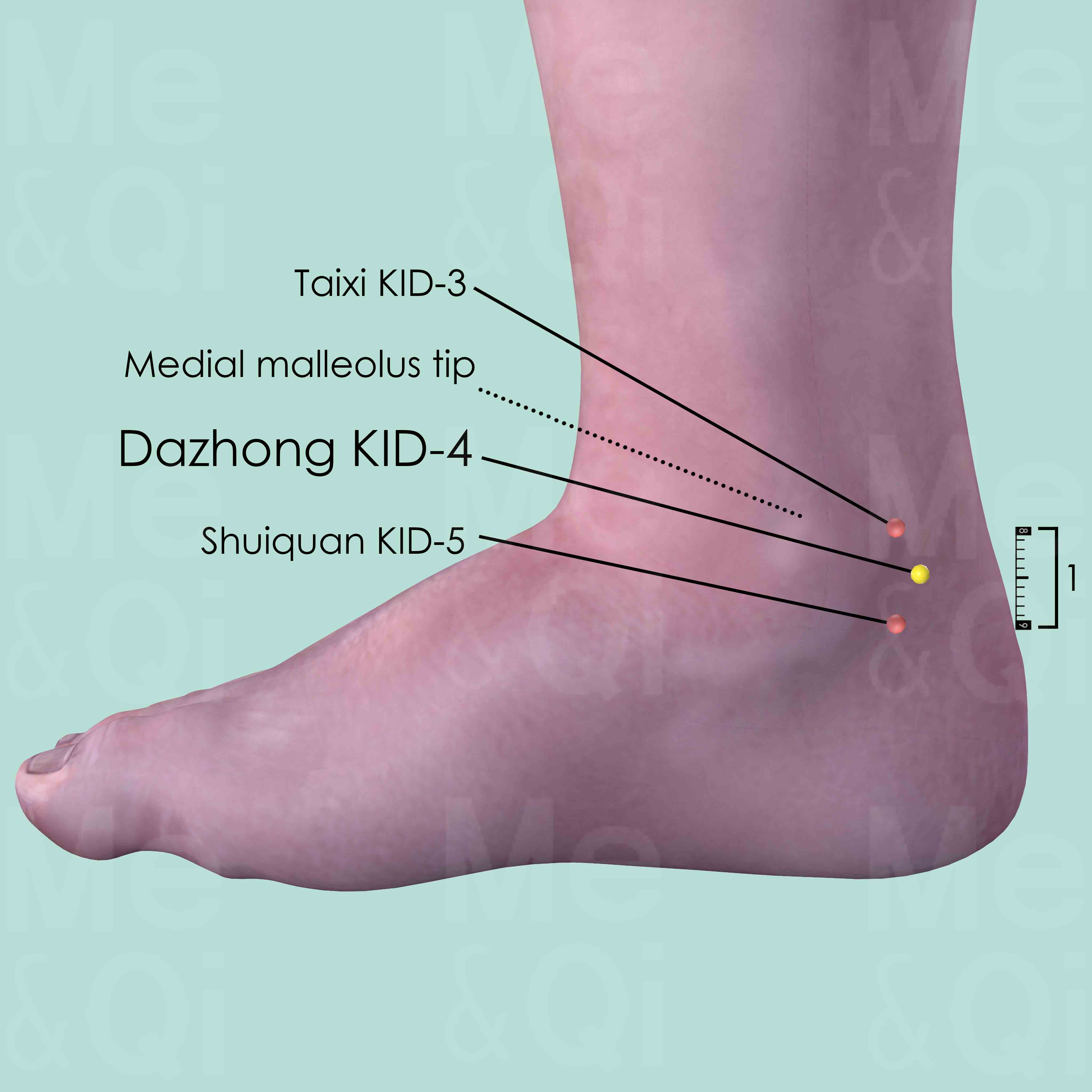
Dazhong KID-4
Posterior and inferior to the medial malleolus, in the depression medial to the Achilles tendon, superior to its insertion at the calcaneus.
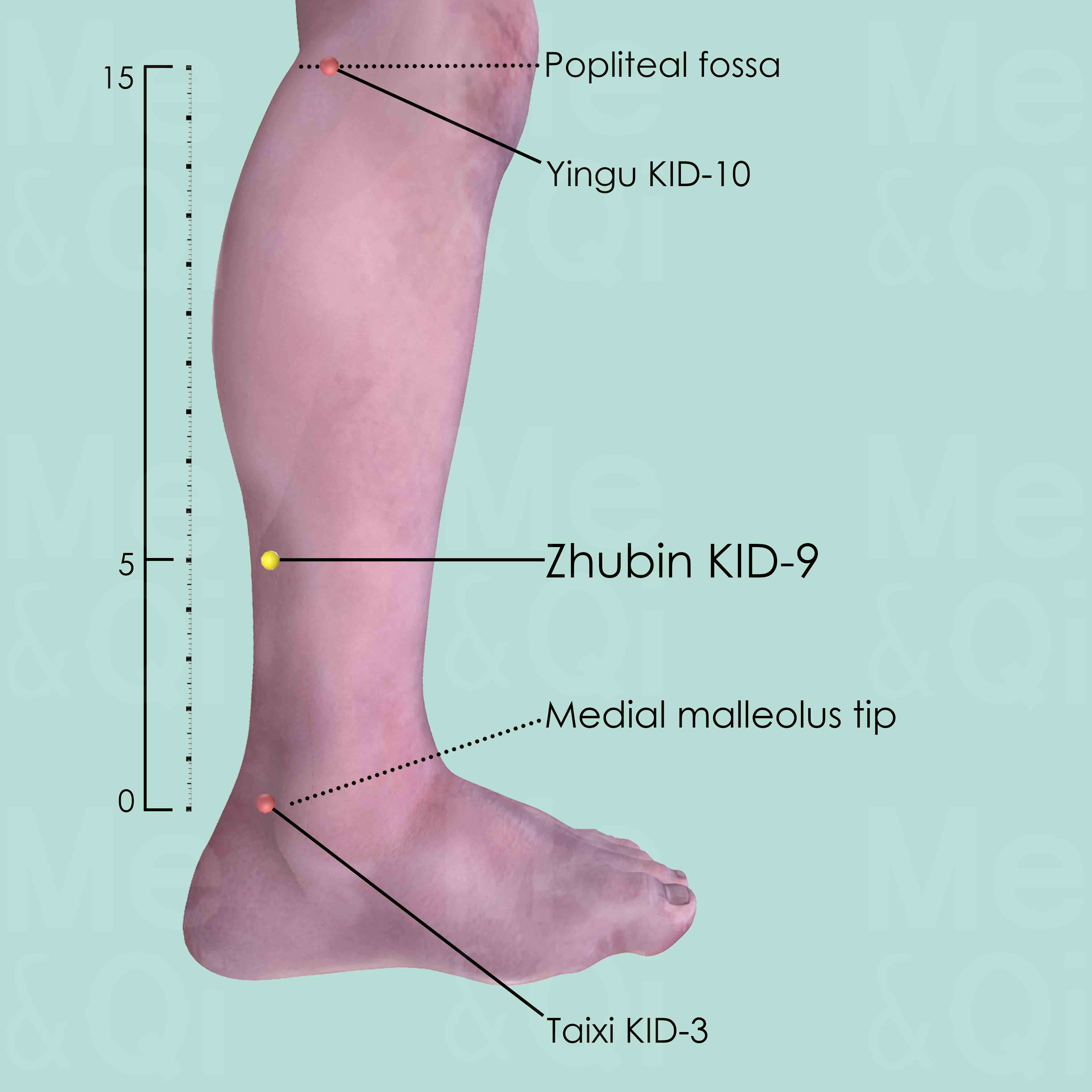
Zhubin KID-9
On the line drawn from Taixi KID-3 to Yingu KID-10. It is located at the lower end of the belly of gastrocnemius muscle in the medial aspect, about 5 cun above Taixi KID-3.
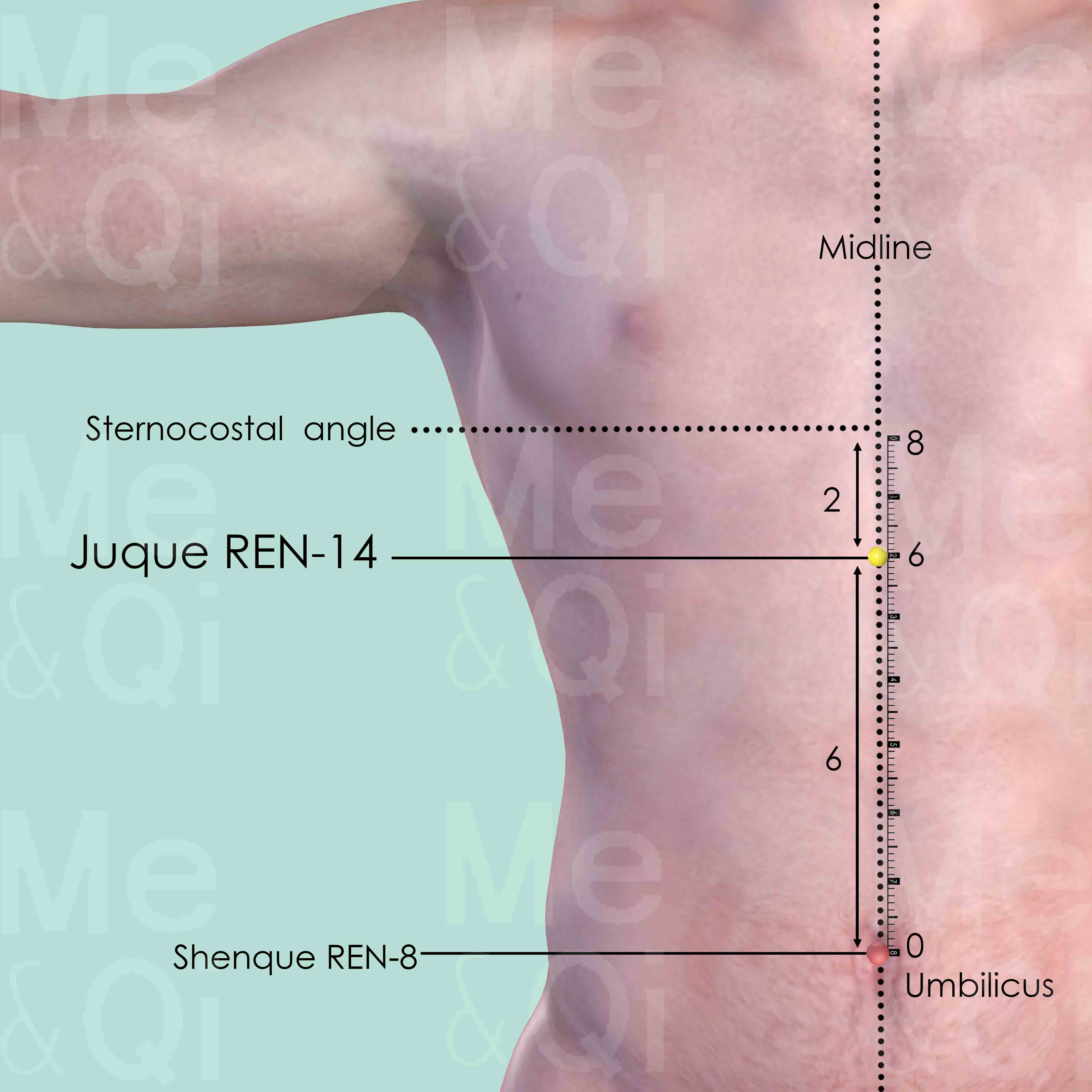
Juque REN-14
On the midline of the abdomen, 6 cun above the umbilicus and 2 cun below the sternocostal angle.
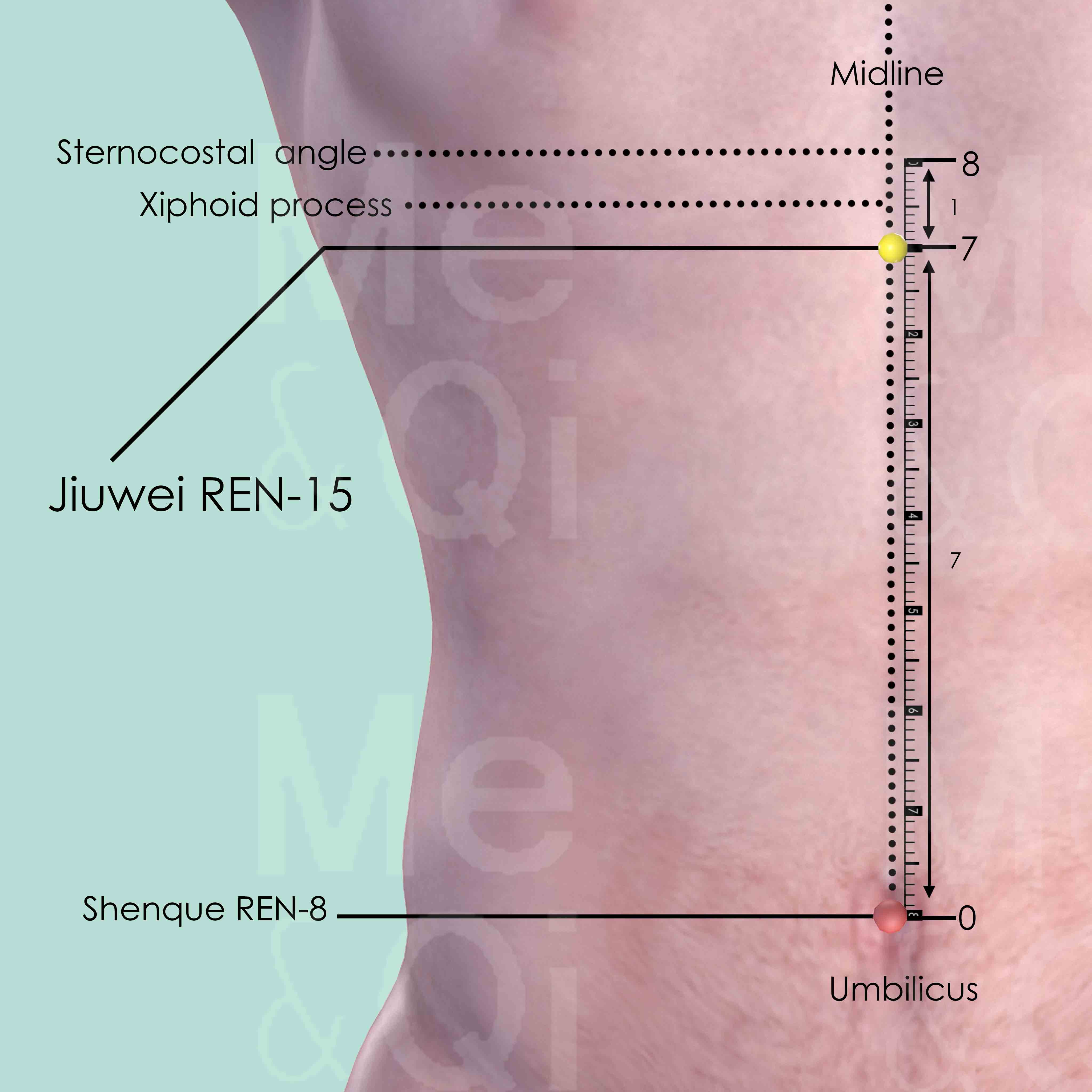
Jiuwei REN-15
On the midline of the abdomen, 7 cun above the umbilicus and 1 cun below the sternocostal angle. This point is located at the tip of the xiphoid process, which is commonly known as ‘dove-tail’ in China, hence the name of the point.
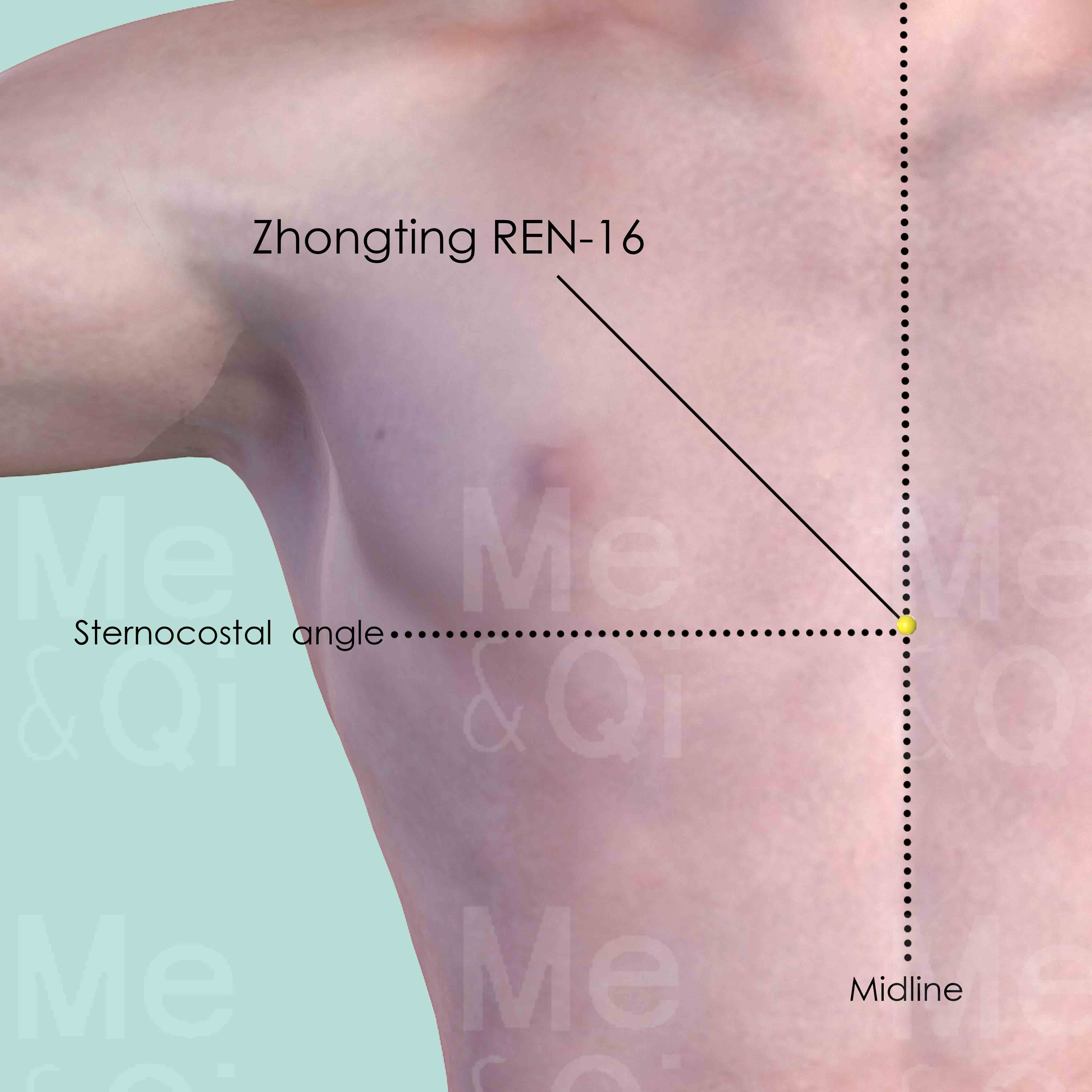
Zhongting REN-16
On the midline of the chest, on the level of the 5th intercostal space. On the sternocostal angle, where the two lower borders of the ribcage meet.
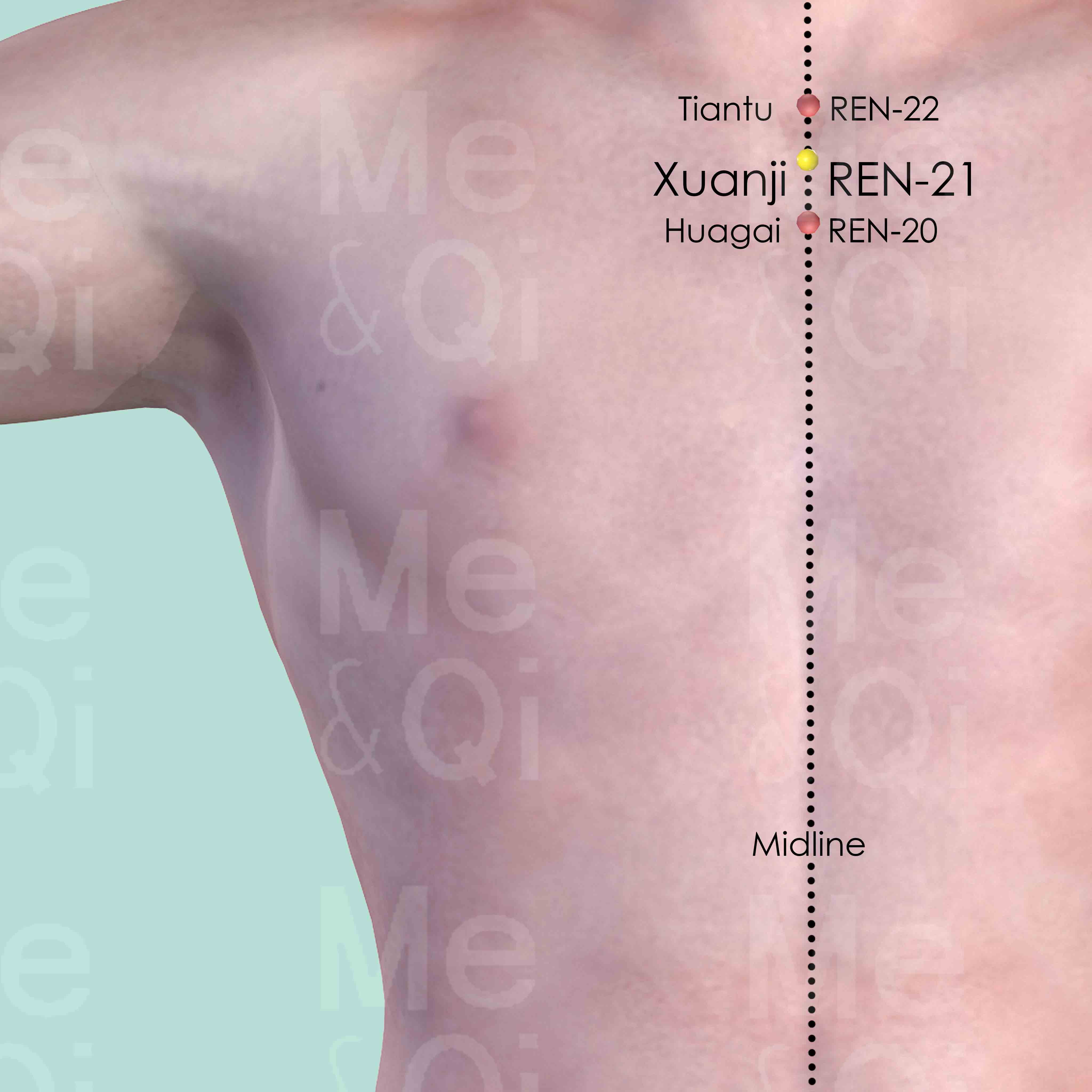
Xuanji REN-21
On the midline of the sternum, below the upper border of the manubrium sterni and midway between Huagai REN-20 and Tiantu REN-22.
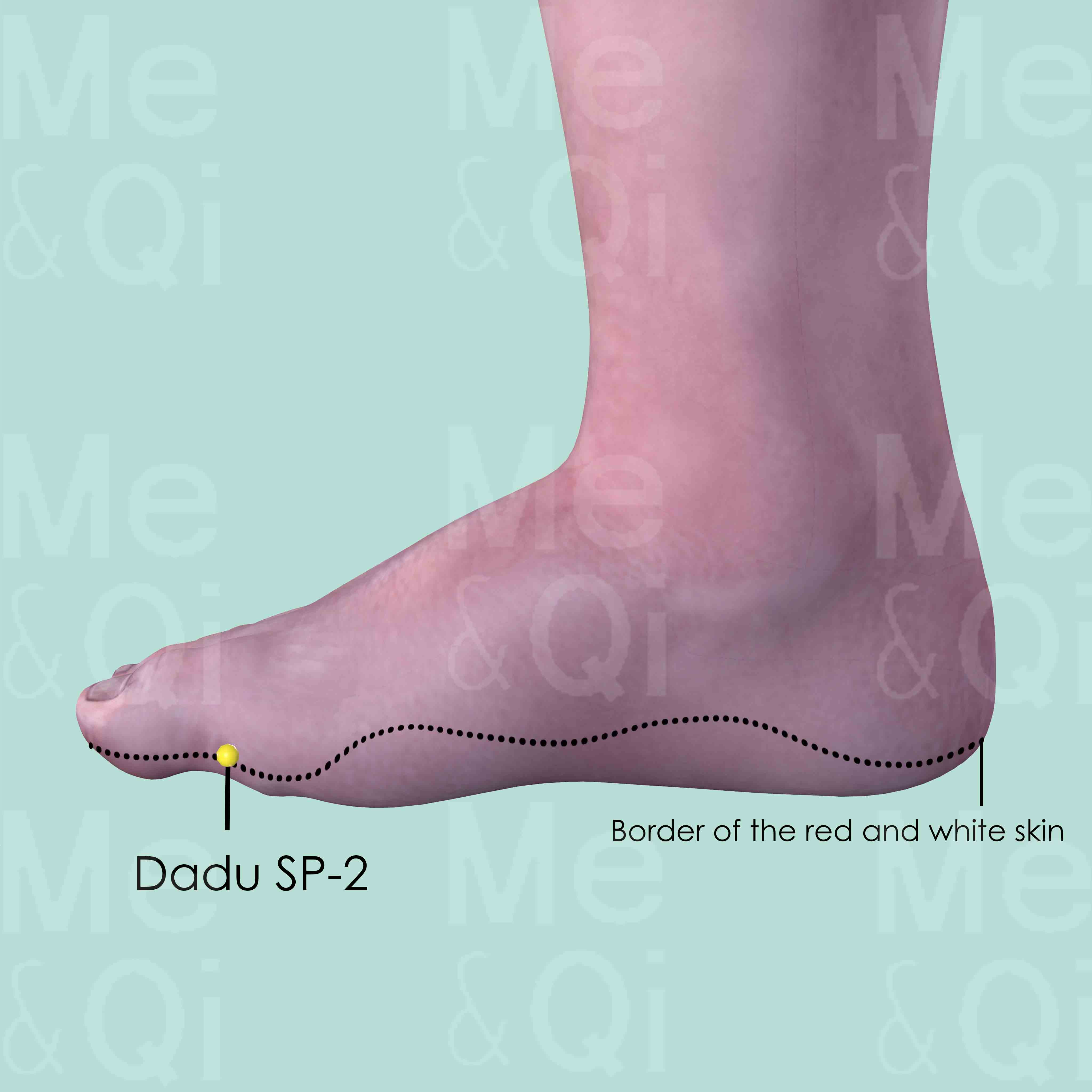
Dadu SP-2
On the medial aspect of the big toe, at the junction of the shaft and the base of the proximal phalanx, distal to the 1st metatarsophalangeal joint.
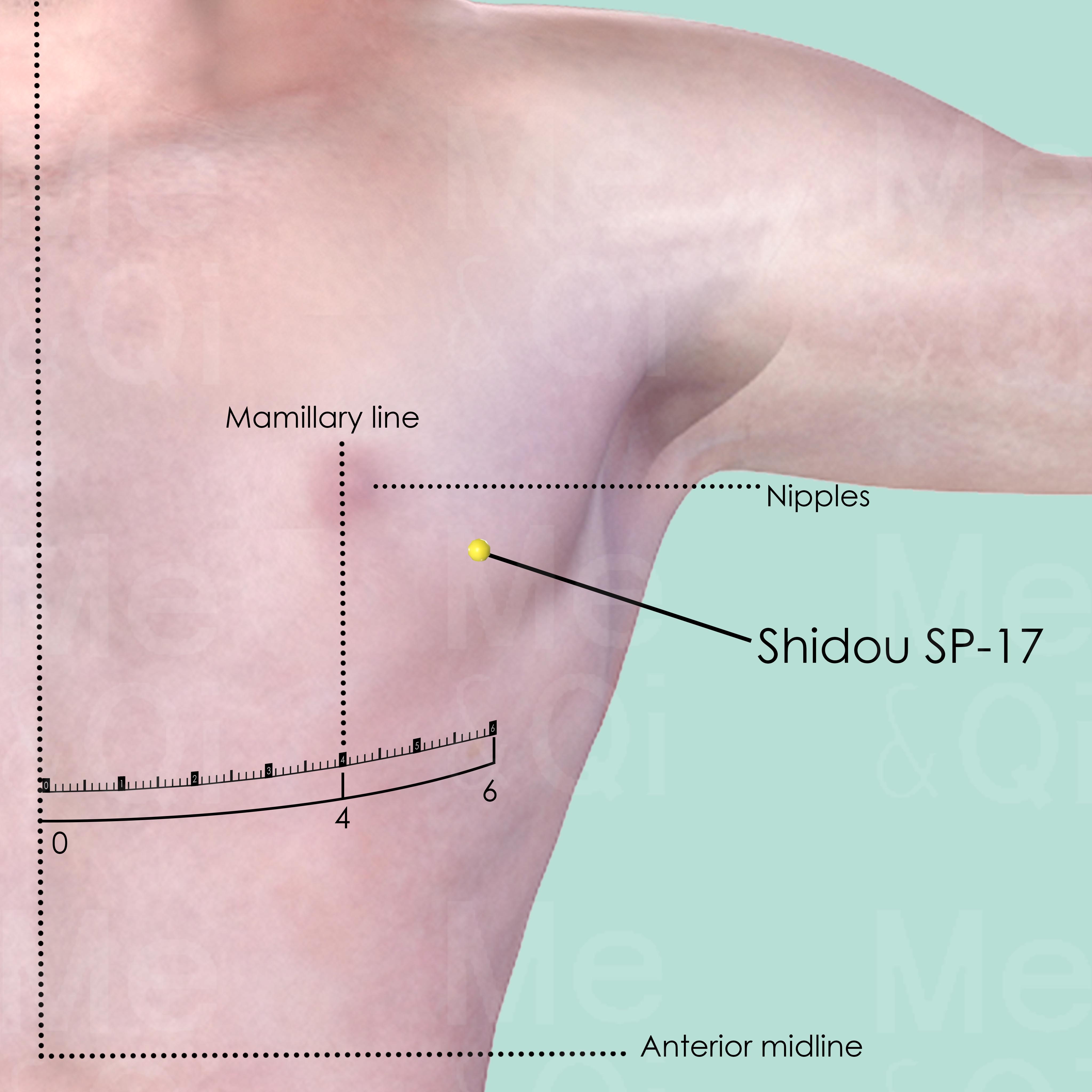
Shidou SP-17
6 cun lateral to the anterior midline, 2 cun lateral to the mamillary line, in the 5th intercostal space.
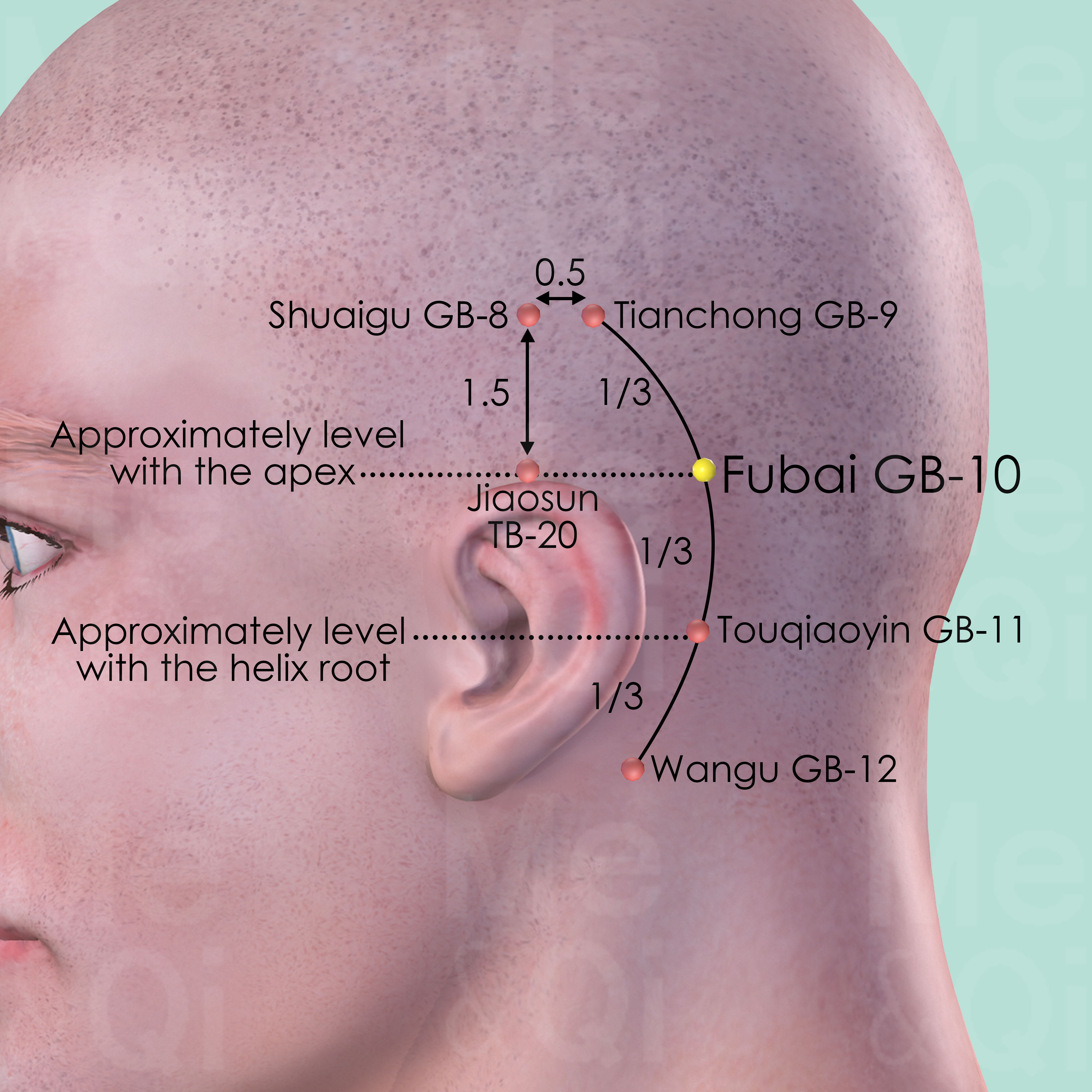
Fubai GB-10
Posterior and superior to the mastoid process, at the junction of the upper third and the two lower thirds of the curved line connecting Tianchong GB-9 and Wangu GB-12.
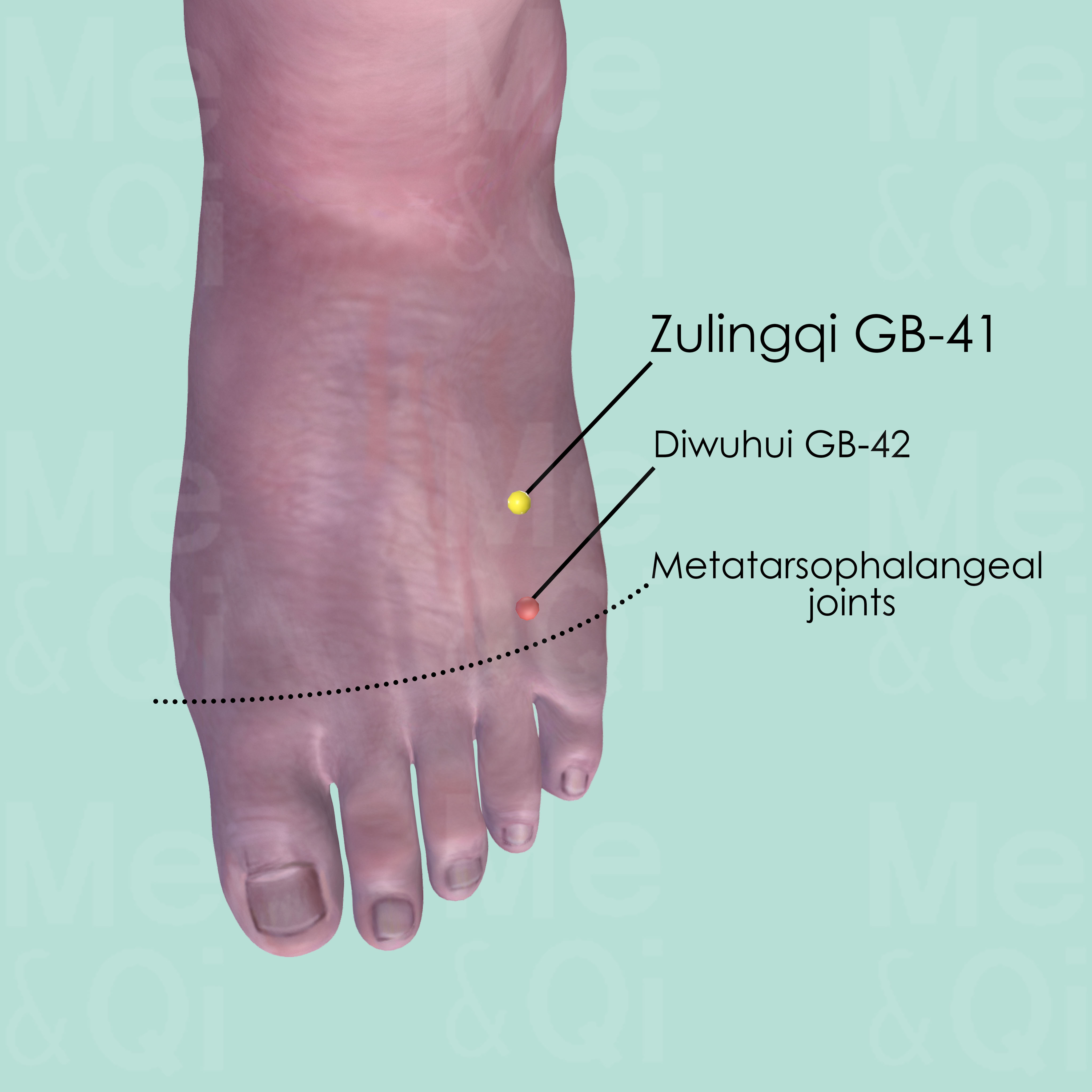
Zulingqi GB-41
In the depression distal to the junction of the 4th and 5th metatarsal bones, on the lateral side of the tendon of extensor digitorum longus muscle of the foot.
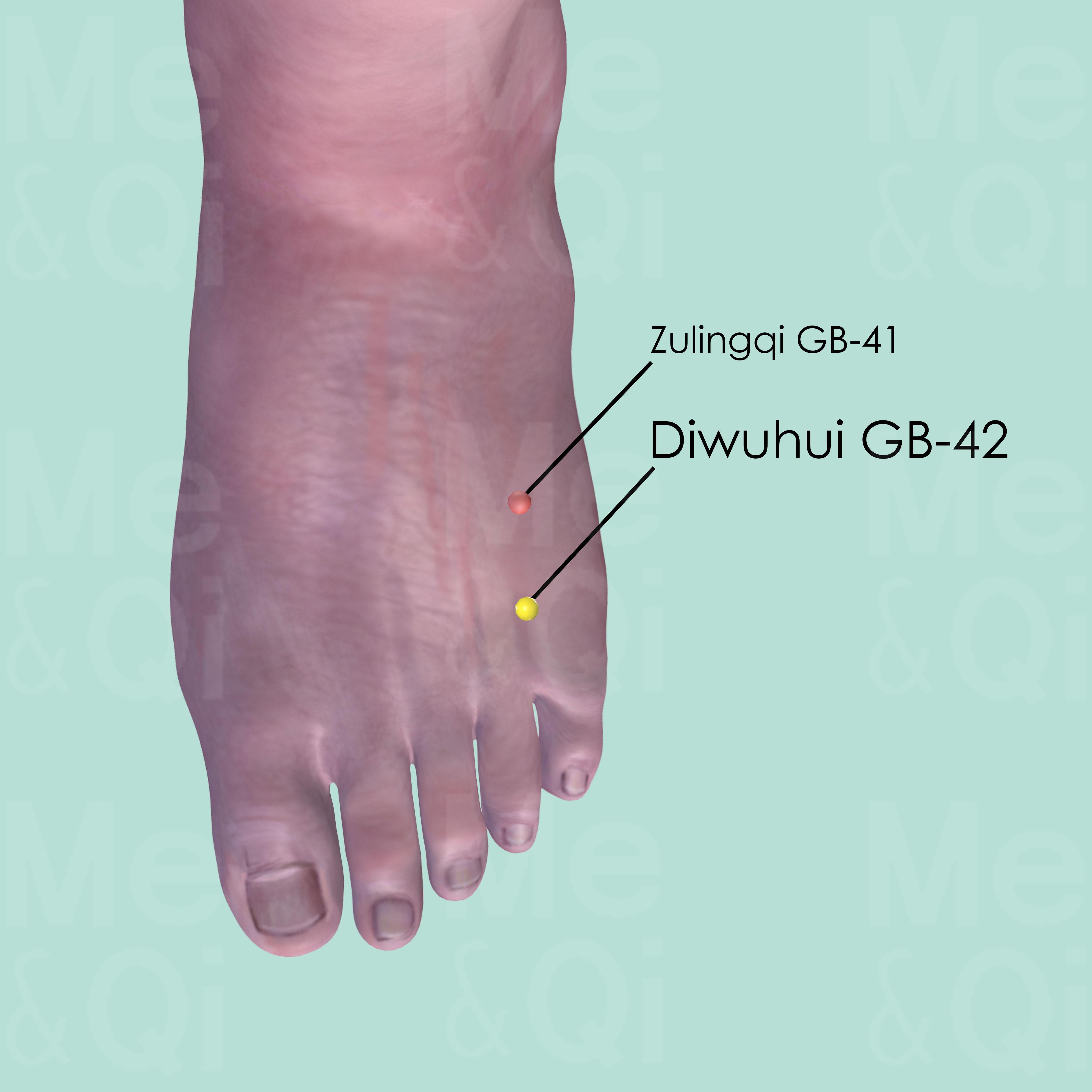
Diwuhui GB-42
Between the 4th and 5th metatarsal bones, on the medial side of the tendon of extensor digitorum longus muscle of the little toe.
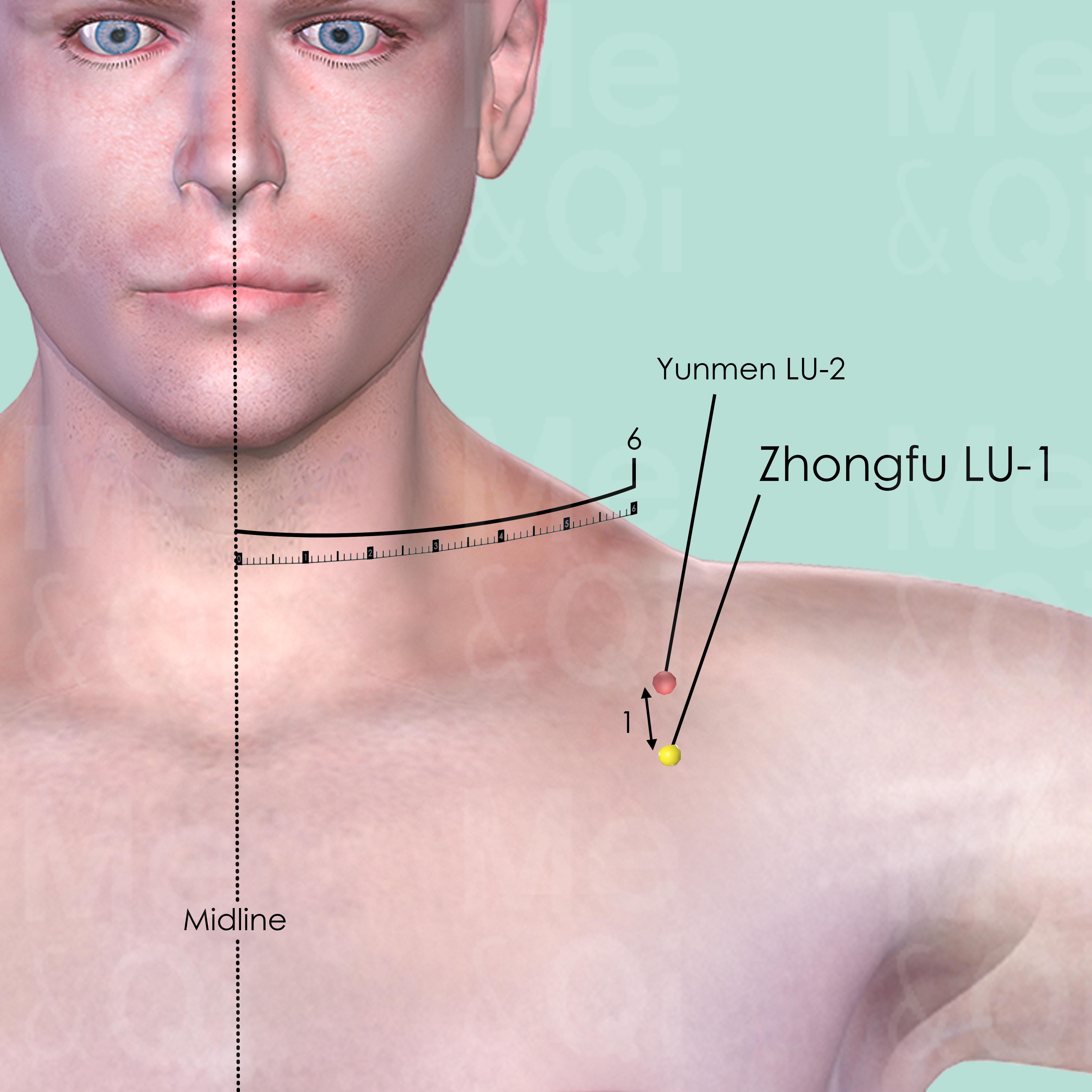
Zhongfu LU-1
On the lateral aspect of the chest, in the 1st intercostal space, 6 cun lateral to the midline, 1 cun inferior to Yunmen LU-2. Below the acromial extremity of the clavicle, slightly medial to the lower border of the coracoid process.
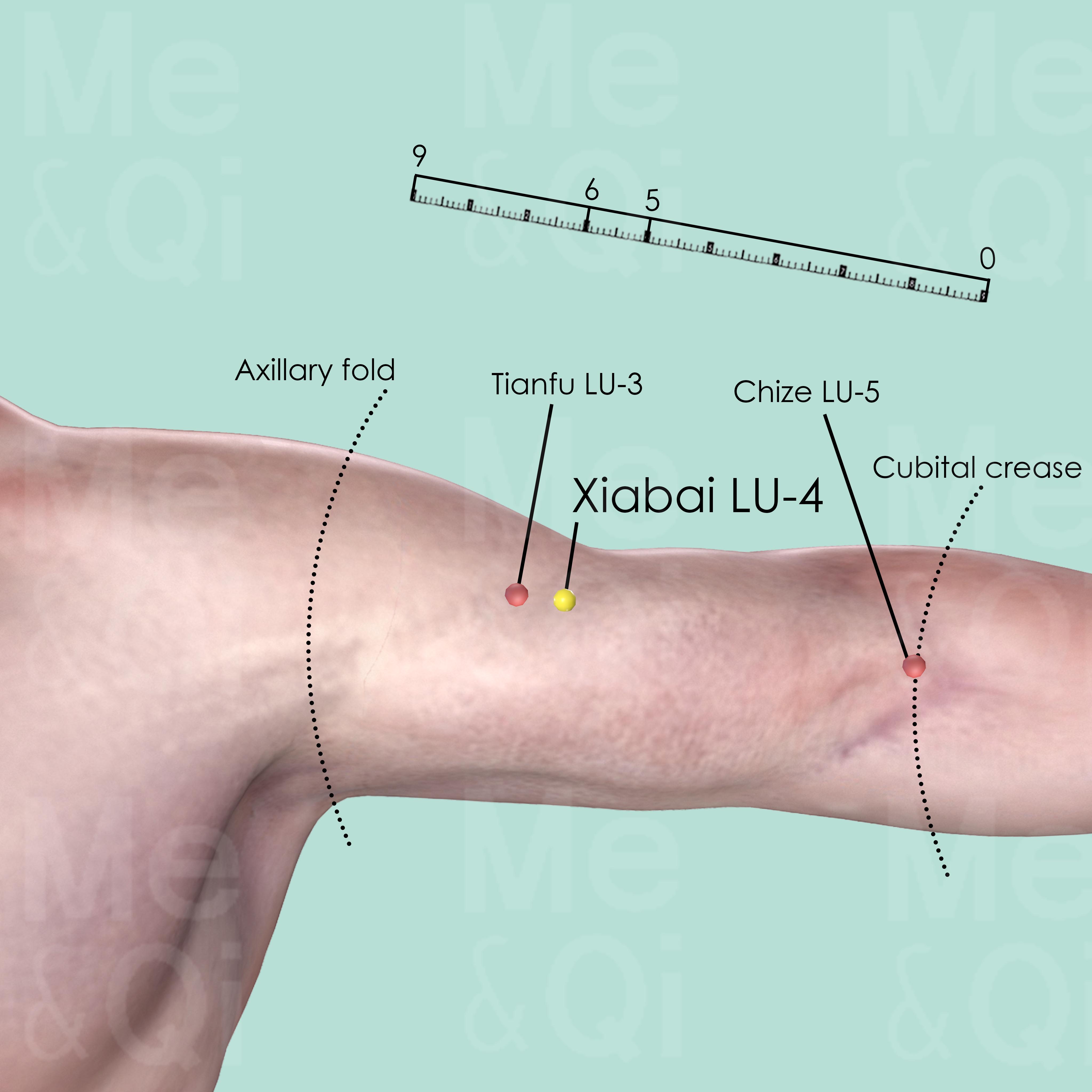
Xiabai LU-4
On the medial aspect of the upper arm, 1 cun below Tianfu LU-3, on the radial side of biceps brachii muscle.
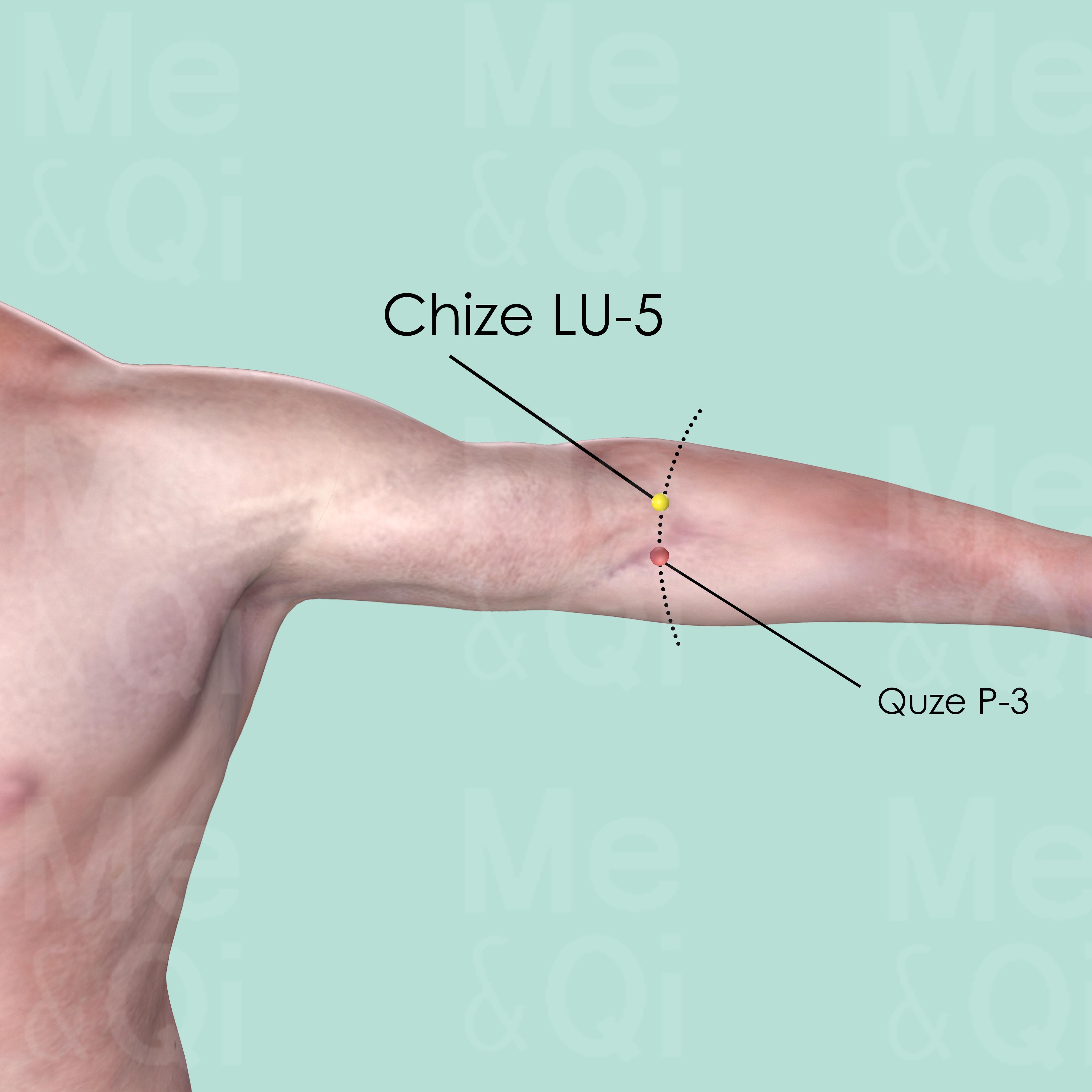
Chize LU-5
On the cubital crease, on the redial aspect of the biceps tendon. It can be easily identified when the elbow is slightly flexed.
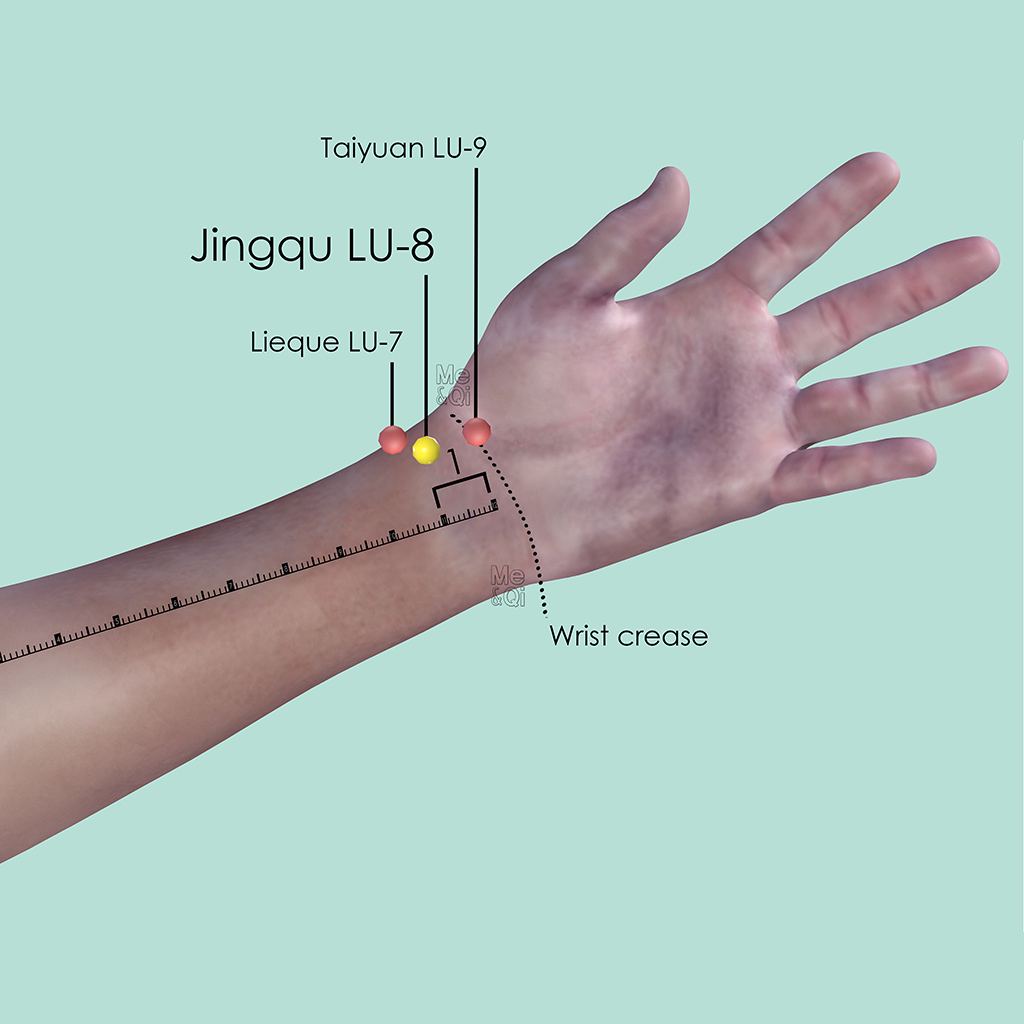
Jingqu LU-8
1 cun proximal to the wrist crease (wrist joint space), in the depression on the radial side of the radial artery.
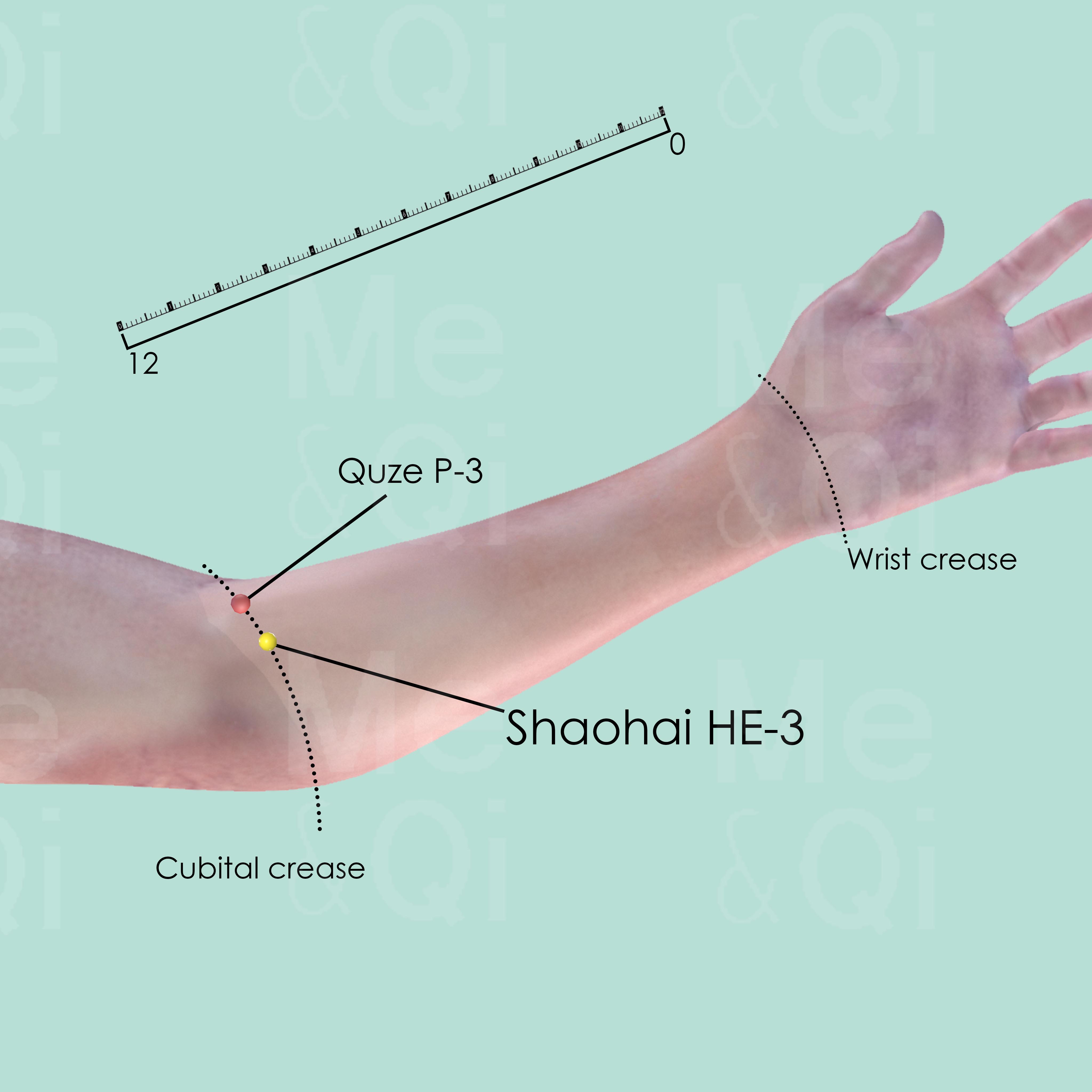
Shaohai HE-3
When the elbow is flexed slightly, Shaohai HE-3 is at the medial end of the transverse cubital crease, in the depression radius to the medial epicondyle of the humerus.
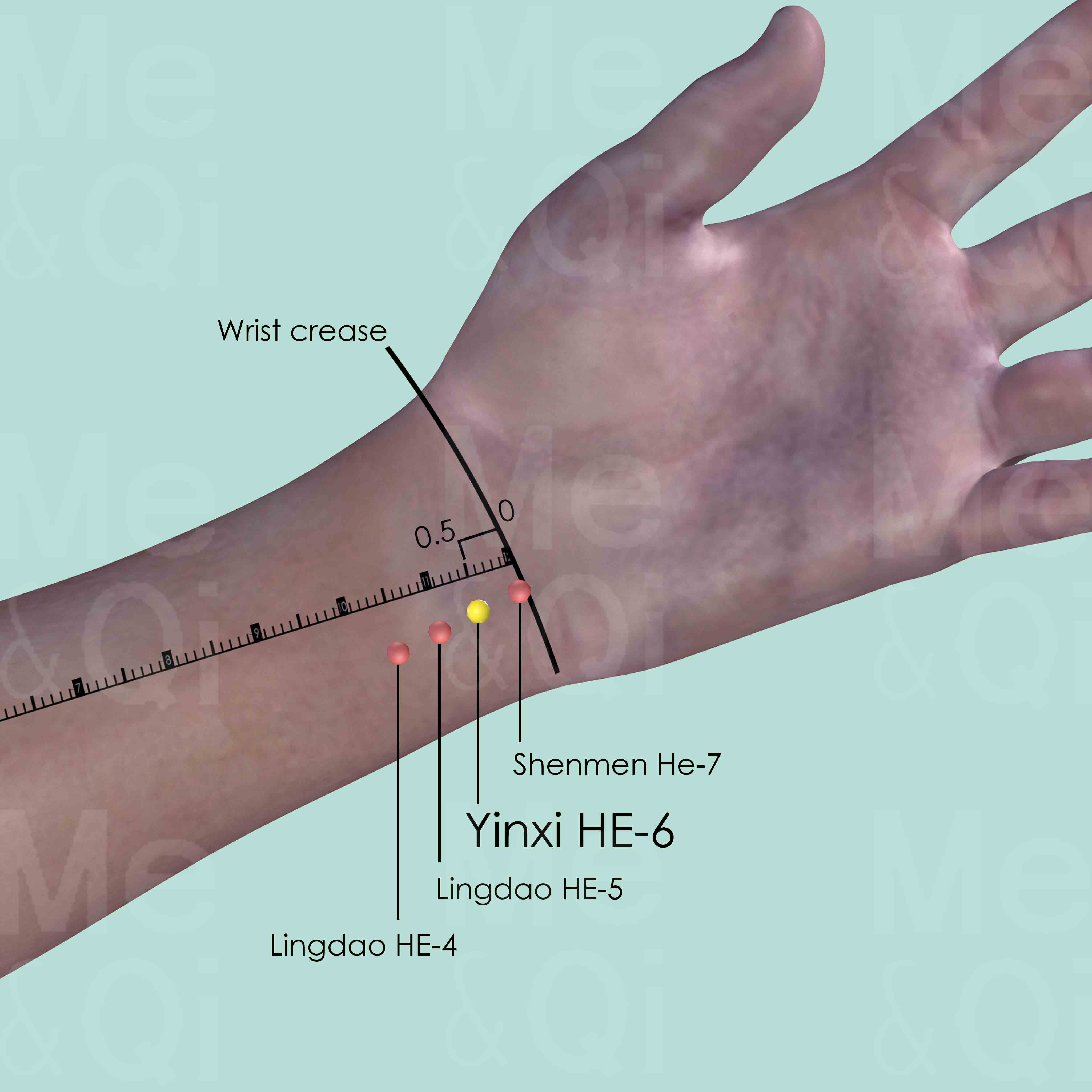
Yinxi HE-6
On the radial side of the tendon of flexor carpi ulnaris muscle, 0.5 cun above the transverse crease of the wrist when the palm faces upward.
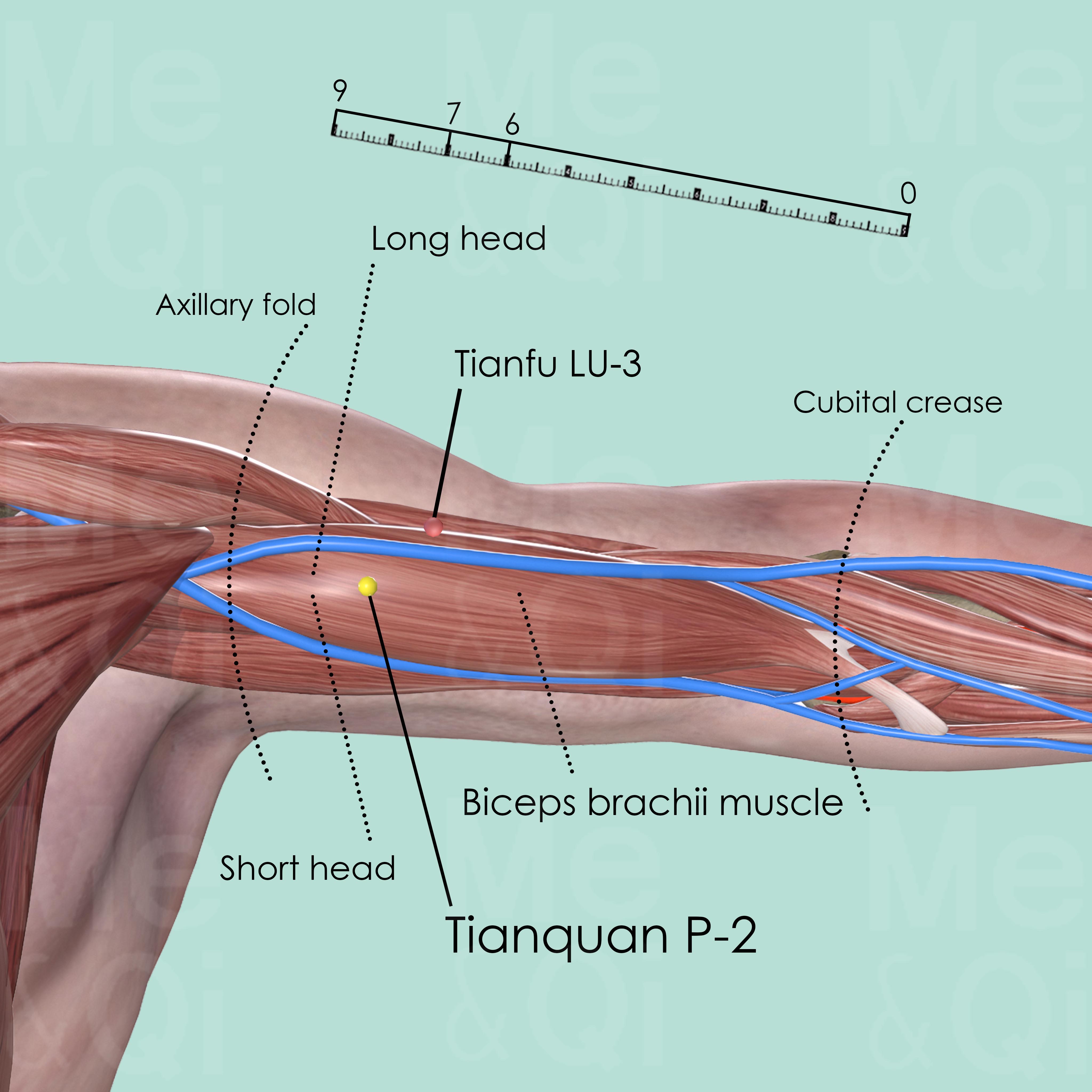
Tianquan P-2
2 cun below the end of the anterior axillary fold, between the two heads of biceps brachii muscle.
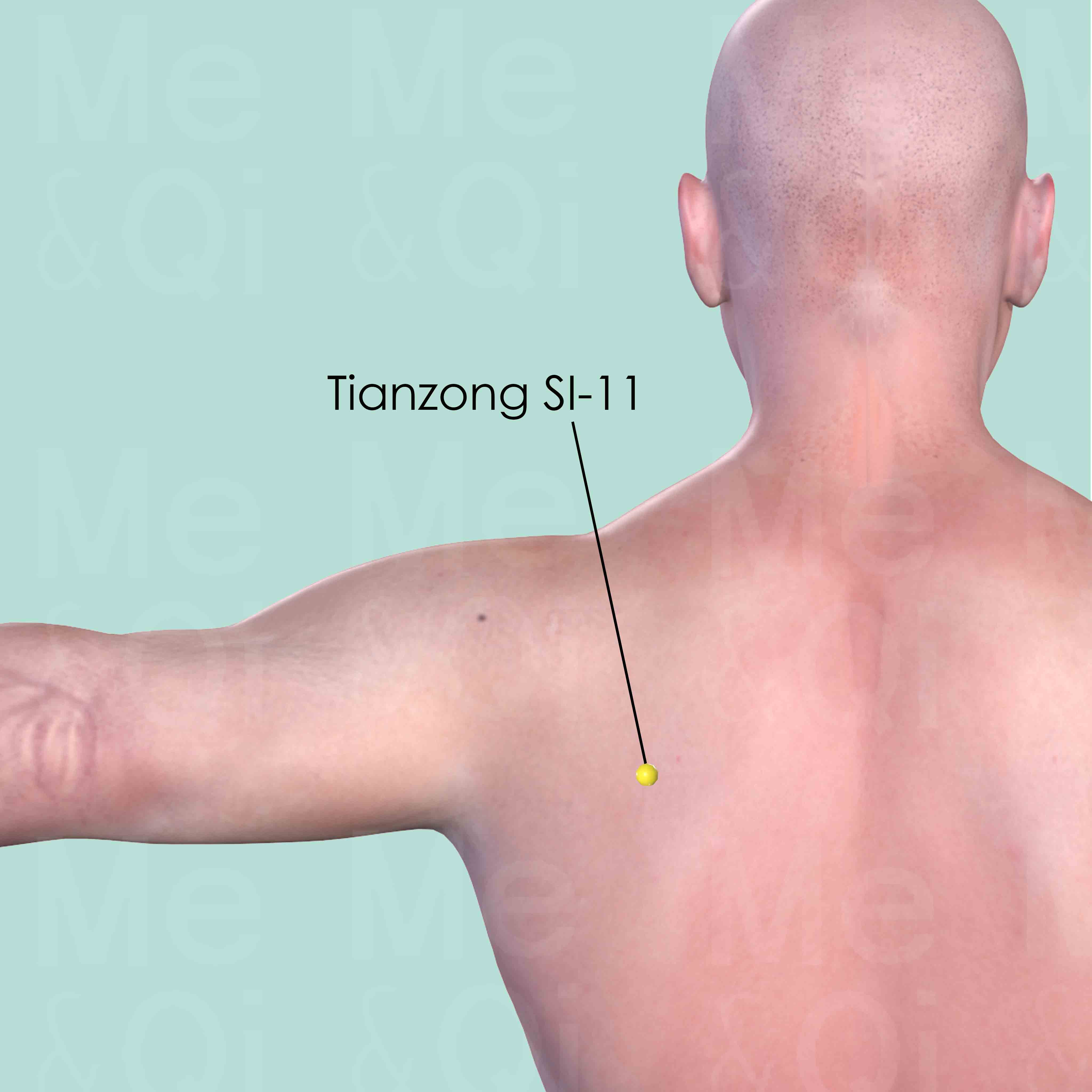
Tianzong SI-11
In the intrascapular fossa, at the junction of the upper and middle third of the distance between the lower border of the scapular spine and the inferior angle of the scapula.
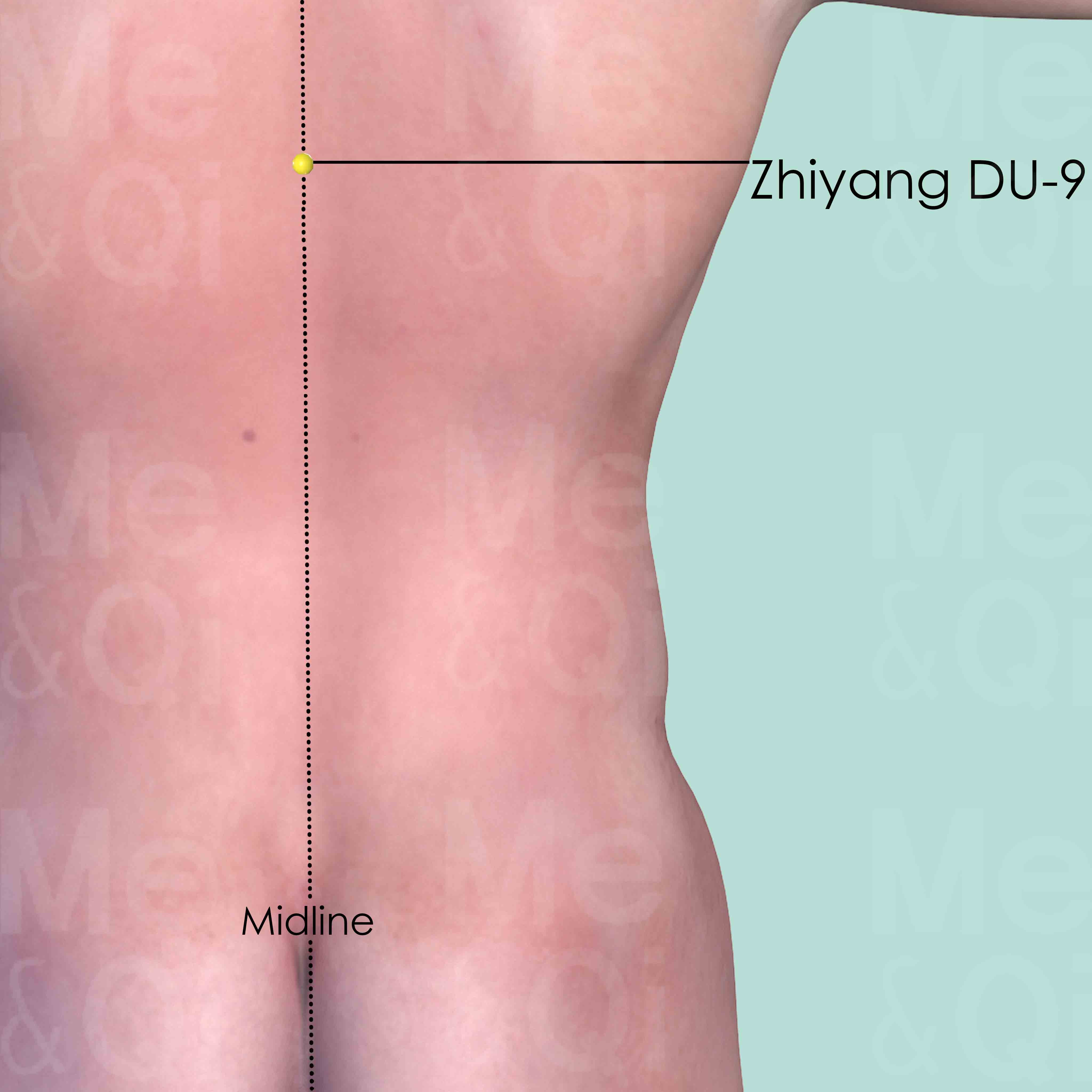
Zhiyang DU-9
On the back midline, in the depression below the spinous process of the 7th thoracic vertebra (T7).

